News Archive

Please see the homepage for the most recent news.
Centurion part of team that captures groundbreaking ‘molecular movie’
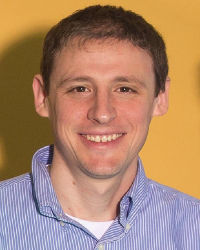 Nebraska physicist Martin Centurion was part of an international research team that created an animated movie showing how molecules are structurally changed by light for the first time. Centurion said that the minute-long “molecular movie” is an important step in confirming theoretical predictions with actual experiments; “What will come out of our research is a better understanding and more accurate models of molecular reactions triggered by light.”
(6/13/24)
Nebraska physicist Martin Centurion was part of an international research team that created an animated movie showing how molecules are structurally changed by light for the first time. Centurion said that the minute-long “molecular movie” is an important step in confirming theoretical predictions with actual experiments; “What will come out of our research is a better understanding and more accurate models of molecular reactions triggered by light.”
(6/13/24)
L-shaped metamaterials can control light direction and identify, sort molecules
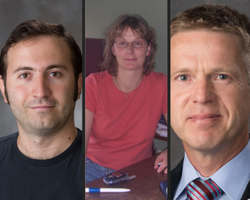 Using metamaterials, a team of electrical engineering researchers from Penn State and the University of Nebraska-Lincoln College of Engineering created an ultrathin optical element that can control the direction of polarized electromagnetic light waves. This new control allows researchers to not only direct the light's chirality, but also to identify the chirality of molecules by determining how polarized light interacts with them.
Using metamaterials, a team of electrical engineering researchers from Penn State and the University of Nebraska-Lincoln College of Engineering created an ultrathin optical element that can control the direction of polarized electromagnetic light waves. This new control allows researchers to not only direct the light's chirality, but also to identify the chirality of molecules by determining how polarized light interacts with them.
Identifying the chirality of molecules can reveal critical information about how they will interact with other systems, such as whether specific drugs will help heal diseased or damaged tissue without harming healthy cells. The researchers' findings were published in the May 4 edition of Nature Communications. Christos Argyropoulos co-authored the paper with former Nebraska ECE colleagues including Eva Franke-Schubert and Mathias Schubert.
(6/3/24)
Dowben to be editor-in-chief of Journal of Physics: Condensed Matter
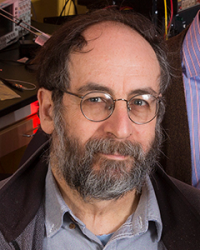 Peter Dowben, Charles Bessey Professor in the Department of Physics, was selected to be editor-in-chief of the Journal of Physics: Condensed Matter, a peer-reviewed scientific journal published by IOP Publishing. He will lead an Editorial Board of international members who work across the journal's ten sections.
Dowben specializes in condensed matter and materials physics.
(6/3/24)
Peter Dowben, Charles Bessey Professor in the Department of Physics, was selected to be editor-in-chief of the Journal of Physics: Condensed Matter, a peer-reviewed scientific journal published by IOP Publishing. He will lead an Editorial Board of international members who work across the journal's ten sections.
Dowben specializes in condensed matter and materials physics.
(6/3/24)
Top Sponsored Awards, April 2024
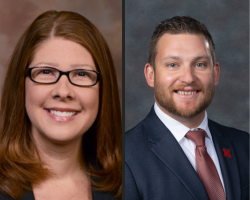 The following list includes all U.S.-issued patents granted by the U.S. Patent and Trademark Office to University of Nebraska-Lincoln researchers from March 16, 2024, and April 15, 2024, as reported by NUtech Ventures:
The following list includes all U.S.-issued patents granted by the U.S. Patent and Trademark Office to University of Nebraska-Lincoln researchers from March 16, 2024, and April 15, 2024, as reported by NUtech Ventures:
Angie Pannier, A. Ramer-Tait, $394,365, National Institutes of Health-National Center for Advancing Translational Sciences, Developing Outer Membranes Vesicles from Commensal Gut Bacteria as an Oral Gene Delivery Platform
Eric Markvicka, $691,771, NSF, CAREER: Universal Strategy for Manufacturing Solid Particle-Incorporated Liquid Metal Mixtures
(6/3/24)
Nebraska Women in STEM profile Shireen Adenwalla
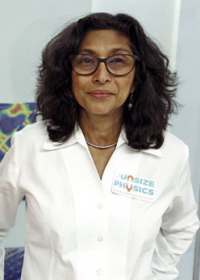 Nebraska Women in STEM recently talked to Dr. Shireen Adenwalla, professor of physics and astronomy, about her career in the male-dominated field of physics. Adenwalla describes discovering and falling in love with physics as an eighth-grader, her first encounters with sexism at a co-ed college, and the challenges she's faced as a professional in the field. "Her advice for students considering a science career is to 'not worry too much about what other people think of you. I would worry more about doing the work in front of you, and that work can be your homework or your quizzes. Go work for someone in a lab. It is so much fun, you’ll never look back.'"
(5/10/24)
Nebraska Women in STEM recently talked to Dr. Shireen Adenwalla, professor of physics and astronomy, about her career in the male-dominated field of physics. Adenwalla describes discovering and falling in love with physics as an eighth-grader, her first encounters with sexism at a co-ed college, and the challenges she's faced as a professional in the field. "Her advice for students considering a science career is to 'not worry too much about what other people think of you. I would worry more about doing the work in front of you, and that work can be your homework or your quizzes. Go work for someone in a lab. It is so much fun, you’ll never look back.'"
(5/10/24)
Top Sponsored Awards, March 2024
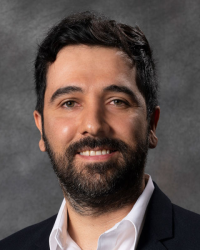 The following list includes all U.S.-issued patents granted by the U.S. Patent and Trademark Office to University of Nebraska-Lincoln researchers from Feb. 16, 2024, and March 15, 2024, 2024, as reported by NUtech Ventures:
The following list includes all U.S.-issued patents granted by the U.S. Patent and Trademark Office to University of Nebraska-Lincoln researchers from Feb. 16, 2024, and March 15, 2024, 2024, as reported by NUtech Ventures:
Arman Roohi, $679,831, National Science Foundation,
CAREER: Elastic Intermittent Computation Enabling Batteryless Edge Intelligence
(5/6/24)
Markvicka earns CAREER award
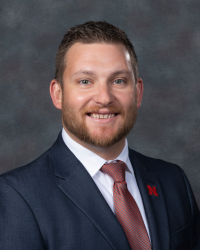 Eric Markvicka, assistant professor of mechanical and materials engineering, has earned a five-year, $690,000 grant from the National Science Foundation’s Faculty Early Career Development Program to advance his work on new soft matter composites that mimic biological tissue for use in soft robotics and 4D printing. It would be the first manufacturing strategy to yield stable mixtures of liquid metals with a wide range of solid particle additives to achieve enhanced properties — including thermal and electrical conductivity, fluidity, and capacity for self-repair — that exceed anything on today’s market.
(4/29/24)
Eric Markvicka, assistant professor of mechanical and materials engineering, has earned a five-year, $690,000 grant from the National Science Foundation’s Faculty Early Career Development Program to advance his work on new soft matter composites that mimic biological tissue for use in soft robotics and 4D printing. It would be the first manufacturing strategy to yield stable mixtures of liquid metals with a wide range of solid particle additives to achieve enhanced properties — including thermal and electrical conductivity, fluidity, and capacity for self-repair — that exceed anything on today’s market.
(4/29/24)
Turner group uncovers ways to improve railcar roller bearing safety, strength
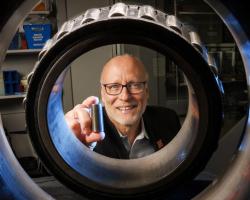 Joseph Turner, Robert W. Brightfelt Professor of Mechanical Engineering, said the first-ever 3D-printed rollers for railroad bearings exceeded expectations, creating a starting point for expanding the use of this innovative process that could help to make transportation even safer. Their results were compiled into a paper — “Fatigue Performance of Bearing Rollers Manufactured by Laser Powder Bed Fusion” — that was published in the ASTM Special Technical Publication on Bearing and Transmission Steels Technology.
(4/23/24)
Joseph Turner, Robert W. Brightfelt Professor of Mechanical Engineering, said the first-ever 3D-printed rollers for railroad bearings exceeded expectations, creating a starting point for expanding the use of this innovative process that could help to make transportation even safer. Their results were compiled into a paper — “Fatigue Performance of Bearing Rollers Manufactured by Laser Powder Bed Fusion” — that was published in the ASTM Special Technical Publication on Bearing and Transmission Steels Technology.
(4/23/24)
NCMN faculty receive promotion, tenure
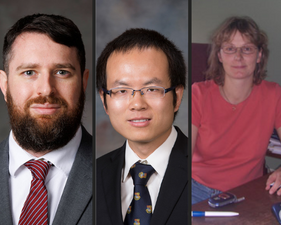 The University of Nebraska-Lincoln will award promotion and/or tenure to the following NCMN faculty in 2024: Keegan J. Moore, Mechanical and Materials Engineering - Promoted to Associate Professor and Granted Tenure; Bai Cui, Mechanical and Materials Engineering - Promoted to Professor; Eva Schubert, Electrical and Computer Engineering - Promoted to Professor.
(4/15/24)
The University of Nebraska-Lincoln will award promotion and/or tenure to the following NCMN faculty in 2024: Keegan J. Moore, Mechanical and Materials Engineering - Promoted to Associate Professor and Granted Tenure; Bai Cui, Mechanical and Materials Engineering - Promoted to Professor; Eva Schubert, Electrical and Computer Engineering - Promoted to Professor.
(4/15/24)
Centurion earns professorship
 Martin Centurion has been named a Carl A. Happold Professor of Physics and Astronomy. A professorship is the highest academic award that the university can bestow on a faculty member. Professorships recognize either distinguished scholarship or creative activity, a sustained record of teaching excellence and national visibility for instructional activities/practice, or significant contributions in research and teaching and exceptional promise for future excellence.
(4/9/24)
Martin Centurion has been named a Carl A. Happold Professor of Physics and Astronomy. A professorship is the highest academic award that the university can bestow on a faculty member. Professorships recognize either distinguished scholarship or creative activity, a sustained record of teaching excellence and national visibility for instructional activities/practice, or significant contributions in research and teaching and exceptional promise for future excellence.
(4/9/24)
Top Sponsored Awards, February 2024
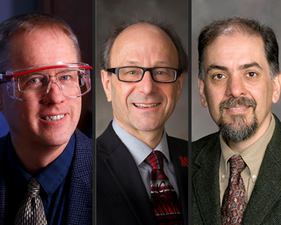 The following list includes all U.S.-issued patents granted by the U.S. Patent and Trademark Office to University of Nebraska-Lincoln researchers from Jan. 16 and Feb. 15, 2024, as reported by NUtech Ventures:
The following list includes all U.S.-issued patents granted by the U.S. Patent and Trademark Office to University of Nebraska-Lincoln researchers from Jan. 16 and Feb. 15, 2024, as reported by NUtech Ventures:
David Hage, David Berkowitz, $798,269, NSF, New Approaches to Catalyst Screening and Development
Mehrdad Negahban, $225,298, NSF, Collaborative Research: Predicting Long-time Behavior of Polymer Glasses: Alternatives to the TNM/KAHR Approach
(3/29/24)
Accolades, March 2024
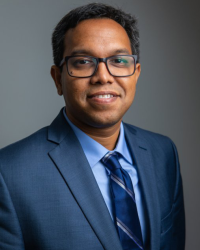 Nirupam Aich, civil and environmental engineering, and his research group recently published an article, “Influence of Water Chemistry and Operating Parameters on PFOS/PFOA removal using rGO-nZVI nanohybrid,” in the Journal of Hazardous Materials. The paper discusses the development of a novel nanomaterial for capturing and destroying “forever chemicals” from the water. These chemicals, called per- and poly-fluoroalkyl substances, are a major threat to global public health because of their high toxicity. In the paper, Aich’s team showed how water properties, including pH, salt concentration, and the presence of natural organic matter and oxidant and PFAS concentration, affect PFAS removal using an adsorptive/catalytic nanomaterial. The study lays the groundwork for designing materials for PFAS treatment and removal from water.
(3/28/24)
Nirupam Aich, civil and environmental engineering, and his research group recently published an article, “Influence of Water Chemistry and Operating Parameters on PFOS/PFOA removal using rGO-nZVI nanohybrid,” in the Journal of Hazardous Materials. The paper discusses the development of a novel nanomaterial for capturing and destroying “forever chemicals” from the water. These chemicals, called per- and poly-fluoroalkyl substances, are a major threat to global public health because of their high toxicity. In the paper, Aich’s team showed how water properties, including pH, salt concentration, and the presence of natural organic matter and oxidant and PFAS concentration, affect PFAS removal using an adsorptive/catalytic nanomaterial. The study lays the groundwork for designing materials for PFAS treatment and removal from water.
(3/28/24)
Ciftci, Cheung work highlighted for earning patents
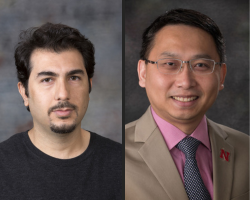 In a recent report from the National Academy of Inventors, the NU system ranks 73rd worldwide after earning 46 U.S. utility patents in 2023. Husker-led patents earned include Ozan Ciftci and Barry Chin Li Cheung's awards. Ciftci, associate professor of engineering, is using organic processing of lipids to produce and improve novel food products. The work includes the future development of 3D-printed foods that can meet individualized nutritional needs. Cheung, associate professor of chemistry, is focused on multiple applications of cerium oxide. His most recent patent is for a novel procedure that produces nanoparticles that can be used in gas sensors, optical devices, ultraviolet radiation blockers, and glass polishers.
(3/15/24)
In a recent report from the National Academy of Inventors, the NU system ranks 73rd worldwide after earning 46 U.S. utility patents in 2023. Husker-led patents earned include Ozan Ciftci and Barry Chin Li Cheung's awards. Ciftci, associate professor of engineering, is using organic processing of lipids to produce and improve novel food products. The work includes the future development of 3D-printed foods that can meet individualized nutritional needs. Cheung, associate professor of chemistry, is focused on multiple applications of cerium oxide. His most recent patent is for a novel procedure that produces nanoparticles that can be used in gas sensors, optical devices, ultraviolet radiation blockers, and glass polishers.
(3/15/24)
Nebraska-developed quantum sensing technique could facilitate advances in multiple fields
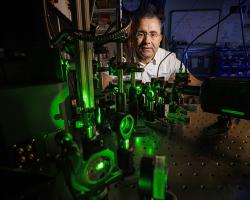 Two papers recently published outline how research teams in Abdelghani Laraoui's lab are using a quantum sensing technique his lab developed that could lead to significant breakthroughs in data transport technologies and disease treatment. The first paper, “Mapping of Spin-Wave Transport in Thulium Iron Garnet Thin Films Using Diamond Quantum Microscopy,” was published in Advanced Electronic Materials and shows how the team made the first documented measurements of how surface spin waves propagate in thin films of thulium iron garnet (TmIG). The second paper, "Nitrogen-Vacancy Magnetic Relaxometry of Nanocluster Cytochrome C Proteins," published in Nano Letters, shows how researchers used the nitrogen-vacancy layer as a quantum sensor to more accurately assess the performance of cytochrome C (Cyt-C) nanoclusters, which are water-soluble proteins that play a vital role in electron transport chains of mitochondria.
(3/12/24)
Two papers recently published outline how research teams in Abdelghani Laraoui's lab are using a quantum sensing technique his lab developed that could lead to significant breakthroughs in data transport technologies and disease treatment. The first paper, “Mapping of Spin-Wave Transport in Thulium Iron Garnet Thin Films Using Diamond Quantum Microscopy,” was published in Advanced Electronic Materials and shows how the team made the first documented measurements of how surface spin waves propagate in thin films of thulium iron garnet (TmIG). The second paper, "Nitrogen-Vacancy Magnetic Relaxometry of Nanocluster Cytochrome C Proteins," published in Nano Letters, shows how researchers used the nitrogen-vacancy layer as a quantum sensor to more accurately assess the performance of cytochrome C (Cyt-C) nanoclusters, which are water-soluble proteins that play a vital role in electron transport chains of mitochondria.
(3/12/24)
Unlocking the Future of Ammunition: Ordinal Munitions Technologies Embarks on a Lead-Free Revolution
 The Wichita-based startup Ordinal Munitions Technologies has completed its initial research phase in its quest for a lead-free alternative to ammunition primers. Utilizing the magnetron sputtering capabilities at the NNCI: Nebraska Nanoscale Facility (NNF), the company has successfully synthesized ignitable nanomaterials, which will be used for future characterization and testing. This initial research has laid the foundation for an upcoming submission of an NSF Small Business Innovation Research (SBIR) Phase I proposal, scheduled later this year. The company's founders share an unwavering belief in the transformative potential of nanomaterials for combustion applications in both the civilian and military markets.
(3/6/24)
The Wichita-based startup Ordinal Munitions Technologies has completed its initial research phase in its quest for a lead-free alternative to ammunition primers. Utilizing the magnetron sputtering capabilities at the NNCI: Nebraska Nanoscale Facility (NNF), the company has successfully synthesized ignitable nanomaterials, which will be used for future characterization and testing. This initial research has laid the foundation for an upcoming submission of an NSF Small Business Innovation Research (SBIR) Phase I proposal, scheduled later this year. The company's founders share an unwavering belief in the transformative potential of nanomaterials for combustion applications in both the civilian and military markets.
(3/6/24)
Top Sponsored Awards, January 2024
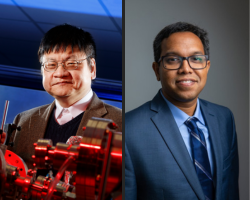 The following list includes all U.S.-issued patents granted by the U.S. Patent and Trademark Office to University of Nebraska-Lincoln researchers from Oct. 1, 2023, to Dec. 31, 2023, as reported by NUtech Ventures:
The following list includes all U.S.-issued patents granted by the U.S. Patent and Trademark Office to University of Nebraska-Lincoln researchers from Oct. 1, 2023, to Dec. 31, 2023, as reported by NUtech Ventures:
Yongfeng Lu, $1,625,000, University of Rochester, Fabrication and Verification of Fuel Targets for Laser Fusion Research
C. Ray, Nirupam Aich, X. Li, D. Snow, $278,969, Department of Interior-Geological Survey, Release, Adsorption, and Biotransformation of Biosolid-Borne PFAAs at the Water-Sediment Interface in Agricultural Watersheds
(3/4/24)
NPR features Gay’s solution to football physics conundrum
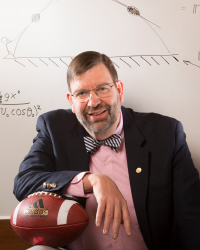 Leading up to Super Bowl LVIII, the University of Nebraska–Lincoln’s Tim Gay was featured on a Feb. 7 episode of NPR’s “Short Wave” podcast that delved into a longtime mystery of football physics he helped explain: On a deep, well-thrown pass, why does the front tip of a football follow the ball’s trajectory, so that it points upward when launched but downward by the time it reaches a receiver?
(2/14/24)
Leading up to Super Bowl LVIII, the University of Nebraska–Lincoln’s Tim Gay was featured on a Feb. 7 episode of NPR’s “Short Wave” podcast that delved into a longtime mystery of football physics he helped explain: On a deep, well-thrown pass, why does the front tip of a football follow the ball’s trajectory, so that it points upward when launched but downward by the time it reaches a receiver?
(2/14/24)
New material design for transistors could downsize next-gen tech
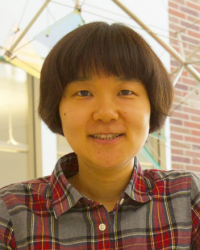 By better taming the Jekyll-and-Hyde nature of an alternative to the semiconductor — one that transitions from electricity-resisting insulator to current-conducting metal — Nebraska’s Xia Hong and colleagues may have unlocked a new path to smaller, more efficient digital devices. The team reported its findings in the journal Nature Communications.
(2/14/24)
By better taming the Jekyll-and-Hyde nature of an alternative to the semiconductor — one that transitions from electricity-resisting insulator to current-conducting metal — Nebraska’s Xia Hong and colleagues may have unlocked a new path to smaller, more efficient digital devices. The team reported its findings in the journal Nature Communications.
(2/14/24)
Top Sponsored Awards, December 2023
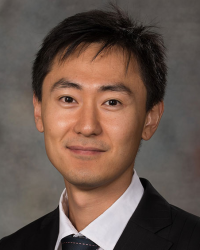 The following list includes all U.S.-issued patents granted by the U.S. Patent and Trademark Office to University of Nebraska-Lincoln researchers from Nov. 16 and Dec. 15, 2023, as reported by NUtech Ventures:
The following list includes all U.S.-issued patents granted by the U.S. Patent and Trademark Office to University of Nebraska-Lincoln researchers from Nov. 16 and Dec. 15, 2023, as reported by NUtech Ventures:
Seunghee Kim, $290,078, National Science Foundation-Established Program to Stimulate Competitive Research,
RII Track-4: NSF: Fundamental Study on Hydrogen Flow in Porous Media during Repetitive Drainage-Imbibition Processes and Upscaling for Underground Energy Storage
(2/7/24)
EQUATE-funded paper makes cover of Advanced Physics Research
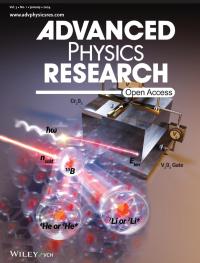 Energy-efficient, fast, and non-volatile memory is the apogee of antiferromagnetic spintronics. The cover page shows a device that utilizes an antiferromagnetic, B-doped thin film of magnetoelectric Cr2O3. Voltage applied across the film controls its Néel vector and state variable. To facilitate high-temperature operation, the Néel temperature, TN, of B:Cr2O3 is tuned. In the article by Ather Mahmood, Christian Binek, and colleagues, cold neutron and x-ray photoemission (XPS) data show that annealing leads to interfacial B-accumulation and TN increase. Neutron and XPS depth profiling map the depth-dependent B-concentration. (From Advanced Physics Research)
(1/30/24)
Energy-efficient, fast, and non-volatile memory is the apogee of antiferromagnetic spintronics. The cover page shows a device that utilizes an antiferromagnetic, B-doped thin film of magnetoelectric Cr2O3. Voltage applied across the film controls its Néel vector and state variable. To facilitate high-temperature operation, the Néel temperature, TN, of B:Cr2O3 is tuned. In the article by Ather Mahmood, Christian Binek, and colleagues, cold neutron and x-ray photoemission (XPS) data show that annealing leads to interfacial B-accumulation and TN increase. Neutron and XPS depth profiling map the depth-dependent B-concentration. (From Advanced Physics Research)
(1/30/24)
Top Sponsored Awards, November 2023
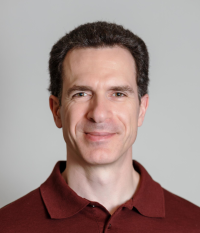 The following list includes all U.S.-issued patents granted by the U.S. Patent and Trademark Office to University of Nebraska-Lincoln researchers from Oct. 16 and Nov. 15, 2023, as reported by NUtech Ventures:
The following list includes all U.S.-issued patents granted by the U.S. Patent and Trademark Office to University of Nebraska-Lincoln researchers from Oct. 16 and Nov. 15, 2023, as reported by NUtech Ventures:
Kirill Belashchenko, $325,675, Purdue University, DMREF: GOALI: Designing Materials for Next-generation Spintronic Devices
(1/10/24)
From fashion design to threat mitigation, Lai creates adaptable biosensor strips
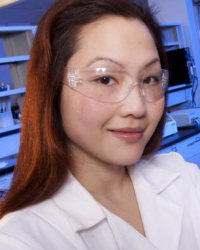 Rebecca Lai, professor of chemistry, and her team are developing versatile sensors for detecting a wide range of materials in a range of microscopic sizes, from incredibly small metal ions to larger particles such as spores.
Rebecca Lai, professor of chemistry, and her team are developing versatile sensors for detecting a wide range of materials in a range of microscopic sizes, from incredibly small metal ions to larger particles such as spores.
“We’re using the same design principle behind glucose test strips to look for other targets—biological agents like botulinum, drinking water contaminants like mercury and many others,” Lai explained. “Think about the impact of nitrate, for example—a big contaminant, especially in agricultural regions. To mitigate nitrate in water, we first must detect it.”
(12/11/23)
Top Sponsored Awards, October 2023
 The following list includes all U.S.-issued patents granted by the U.S. Patent and Trademark Office to University of Nebraska-Lincoln researchers from Sept. 16 and Oct. 15, 2023, as reported by NUtech Ventures:
The following list includes all U.S.-issued patents granted by the U.S. Patent and Trademark Office to University of Nebraska-Lincoln researchers from Sept. 16 and Oct. 15, 2023, as reported by NUtech Ventures:
Nirupam Aich,
$491,627,
NSF,
CAREER: 3D Printed Carbon-Metal Nanohybrid Aerogels for Highly Efficient Adsorptive/Catalytic Removal of PFASs
Ruiguo Yang,
$1,879,902,
National Institutes of Health-National Institute of General Medical Sciences,
Direct and Quantitative Probing of Desmosome Mechanotransduction
Abdelghani Laraoui,
$240,000,
Wichita State University,
ExpandQISE: Track 1: Understanding and Controlling Decoherence in Hybrid Spin Qubit-magnon Systems for Advancing Education and Building Workforce in Emerging Quantum Technologies
(12/1/23)
Engineering researchers develop new understanding of plant cells
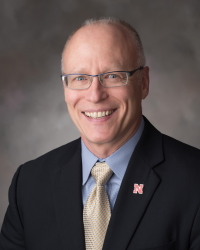 A new technique employed in the Nano-Engineering Research Core Facility (NERCF) has allowed researchers to understand better how plant cells respond to environmental changes to control the flow of gases and water vapor.
In a paper published in the National Academy of Science’s journal PNAS Nexus, Nebraska’s Joseph Turner, Robert W. Brightfelt Professor of Mechanical and Materials Engineering, and colleagues were able to quantify the anisotropic mechanical properties and interior cell pressure of a cell using a novel approach.
When inserting the tip of a nanoindenter into the guard cells of a weed known as thale cress, researchers were able to move it vertically and laterally. Turner said this allowed for taking measurements in all directions, which proved a major breakthrough in the research and set a foundation for comparing plants. “The most exciting part of this research is that for the first time, we were able to capture the stomatic process in-plane. That was something no one had measured before,” Turner said.
(11/13/23)
A new technique employed in the Nano-Engineering Research Core Facility (NERCF) has allowed researchers to understand better how plant cells respond to environmental changes to control the flow of gases and water vapor.
In a paper published in the National Academy of Science’s journal PNAS Nexus, Nebraska’s Joseph Turner, Robert W. Brightfelt Professor of Mechanical and Materials Engineering, and colleagues were able to quantify the anisotropic mechanical properties and interior cell pressure of a cell using a novel approach.
When inserting the tip of a nanoindenter into the guard cells of a weed known as thale cress, researchers were able to move it vertically and laterally. Turner said this allowed for taking measurements in all directions, which proved a major breakthrough in the research and set a foundation for comparing plants. “The most exciting part of this research is that for the first time, we were able to capture the stomatic process in-plane. That was something no one had measured before,” Turner said.
(11/13/23)
U.S. Issued Patents, July-Sept. 2023
 The following list includes all U.S.-issued patents granted by the U.S. Patent and Trademark Office to University of Nebraska-Lincoln researchers from July 1, 2023, to Sept. 30, 2023, as reported by NUtech Ventures:
The following list includes all U.S.-issued patents granted by the U.S. Patent and Trademark Office to University of Nebraska-Lincoln researchers from July 1, 2023, to Sept. 30, 2023, as reported by NUtech Ventures:
Substrate Delivery of Embedded Liposomes; Srivatsan Kidambi, Stephen L. Hayward;
11,752,219
Brush-Arm Star Polymer Imaging Agents and Uses Thereof; Andrzej Rajca, Jeremiah Johnson, Hung VanThanh Nguyen;
11,752,221
Magnetoelectric Xnor Logic Gate Device;
Andrew Marshall, Peter A. Dowben, Nishtha Sharma, Dmitri E. Nikonov; 11,757,449
Magnetoelectric Majority Gate Device; Andrew Marshall, Peter A. Dowben, Nishtha Sharma, Dmitri E. Nikonov
11,761,618
(11/10/23)
Accolades, October 2023
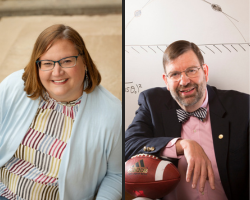 Shannon Bartelt-Hunt, civil and environmental engineering, was named a fellow of the American Society of Civil Engineers. Fellows have made celebrated contributions and developed creative solutions that change lives worldwide. This prestigious honor is held by 3% of ASCE members. Bartelt-Hunt’s research focuses on the physicochemical fate of contaminants in agroecosystems, contaminant fate and transport in landfills, and water reuse in agricultural systems.
Shannon Bartelt-Hunt, civil and environmental engineering, was named a fellow of the American Society of Civil Engineers. Fellows have made celebrated contributions and developed creative solutions that change lives worldwide. This prestigious honor is held by 3% of ASCE members. Bartelt-Hunt’s research focuses on the physicochemical fate of contaminants in agroecosystems, contaminant fate and transport in landfills, and water reuse in agricultural systems.
Tim Gay, physics and astronomy, contributed to a documentary that recently won a regional Emmy from the National Academy of Television Arts and Sciences. The documentary, “The Immaculate Reception: How a Last-Second Heave Led to One of the NFL’s Biggest Controversies,” commemorates the 50th anniversary of the Pittsburgh Steelers’ iconic game-winning play from the perspective of their opponents, the then-Oakland Raiders. Gay helped craft the script and features prominently in the documentary, explaining some relevant physics to a group of Raiders who competed in the fateful playoff game.
(11/10/23)
Top Sponsored Awards, September 2023
 The following list of awards from public entities includes grants of $200,000 or more between Aug. 16 and Sept. 15, 2023, as reported through NUgrant:
The following list of awards from public entities includes grants of $200,000 or more between Aug. 16 and Sept. 15, 2023, as reported through NUgrant:
David Hage, Barry Cheung, E. Harris, W. Niu, Angela Pannier; $478,072; National Science Foundation; MRI: Track 1 Acquisition of SEC/FFF-MALS-DLS
Jongwan Eun, $635,820, National Science Foundation, CAREER: Multi-physical and Multi-scale Testing and Modeling of Water Infiltration through Frozen Soils
A. Khattak, C. Nelson, Joe Turner; $300,000; University of Texas-Rio Grande Valley; UTRGV UTC: Nebraska Rail Safety Research
Eli Sutter, Peter Sutter; $542,870; NSF; Atomistic Control over Functional Defects in van der Waals Nanostructures
Bai Cui, Yongfeng Lu; $600,000; Department of Defense-Air Force Office of Scientific Research; Nanoscale Energy Coupling and Material Behaviors in Selective Laser Sintering of Ultra-High Temperature Ceramics
Arman Roohi, $533,880, NSF, CSR: Small: Cross-Layer Solutions Enabling Instant Computing for Edge Intelligence Devices
(11/10/23)
Dishari seeking greener energy by researching plant polymers
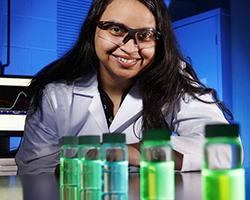 Shudipto Dishari, the Ross McCollum associate professor of chemical and biomolecular engineering, has recently begun work on research utilizing plant-based materials that could revolutionize the way electrochemical devices transport charge-bearing ions and produce electricity.
“This project will uniquely valorize the remnants of corn harvest and Christmas trees and provide source material for a new polymer, which will be eco-friendly, cheap, and efficient,” Dishari said, “Through this work, we are also bringing a new concept in energy research — green energy by using green materials.”
(11/3/23)
Shudipto Dishari, the Ross McCollum associate professor of chemical and biomolecular engineering, has recently begun work on research utilizing plant-based materials that could revolutionize the way electrochemical devices transport charge-bearing ions and produce electricity.
“This project will uniquely valorize the remnants of corn harvest and Christmas trees and provide source material for a new polymer, which will be eco-friendly, cheap, and efficient,” Dishari said, “Through this work, we are also bringing a new concept in energy research — green energy by using green materials.”
(11/3/23)
Morin, Yang team craft adjustable arrays of microscopic lenses
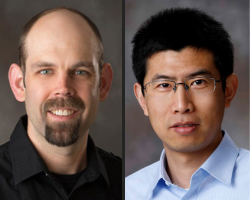 With the aid of engineers Ruiguo Yang and Grayson Minnick, Stephen Morin’s team can now arrange and affix tiny gelatinous lenses to an elastic material. By carving the equivalent of aqueducts into the material and then running temperature-altering or water-gathering fluids through those channels, the researchers can also expand or contract the lenses in mere seconds — modifying their magnification, focal length, and other optical properties. Whereas insects and crustaceans evolved their multifaceted eyes to draw in panoramas of ancient environments, Morin’s team is envisioning the future: projecting signals onto sensors embedded in soft robotic skins, for instance, via on-demand control.
(11/2/23)
With the aid of engineers Ruiguo Yang and Grayson Minnick, Stephen Morin’s team can now arrange and affix tiny gelatinous lenses to an elastic material. By carving the equivalent of aqueducts into the material and then running temperature-altering or water-gathering fluids through those channels, the researchers can also expand or contract the lenses in mere seconds — modifying their magnification, focal length, and other optical properties. Whereas insects and crustaceans evolved their multifaceted eyes to draw in panoramas of ancient environments, Morin’s team is envisioning the future: projecting signals onto sensors embedded in soft robotic skins, for instance, via on-demand control.
(11/2/23)
Research aims to improve recycled concrete for construction, carbon sequestration
 University of Nebraska researchers are studying the economic and practical feasibility of using recycled concrete as a building material and as a source of carbon sequestration. Waste concrete can be crushed and processed into a material known as recycled concrete aggregate (RCA) and reused in construction, but it’s weaker than original concrete.
Earlier research by Seunghee Kim, associate professor of civil and environmental engineering and one of the team leads, has found RCA can be strengthened through a process called carbonation: calcium hydroxide and calcium silicate hydrate, both found in concrete, can react with carbon dioxide to form a compound called calcium carbonate, which strengthens the RCA.
Because concrete absorbs carbon dioxide, the gas is captured within the calcium carbonate and permanently stored there.
(11/2/23)
University of Nebraska researchers are studying the economic and practical feasibility of using recycled concrete as a building material and as a source of carbon sequestration. Waste concrete can be crushed and processed into a material known as recycled concrete aggregate (RCA) and reused in construction, but it’s weaker than original concrete.
Earlier research by Seunghee Kim, associate professor of civil and environmental engineering and one of the team leads, has found RCA can be strengthened through a process called carbonation: calcium hydroxide and calcium silicate hydrate, both found in concrete, can react with carbon dioxide to form a compound called calcium carbonate, which strengthens the RCA.
Because concrete absorbs carbon dioxide, the gas is captured within the calcium carbonate and permanently stored there.
(11/2/23)
Laraoui team put big chill on quantum computing to eliminate 'noise'
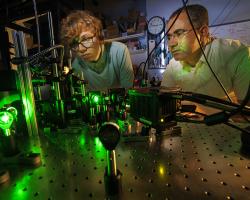 By looking to create quieter environments, a team led by Nebraska Engineering researcher Abdelghani Laraoui hopes to take a bit of the “noise” out of quantum computing and help make emerging technology more efficient, accessible, and feasible. The goal is to find materials that show potential for improving the performance of quantum computers, which can be utilized to control the disruptions – also known as decoherence (or noise) – that keep these superfast computers from performing at their best. Unlike classic computing systems, quantum computers have no memory or processors but instead use superconductive subatomic qubits, which store and process information and are ideal for higher-level tasks – such as running simulations and analyzing data – with superfast speed and precision. But, Laraoui said, quantum computers often need an extremely cold environment around 10 mK (equivalent to – 459 Fahrenheit) to perform well with lower error rates. Laraoui is collaborating with Wichita State University researchers on a three-year, $800,000 Track 1 award from the National Science Foundation’s Expand Capacity in Quantum Information Science and Engineering (ExpandQISE) program.
(11/1/23)
By looking to create quieter environments, a team led by Nebraska Engineering researcher Abdelghani Laraoui hopes to take a bit of the “noise” out of quantum computing and help make emerging technology more efficient, accessible, and feasible. The goal is to find materials that show potential for improving the performance of quantum computers, which can be utilized to control the disruptions – also known as decoherence (or noise) – that keep these superfast computers from performing at their best. Unlike classic computing systems, quantum computers have no memory or processors but instead use superconductive subatomic qubits, which store and process information and are ideal for higher-level tasks – such as running simulations and analyzing data – with superfast speed and precision. But, Laraoui said, quantum computers often need an extremely cold environment around 10 mK (equivalent to – 459 Fahrenheit) to perform well with lower error rates. Laraoui is collaborating with Wichita State University researchers on a three-year, $800,000 Track 1 award from the National Science Foundation’s Expand Capacity in Quantum Information Science and Engineering (ExpandQISE) program.
(11/1/23)
14 NCMN faculty earn 2023 Service Award
 Service Awards at Nebraska are a celebration of the talent and dedication of all regular employees who complete intervals of five calendar years of service. Fourteen NCMN faculty members received an award on October 27 at the 2023 Celebration of Service.
Service Awards at Nebraska are a celebration of the talent and dedication of all regular employees who complete intervals of five calendar years of service. Fourteen NCMN faculty members received an award on October 27 at the 2023 Celebration of Service.
- 5 years: Eric Markvicka and Keegan Moore (both Mechanical and Materials Engineering)
- 10 years: Alexey Kovalev (Physics), Stephen Morin (Chemistry), Xiaoshan Xu (Physics)
- 15 years: Yusong Li (Civil and Environmental Engineering)
- 20 years: Christian Binek (Physics, NCMN)
- 25 years: Eveline Baesu (Mechanical and Materials Engineering)
- 30 years: Peter Downben and Tim Gay (both Physics)
- 35 years: Patrick Dussault (Chemistry), Sy-Hwang Liou (Physics), James Takacs (Chemistry)
- 40 years: Kamlakar Rajurkar (Mechanical and Materials Engineering)
Sutters seek to ‘tune’ new avenues in nanowires
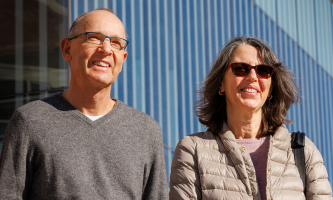 For decades, scientists working on semiconductors have believed defects are harmful to electronic materials. This is especially the case with dislocations, a class of imperfections that cause an abrupt change in the arrangement of atoms along a line in a crystal. In an article published in the Journal of the American Chemical Society, Peter and Eli Sutter and colleague Raymond Unocic from Oak Ridge National Lab outline their discovery of a materials synthesis method that can control the placement and types of dislocations that can optimize the specific advantages these imperfections offer.
(10/18/23)
For decades, scientists working on semiconductors have believed defects are harmful to electronic materials. This is especially the case with dislocations, a class of imperfections that cause an abrupt change in the arrangement of atoms along a line in a crystal. In an article published in the Journal of the American Chemical Society, Peter and Eli Sutter and colleague Raymond Unocic from Oak Ridge National Lab outline their discovery of a materials synthesis method that can control the placement and types of dislocations that can optimize the specific advantages these imperfections offer.
(10/18/23)
Bartelt-Hunt to give Nebraska Lecture, "Our Water, Our Health"
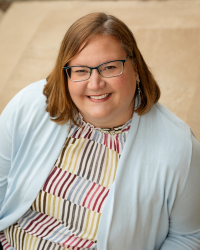 Researchers and public health officials found they could monitor the prevalence of COVID-19 in a community by analyzing wastewater. They’re now applying those lessons to tracking other health concerns. Shannon Bartelt-Hunt, Donald R. Voelte Jr. and Nancy A. Keegan Chair of civil engineering, will be delivering her Nebraska Lecture, "Our Water, Our Health" on November 9 at 3:30 p.m. She will discuss the many ways our water supply and health are interconnected; “There are these emerging contaminants in our water. We also call them trace contaminants — things that are just present at really low levels in water but can potentially have some health impacts,” Bartelt-Hunt said.
(10/2/23)
Researchers and public health officials found they could monitor the prevalence of COVID-19 in a community by analyzing wastewater. They’re now applying those lessons to tracking other health concerns. Shannon Bartelt-Hunt, Donald R. Voelte Jr. and Nancy A. Keegan Chair of civil engineering, will be delivering her Nebraska Lecture, "Our Water, Our Health" on November 9 at 3:30 p.m. She will discuss the many ways our water supply and health are interconnected; “There are these emerging contaminants in our water. We also call them trace contaminants — things that are just present at really low levels in water but can potentially have some health impacts,” Bartelt-Hunt said.
(10/2/23)
Top Sponsored Awards, August 2023
 The following awards from public entities include grants of $200,000 or more between July 16 and Aug. 15, 2023, as reported through NUgrant:
The following awards from public entities include grants of $200,000 or more between July 16 and Aug. 15, 2023, as reported through NUgrant:
Seunghee Kim, Jiong Hu, E. Thompson, $805,138, Department of Energy, Resource Assessment for Carbon Dioxide Storage via Accelerated Carbonation Reaction with Recycled Concrete Aggregates (RCA)
Seunghee Kim, T. Mieno, R. Saha, D. Schachtman, S. Taghvaeian, $2,101,812, NSF-EPSCoR, Collaborative Research: RII Track-2 FEC: Supporting Rural Livelihoods in the Water-Stressed Central High Plains: Microbial Innovations for Climate-Resilient Agriculture (MICRA)
S. Bhardwaj, Mathias Schubert, $379,921, NSF, Semiconductor-based Terahertz Traveling Wave Amplifiers for Monolithic Integration
Mathias Schubert, $901,250, Department of Defense-Air Force Office of Scientific Research, Field-flattened Optical-access Split-coil Cryostat Magnet for THz EPR Ellipsometry
P. Grover, Keegan Moore, $599,065, Department of Defense-Air Force Office of Scientific Research, Foundations of Defect Engineering for Dynamic Manipulation of Nonlinear Large-amplitude Waves in Metamaterials
Joe Turner, $352,565, NSF, Collaborative Research: Cellular and Biomechanical Mechanisms of Rapid Stomatal Dynamics in Grasses
Evgeny Tsymbal, $339,579, NSF, Collaborative Research: Spin Transport in Nonrelativistically Spin-split Antiferromagnets
Arman Roohi, $399,972, NSF, Collaborative Research: SaTC: CORE: Medium: Security and Robustness for Intermittent Computing Using Cross-Layer Post-CMOS Approaches
(10/2/23)
EQUATE-funded paper selected for PRB Editors' Suggestion
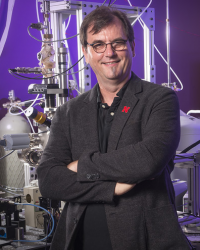 A paper published in Physical Review B by Christian Binek and colleagues Syed Q.A. Shah, Ather Mahmood, and Arun Parthasarathy was selected as an Editors' Suggested article in August 2023. The paper, "Search for magnetoelectric monopole response in Cr2O3 powder," was funded in part by the NSF/EPSCoR RII Track-1: Emergent Quantum Materials and Technologies, OIA-2044049.
(9/28/23)
A paper published in Physical Review B by Christian Binek and colleagues Syed Q.A. Shah, Ather Mahmood, and Arun Parthasarathy was selected as an Editors' Suggested article in August 2023. The paper, "Search for magnetoelectric monopole response in Cr2O3 powder," was funded in part by the NSF/EPSCoR RII Track-1: Emergent Quantum Materials and Technologies, OIA-2044049.
(9/28/23)
Binek represents Nebraska at first Nanotechnology Infrastructure Leaders Summit
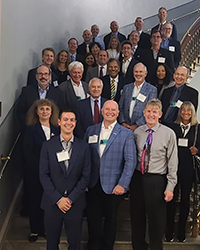 Christian Binek was in attendance at a first-of-its-kind gathering of infrastructure center leaders from across the country. The Nanotechnology Infrastructure Leaders Summit, held at the Eisenhower Executive Office Building in Washington, D.C., was an important first step toward creating a more cohesive network of U.S. shared infrastructure facilities, optimizing the efficiency and impact of attending organizations, and creating a more seamless network for the country's researchers, students, and entrepreneurs.
(9/27/23)
Christian Binek was in attendance at a first-of-its-kind gathering of infrastructure center leaders from across the country. The Nanotechnology Infrastructure Leaders Summit, held at the Eisenhower Executive Office Building in Washington, D.C., was an important first step toward creating a more cohesive network of U.S. shared infrastructure facilities, optimizing the efficiency and impact of attending organizations, and creating a more seamless network for the country's researchers, students, and entrepreneurs.
(9/27/23)
Bartelt-Hunt selected for 2023-25 NU DEAL fellowship program
 Shannon Bartelt-Hunt, chair, Department of Civil and Environmental Engineering, is one of 16 NU colleagues who have been selected to participate in a system-wide program that aims to develop the next generation of higher education leaders. NU’s “Developing Excellence in Academic Leaders” program, sponsored by the Office of the President together with the system provost and campus chief academic officers, offers an intensive two-year curriculum that helps participants develop their leadership skills, expand their networks, and explore key issues and challenges facing the University of Nebraska and higher education.
(9/25/23)
Shannon Bartelt-Hunt, chair, Department of Civil and Environmental Engineering, is one of 16 NU colleagues who have been selected to participate in a system-wide program that aims to develop the next generation of higher education leaders. NU’s “Developing Excellence in Academic Leaders” program, sponsored by the Office of the President together with the system provost and campus chief academic officers, offers an intensive two-year curriculum that helps participants develop their leadership skills, expand their networks, and explore key issues and challenges facing the University of Nebraska and higher education.
(9/25/23)
Dishari paper earns first place at ASEE Midwest Section Conference
 Shudipto Dishari, associate professor of chemical and biomolecular engineering, and graduate students Oghenetega Obewhere, Karen Acurio Cerda, and Rajesh Keloth, earned the first place award in the full paper category at the ASEE Midwest Section Conference, held in September in Lincoln. The paper, “Implementing a Virtual STEM Camp for Middle- and High Schoolers in a Post-COVID Climate Leveraging Prior Experience,” explored how Dishari and fellow researchers conducted outreach to children to improve STEM literacy.
(9/25/23)
Shudipto Dishari, associate professor of chemical and biomolecular engineering, and graduate students Oghenetega Obewhere, Karen Acurio Cerda, and Rajesh Keloth, earned the first place award in the full paper category at the ASEE Midwest Section Conference, held in September in Lincoln. The paper, “Implementing a Virtual STEM Camp for Middle- and High Schoolers in a Post-COVID Climate Leveraging Prior Experience,” explored how Dishari and fellow researchers conducted outreach to children to improve STEM literacy.
(9/25/23)
Dishari investigating lignin for use in new antimicrobials
 Shudipto Dishari’s research is investigating how lignin, a naturally abundant polymer and a major element of plant cell walls, could be processed to make new antimicrobials. Her team’s findings, outlined in the American Chemical Society’s Sustainable Chemistry and Engineering journal, are promising, and the work is now featured by the journal as a supplemental cover story. In this work, Dishari’s team modified lignin from Norway spruce trees with quaternary ammonium, a positively charged functional group used to kill bacteria, viruses and mold. The modification was done in water which ensured green synthesis. The team then tested this lignin-derived antimicrobial, named QAL, on an antibiotic-resistant strain of E. coli causing urinary tract infections. The positively charged groups of QAL made it easy for the lignin to attack and disrupt the outer skin of bacteria which is net negatively charged.
“While antibiotic-resistant bacteria are smart enough to save themselves from the action of conventional drugs, they cannot protect themselves from the non-specific effects that QAL makes,” Dishari said.
(9/14/23)
Shudipto Dishari’s research is investigating how lignin, a naturally abundant polymer and a major element of plant cell walls, could be processed to make new antimicrobials. Her team’s findings, outlined in the American Chemical Society’s Sustainable Chemistry and Engineering journal, are promising, and the work is now featured by the journal as a supplemental cover story. In this work, Dishari’s team modified lignin from Norway spruce trees with quaternary ammonium, a positively charged functional group used to kill bacteria, viruses and mold. The modification was done in water which ensured green synthesis. The team then tested this lignin-derived antimicrobial, named QAL, on an antibiotic-resistant strain of E. coli causing urinary tract infections. The positively charged groups of QAL made it easy for the lignin to attack and disrupt the outer skin of bacteria which is net negatively charged.
“While antibiotic-resistant bacteria are smart enough to save themselves from the action of conventional drugs, they cannot protect themselves from the non-specific effects that QAL makes,” Dishari said.
(9/14/23)
Berkowtiz and colleagues awarded $24.5M contract to develop acute radiation syndrome prophylactic
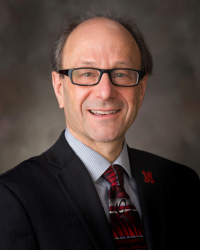 David Berkowitz is the co-PI on a research project aimed at developing a prophylactic to help protect U.S. troops from the effects of acute radiation syndrome. ARS is caused by exposure to high levels of radiation, which could result from a dirty bomb terrorist attack, nuclear accident or nuclear weapons incident. To launch the next steps of this important work, the Defense Health Agency has awarded a $24.5 million contract to NSRI, the Department of Defense University Affiliated Research Center of U.S. Strategic Command and the University of Nebraska system. This is the third DHA contract for this work and brings the project to more than $35 million in funding since 2017. Patrick Dussault is also working on this research, acting as medicinal chemistry lead.
(9/14/23)
David Berkowitz is the co-PI on a research project aimed at developing a prophylactic to help protect U.S. troops from the effects of acute radiation syndrome. ARS is caused by exposure to high levels of radiation, which could result from a dirty bomb terrorist attack, nuclear accident or nuclear weapons incident. To launch the next steps of this important work, the Defense Health Agency has awarded a $24.5 million contract to NSRI, the Department of Defense University Affiliated Research Center of U.S. Strategic Command and the University of Nebraska system. This is the third DHA contract for this work and brings the project to more than $35 million in funding since 2017. Patrick Dussault is also working on this research, acting as medicinal chemistry lead.
(9/14/23)
EQUATE-funded paper published on back cover of Advanced Optical Materials
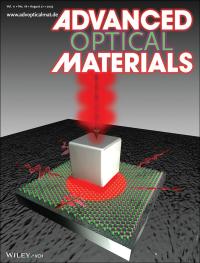 Abdelghani Laraoui and colleagues showed that when single photon emitters in thin hexagonal boron nitride flakes are brought in contact with silver nanocubes, their quantum properties are enhanced due to plasmonic effects, manifested by a decrease in their excited state lifetime, a narrowing of their spectra, and an increase of their fluorescence. The paper titled "Plasmon Enhanced Quantum Properties of Single Photon Emitters with Hybrid Hexagonal Boron Nitride Silver Nanocube Systems" was selected for the back cover of Advanced Optical Materials 11(16).
(9/13/23)
Abdelghani Laraoui and colleagues showed that when single photon emitters in thin hexagonal boron nitride flakes are brought in contact with silver nanocubes, their quantum properties are enhanced due to plasmonic effects, manifested by a decrease in their excited state lifetime, a narrowing of their spectra, and an increase of their fluorescence. The paper titled "Plasmon Enhanced Quantum Properties of Single Photon Emitters with Hybrid Hexagonal Boron Nitride Silver Nanocube Systems" was selected for the back cover of Advanced Optical Materials 11(16).
(9/13/23)
Kim leading team examining climate resiliency through soil
 An interdisciplinary team from Nebraska, Kansas State University and Langston University in Oklahoma will focus on three states where water stress is especially acute. As of October 2022, 100% of Oklahoma and Nebraska and 98.5% of Kansas were in drought. As drought conditions persist because of climate change, it’s expected farmers will have to irrigate more, and even with more irrigation, yields are expected to drop.
An interdisciplinary team from Nebraska, Kansas State University and Langston University in Oklahoma will focus on three states where water stress is especially acute. As of October 2022, 100% of Oklahoma and Nebraska and 98.5% of Kansas were in drought. As drought conditions persist because of climate change, it’s expected farmers will have to irrigate more, and even with more irrigation, yields are expected to drop.
“In regions with irrigation, more water will be needed under the hotter and drier conditions,” said Seunghee Kim, associate professor of civil engineering and the project’s lead investigator. “Preservation of soil moisture will therefore be a critical objective under rainfed and irrigated conditions.”
(9/7/23)
"Release of Micro- and Nanoplastics from Plastic Food Containers — Characterization, Risk Assessment, Socioeconomic and Health Impacts" project earns $1.36M award from Grand Challenges initiative
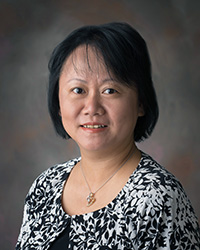 Research shows that plastic food containers used for food preparation, storage, and handling can leak micro- and nanoplastics directly into food — with potentially harmful health effects, especially for children and vulnerable populations. Husker engineer Yusong Li leads a team that will establish an interdisciplinary center for conducting cutting-edge scientific research on which plastics and use conditions are most likely to release toxic micro- and nanoparticles. Findings will help develop practical solutions for manufacturers and consumers and promote informed decision-making.
Research shows that plastic food containers used for food preparation, storage, and handling can leak micro- and nanoplastics directly into food — with potentially harmful health effects, especially for children and vulnerable populations. Husker engineer Yusong Li leads a team that will establish an interdisciplinary center for conducting cutting-edge scientific research on which plastics and use conditions are most likely to release toxic micro- and nanoparticles. Findings will help develop practical solutions for manufacturers and consumers and promote informed decision-making.
The aim is to produce evidence-based research that leads to healthier, more sustainable plastic food containers, plus recommendations for safe use of plastics. In addition to Li, the project involves six Nebraska faculty members, a University of Nebraska Medical Center collaborator, and a three-member advisory panel. Efforts are funded with a three-year, $1.36 million award from the Grand Challenges initiative.
(8/31/23)
"Quantum Approaches Addressing Global Threats" project earns $4.17M award from Grand Challenges initiative
 The world is facing daunting changes in the coming decades — and quantum science and engineering can offer solutions for helping humans adapt. Physicist Christian Binek and mathematician Susan Hermiller will lead a highly interdisciplinary team of 22 faculty that will leverage the rapidly growing field to address major global threats. The team has four focus areas: solutions to address the growing energy needs for communication and information processing, sustainable agriculture, achieving climate resilience, and quantum literacy and workforce development.
The world is facing daunting changes in the coming decades — and quantum science and engineering can offer solutions for helping humans adapt. Physicist Christian Binek and mathematician Susan Hermiller will lead a highly interdisciplinary team of 22 faculty that will leverage the rapidly growing field to address major global threats. The team has four focus areas: solutions to address the growing energy needs for communication and information processing, sustainable agriculture, achieving climate resilience, and quantum literacy and workforce development.
The project builds on Nebraska’s internationally recognized discoveries in materials, nanoscience, and emergent quantum materials and technologies. While the basis of the project is using quantum science to model, plan, predict, and engineer solutions to solve global problems, the team is incorporating diverse perspectives and unconventional problem-solving strategies to fully understand the challenges and opportunities. Faculty experts from mathematics, physics and astronomy, public relations, mechanical and materials engineering, electrical and computer engineering, computer science, chemistry, emerging media arts, and music have been fully integrated into the project, which received a five-year, $4.17 million award from the Grand Challenges initiative.
(8/30/23)
Sellmyer Fellows to follow legacy of legendary Husker physicist
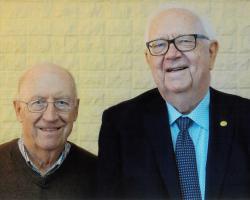 Small-scale interactions yielding greater-than-the-sum outcomes.
Small-scale interactions yielding greater-than-the-sum outcomes.
The same principle that defines condensed-matter physics — the professional passion and pursuit of the late David Sellmyer — continues to define the legacy of the Nebraska faculty member more than a year after his passing.
A lifetime of leadership and camaraderie, which included Sellmyer’s enduring friendship with fellow Husker professor John Woollam, would inspire the latter to establish an endowed graduate fellowship in the former’s name. This fall, several doctoral students in the Department of Physics and Astronomy will represent the inaugural cohort of David J. Sellmyer Fellows, receiving financial support to study the namesake’s favored field.
(8/16/23)
U.S.-Issued Patents, January-June 2023
 The following list includes U.S.-issued patents granted by the U.S. Patent and Trademark Office to NCMN researchers from Jan. 1 to June 30, 2023, as reported by NUtech Ventures:
The following list includes U.S.-issued patents granted by the U.S. Patent and Trademark Office to NCMN researchers from Jan. 1 to June 30, 2023, as reported by NUtech Ventures:
Robotic Surgical Devices, Systems and Related Methods, Shane M. Farritor, Dmitry Oleynikov, Ryan L. McCormick, Tyler Wortman, Eric Markvicka, 11,595,242
Ozone-Mediated Synthesis of Nanostructures, Barry Cheung, Anuja Bhalkikar, Christopher Mark Marin, Tamra Fisher, 11,577,956
Bioavailable Curcumin Nanoparticles and Methods of Making, Ozan Ciftci, 11,654,119
Magnetoelectric Inverter, Andrew Marshall, Peter A. Dowben, Nishtha Sharma, Dmitri E. Nikonov, 11,658,663
Systems for and Methods for Improving Mechanical Properties of Ceramic Material, Yongfeng Lu, Michael Nastasi, Bai Cui, Fei Wang, 11,667,581
(8/10/23)
Top Sponsored Awards, June 2023
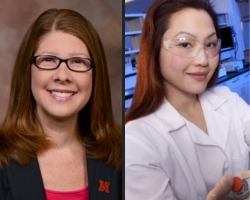 The following awards from public entities include grants of $200,000 or more between May 16 and June 15, 2023, as reported through NUgrant:
The following awards from public entities include grants of $200,000 or more between May 16 and June 15, 2023, as reported through NUgrant:
Angie Pannier, $217,932, Streck Inc., Streck MSA
Rebecca Lai, $438,280, National Strategic Research Institute, NSRI-DTECS
(8/10/23)
Engineering teams earn $1.2M in grants from DEPSCoR program
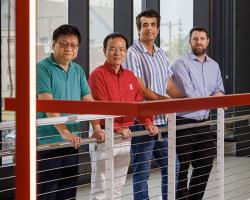 Three NCMN faculty are on teams that have received three-year, $600,00 grants from the Defense Established Program to Stimulate Competitive Research (DEPSCoR). The two projects were awarded through the Research Collaboration competition, which features teams led by faculty who have not previously received DoD research funding and collaborations with faculty who are veterans of recent DoD projects.
Three NCMN faculty are on teams that have received three-year, $600,00 grants from the Defense Established Program to Stimulate Competitive Research (DEPSCoR). The two projects were awarded through the Research Collaboration competition, which features teams led by faculty who have not previously received DoD research funding and collaborations with faculty who are veterans of recent DoD projects.
Bai Cui, Vernon McBroom Associate Professor of Mechanical and Materials Engineering, is looking to eliminate defects in 3D-printed ultra-high temperature ceramics that have superior strength and resistance to super-high temperatures. Cui is collaborating with Yongfeng Lu, Lott Distinguished Professor in electrical and computer engineering, who provides expertise in laser-material interactions. Lu’s research has included developing systems to prevent and repair corrosion on Navy ships.
Piyush Grover, assistant professor of mechanical and materials engineering, is purposefully introducing specific defects into structures to control the propagation of solitary waves and the mechanical energy they carry. Grover is collaborating with Keegan Moore, assistant professor of mechanical and materials engineering and a recipient of an Air Force Office of Scientific Research Young Investigator Research Program grant.
(7/25/23)
Batelaan named inaugural recipient of professorship
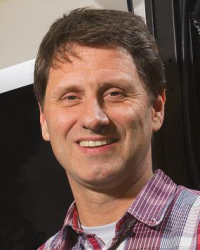 Herman Batelaan, professor in the Department of Physics and Astronomy, was named the inaugural Burton Evans Moore Professor of Physics. Professorships are one of the highest forms of recognition provided by the university. Selection is based on ability and accomplishments in teaching and research as well as academic purpose. Donor Burton Eberle Moore established this professorship to commemorate the life of his father, who was a professor in the department from 1905-1925.
(7/25/23)
Herman Batelaan, professor in the Department of Physics and Astronomy, was named the inaugural Burton Evans Moore Professor of Physics. Professorships are one of the highest forms of recognition provided by the university. Selection is based on ability and accomplishments in teaching and research as well as academic purpose. Donor Burton Eberle Moore established this professorship to commemorate the life of his father, who was a professor in the department from 1905-1925.
(7/25/23)
Hage earns international award for contributions to clinical chemistry
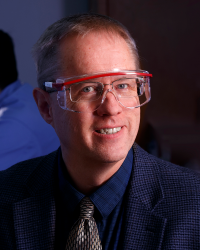 David Hage, James Hewett University Professor in the Department of Chemistry, received the 2023 Award for Distinguished Contributions in Education from the International Federation of Clinical Chemistry and Laboratory Medicine.
David Hage, James Hewett University Professor in the Department of Chemistry, received the 2023 Award for Distinguished Contributions in Education from the International Federation of Clinical Chemistry and Laboratory Medicine.
This award recognizes his teaching, work as a research mentor for students, and published textbooks and textbook chapters related to clinical chemistry and bioanalysis. He was nominated for this award by the American Association for Clinical Chemistry after receiving their Outstanding Contributions to Education in Clinical Chemistry award last year.
(7/25/23)
EQUATE teams develop process to better see into nanoscale
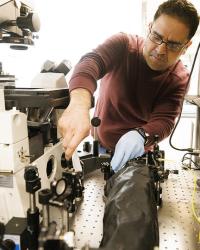 Two EQUATE-supported, multidisciplinary teams with many of the same researchers are developing processes that allow scientists to better see into the nanoscale and harness possibilities of the quantum realm. The two projects each had papers published in prestigious research journals in the same week of May.
Two EQUATE-supported, multidisciplinary teams with many of the same researchers are developing processes that allow scientists to better see into the nanoscale and harness possibilities of the quantum realm. The two projects each had papers published in prestigious research journals in the same week of May.
Researchers on the first team detail their novel technique using nitrogen vacancy-based magnetometry to study the magnetic properties of individual iron-triazole spin crossover nanorods and nanoparticle clusters; their paper was published in the May 9 edition of ACS Nano.
Researchers on the second team used an emerging, ultra-thin host material to increase the brightness of single-photon emitters by 200%; their paper was published in the May 3 edition of Advanced Optical Materials.
(7/20/23)
Dishari, Xu selected for ORED Research Leaders Program
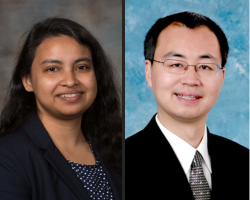 Shudipto Dishari, chemical and biomolecular engineering, and Xiaoshan Xu, physics and astronomy, are among 15 University of Nebraska-Lincoln faculty to be chosen for the 2023-24 cohort of the Office of Research and Economic Development's Research Leaders Porgam. The program aims to identify and develop Nebraska’s next generation of research leaders. These research-active faculty will learn the information, skills, and connections needed to assemble and lead teams pursuing major extramural funding.
(7/3/23)
Shudipto Dishari, chemical and biomolecular engineering, and Xiaoshan Xu, physics and astronomy, are among 15 University of Nebraska-Lincoln faculty to be chosen for the 2023-24 cohort of the Office of Research and Economic Development's Research Leaders Porgam. The program aims to identify and develop Nebraska’s next generation of research leaders. These research-active faculty will learn the information, skills, and connections needed to assemble and lead teams pursuing major extramural funding.
(7/3/23)
Top Sponsored Awards, May 2023
 The following awards from public entities include grants of $200,000 or more between April 16, and May 15, 2023, as reported through NUgrant:
The following awards from public entities include grants of $200,000 or more between April 16, and May 15, 2023, as reported through NUgrant:
Ravi Saraf, $360,000, Department of Defense-Army Research Office, Non-Invasive Electrophysiology Microbe
Shannon Bartelt-Hunt, D. Snow; $399,915; Nebraska Department of Environment and Energy; PFAS Monitoring
Eli Sutter, Peter Sutter; $512,976; Department of Defense-Army Research Office; Photodetectors
Keegan Moore, $727,410, National Science Foundation, CAREER: Foundation Evolution and Dynamic Nonlinearities
(6/30/23)
Nejati earns ORED Layman Award
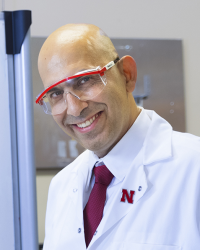 Siamek Nejati, chemical and biomolecular engineering, is one of 17 researchers chosen by the Office of Research and Economic Development (ORED) to receive funding through its Layman Awards program in 2023-24. The Awards help fund work that enhances a researcher’s ability to obtain external funding to support prominent scholarship. Nejati's project is titled "Design and development of a high-efficiency condenser for a multi-effect air gap membrane distillation module.”
(6/27/23)
Siamek Nejati, chemical and biomolecular engineering, is one of 17 researchers chosen by the Office of Research and Economic Development (ORED) to receive funding through its Layman Awards program in 2023-24. The Awards help fund work that enhances a researcher’s ability to obtain external funding to support prominent scholarship. Nejati's project is titled "Design and development of a high-efficiency condenser for a multi-effect air gap membrane distillation module.”
(6/27/23)
Kirby obituary published in Physics Today
 Physics Today honored the life and work of late physics professor Roger Kirby with the publication of his obituary. Kirby passed away at the age of 77 on January 31, 2020. He contributed greatly to the field of condensed-matter physics during his illustrious career, and he leaves behind a legacy of groundbreaking research and dedicated mentorship. His contributions to the university, the field of physics, and the lives of his students and colleagues will be remembered for years to come. Read the full obituary here.
(6/13/23)
Physics Today honored the life and work of late physics professor Roger Kirby with the publication of his obituary. Kirby passed away at the age of 77 on January 31, 2020. He contributed greatly to the field of condensed-matter physics during his illustrious career, and he leaves behind a legacy of groundbreaking research and dedicated mentorship. His contributions to the university, the field of physics, and the lives of his students and colleagues will be remembered for years to come. Read the full obituary here.
(6/13/23)
Moore unwinding causes, solutions to bolt loosening
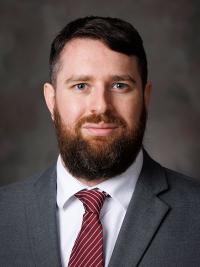 Keegan Moore, mechanical and materials engineering, is using his $727,410 NSF CAREER award to study the phenomena of bolts loosening over time. “Loose bolts aren’t just to blame for high-profile catastrophes; they’re a threat in everyday life, from playground equipment and cars to biomedical implants and the James Webb Space Telescope… Bolt and joint loosening has been studied since the Industrial Revolution because it’s been a problem since then,” Moore said. His research will focus on rotational loosening caused by vibrations in structures. He will use high-speed cameras to capture the interface contact conditions — the surfaces the bolts hold together.
(6/9/23)
Keegan Moore, mechanical and materials engineering, is using his $727,410 NSF CAREER award to study the phenomena of bolts loosening over time. “Loose bolts aren’t just to blame for high-profile catastrophes; they’re a threat in everyday life, from playground equipment and cars to biomedical implants and the James Webb Space Telescope… Bolt and joint loosening has been studied since the Industrial Revolution because it’s been a problem since then,” Moore said. His research will focus on rotational loosening caused by vibrations in structures. He will use high-speed cameras to capture the interface contact conditions — the surfaces the bolts hold together.
(6/9/23)
Top Sponsored Awards, April 2023
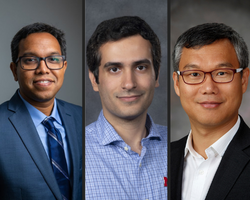 The following awards from public entities include grants of $200,000 or more between March 16 and April 15, 2023, as reported through NUgrant:
The following awards from public entities include grants of $200,000 or more between March 16 and April 15, 2023, as reported through NUgrant:
Nirupam Aich; $254,833; National Science Foundation;
Nanocomposite Membranes for PFAS Removal
Mohammad Ghashami; $629,702; NSF;
CAREER: Multi-Body Nanoscale Radiation
Sangjin Ryu; $294,217; NSF; IRES: Point-of-Care Testing Device
(6/2/23)
Bartelt-Hunt team receive Nebraska Champion for Engineering Award
 Shannon Bartelt-Hunt, George Hunt and Matthew Williamson, civil and environmental engineering, received the 2023 Nebraska Champion for Engineering Award from the American Council of Engineering Companies Nebraska. This award recognizes outstanding individuals and teams who have collaborated with the council to support the state’s engineering profession. The Husker trio was honored for its work to help ACEC NE launch the Let’s MEET – Mentoring Emerging Engineers Together program, which supports engineering students through their undergraduate years with mentoring and educational opportunities. Bartelt-Hunt, Hunt and Williamson liaised with Husker freshmen and sophomore engineering students and faculty and ACEC NE members to get MEET up and running.
(6/1/23)
Shannon Bartelt-Hunt, George Hunt and Matthew Williamson, civil and environmental engineering, received the 2023 Nebraska Champion for Engineering Award from the American Council of Engineering Companies Nebraska. This award recognizes outstanding individuals and teams who have collaborated with the council to support the state’s engineering profession. The Husker trio was honored for its work to help ACEC NE launch the Let’s MEET – Mentoring Emerging Engineers Together program, which supports engineering students through their undergraduate years with mentoring and educational opportunities. Bartelt-Hunt, Hunt and Williamson liaised with Husker freshmen and sophomore engineering students and faculty and ACEC NE members to get MEET up and running.
(6/1/23)
Wang named Brimacombe Medalist
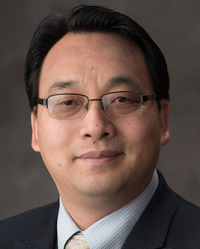 Jian Wang, mechanical and materials engineering, was named a Brimacombe Medalist by the Minerals, Metals and Materials Society. This is a mid-career award that recognizes individuals with sustained excellence and achievement in business, technology, education, public policy or science related to materials science and engineering, and with a record of continuing service to the profession. Wang was selected for outstanding service and contributions to the fundamental understanding of the mechanical behaviors of nanostructured metallic materials and hexagonal close-packed, or HCP, metals.
(5/8/23)
Jian Wang, mechanical and materials engineering, was named a Brimacombe Medalist by the Minerals, Metals and Materials Society. This is a mid-career award that recognizes individuals with sustained excellence and achievement in business, technology, education, public policy or science related to materials science and engineering, and with a record of continuing service to the profession. Wang was selected for outstanding service and contributions to the fundamental understanding of the mechanical behaviors of nanostructured metallic materials and hexagonal close-packed, or HCP, metals.
(5/8/23)
Top Sponsored Awards, March 2023
 The following awards from public entities include grants of $200,000 or more between Feb. 16 and March 15, 2023, as reported through NUgrant:
The following awards from public entities include grants of $200,000 or more between Feb. 16 and March 15, 2023, as reported through NUgrant:
C. Zuhlke, Christos Argyropoulos, G. Gogos, Ned Ianno, Jeff Shield;
$667,240;
Department of Defense-Office of Naval Research-Defense University Research Instrumentation Program;
DURIP High Power Laser
Eva Schubert, Christos Argyropoulos;
$567,000;
NSF;
Chiral Interactions with Metamaterials
(5/8/23)
Team IDs emergence of surprising layers in nanomaterial
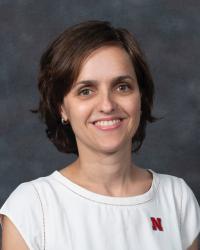 Lucía Fernández-Ballester and her team have observed never-before-seen intricacies of the crystallization of a polymer known as P3HT. By melting P3HT and watching it cool through the lenses of light and X-rays, the team discovered hidden depths that can solidify and crystallize in different ways, which can alter the transport of electric charges. The team reported its findings in the journal Macromolecules, which featured the study on the cover of its most recent issue.
(5/1/23)
Lucía Fernández-Ballester and her team have observed never-before-seen intricacies of the crystallization of a polymer known as P3HT. By melting P3HT and watching it cool through the lenses of light and X-rays, the team discovered hidden depths that can solidify and crystallize in different ways, which can alter the transport of electric charges. The team reported its findings in the journal Macromolecules, which featured the study on the cover of its most recent issue.
(5/1/23)
Kidambi, Lu named 2023 NSRI fellows
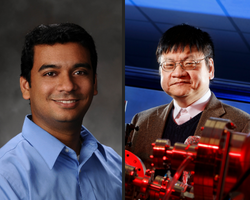 Srivatsan Kidambi, chemical and biomolecular engineering, and Yongfeng Lu, electrical and computer engineering, have been named to the 2023 cohort of the National Strategic Research Institute. The institute is a University-affiliated research center designated by the Department of Defense and sponsored by U.S. Strategic Command. More than 140 researchers across the NU system serve as NSRI fellows, contributing their expertise, talent, and foresight to form multidisciplinary teams that develop solutions for complex problems.
(4/26/23)
Srivatsan Kidambi, chemical and biomolecular engineering, and Yongfeng Lu, electrical and computer engineering, have been named to the 2023 cohort of the National Strategic Research Institute. The institute is a University-affiliated research center designated by the Department of Defense and sponsored by U.S. Strategic Command. More than 140 researchers across the NU system serve as NSRI fellows, contributing their expertise, talent, and foresight to form multidisciplinary teams that develop solutions for complex problems.
(4/26/23)
NCMN faculty receive promotion, tenure
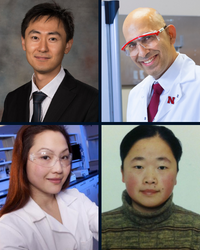 Four NCMN faculty members will receive promotion and/or tenure in 2023. Seunghee Kim, civil and environmental engineering, and Siamak Nejati, chemical and biomolecular engineering, were promoted to Associate Professor and granted tenure. Rebecca Lai, chemistry, is promoted to Full Professor. And Wen Qian, mechanical and materials engineering, is promoted to Research Associate Professor. Congratulations to all!
(4/19/22)
Four NCMN faculty members will receive promotion and/or tenure in 2023. Seunghee Kim, civil and environmental engineering, and Siamak Nejati, chemical and biomolecular engineering, were promoted to Associate Professor and granted tenure. Rebecca Lai, chemistry, is promoted to Full Professor. And Wen Qian, mechanical and materials engineering, is promoted to Research Associate Professor. Congratulations to all!
(4/19/22)
Ghashami looks to harness excess heat in next-gen nanoelectronics
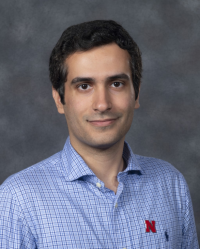 The tiny electronic parts and pieces situated within smartphones, laptops, and more can experience large amounts of excess heat through a process known as near-field thermal radiation. The University of Nebraska–Lincoln’s Mohammad Ghashami is studying this phenomenon in-depth, paving the way for strategies that would control and transform excess heat into an asset that could generate electricity, extend battery life and improve device efficiency.
(4/14/23)
The tiny electronic parts and pieces situated within smartphones, laptops, and more can experience large amounts of excess heat through a process known as near-field thermal radiation. The University of Nebraska–Lincoln’s Mohammad Ghashami is studying this phenomenon in-depth, paving the way for strategies that would control and transform excess heat into an asset that could generate electricity, extend battery life and improve device efficiency.
(4/14/23)
Aich aims to mitigate impact of "forever chemicals"
 NCMN's newest member, Nirupam Aich, civil and environmental engineering, has gained international attention for his research using nanomaterials in water treatment processes that could remove per- and poly-fluoroalkyl substances that don’t degrade easily.
NCMN's newest member, Nirupam Aich, civil and environmental engineering, has gained international attention for his research using nanomaterials in water treatment processes that could remove per- and poly-fluoroalkyl substances that don’t degrade easily.
“My research mainly focuses on advanced materials and advanced nanomaterials for water treatment. We look at different emerging contaminants, particularly PFAS, and how to remove them using nanotechnology and nanomaterials,” he said. “For environmental solutions, we want to make sure these nanomaterials don’t become a problem later, so that’s why we are making safer-by-design nanomaterials for water treatment and environmental limitation.”
(4/11/23)
Xu earns named professorship
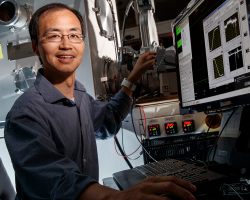 Xiaoshan Xu is one of nine professors awarded professorships from the Office of the Executive Vice Chancellor. Xu will be Susan J. Rosowski associate professor in physics and astronomy and in the Nebraska Center for Materials and Nanoscience. Xu conducts research on metal oxides with emphasis on quantum materials, particularly in ferroic materials involving quantum magnetism, ferroelectricity, and the magnetoelectric multiferroics.
(4/5/23)
Xiaoshan Xu is one of nine professors awarded professorships from the Office of the Executive Vice Chancellor. Xu will be Susan J. Rosowski associate professor in physics and astronomy and in the Nebraska Center for Materials and Nanoscience. Xu conducts research on metal oxides with emphasis on quantum materials, particularly in ferroic materials involving quantum magnetism, ferroelectricity, and the magnetoelectric multiferroics.
(4/5/23)
Accolades, March 2023
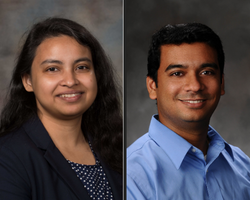 Shudipto Dishari, chemical and biomolecular engineering, received the Early Investigator Award from the American Chemical Society’s Division of Polymeric Materials: Science and Engineering. The award recognizes the professional accomplishments of early-career investigators who are emerging leaders in the field of polymer science and engineering across academia, industry, and national labs.
Shudipto Dishari, chemical and biomolecular engineering, received the Early Investigator Award from the American Chemical Society’s Division of Polymeric Materials: Science and Engineering. The award recognizes the professional accomplishments of early-career investigators who are emerging leaders in the field of polymer science and engineering across academia, industry, and national labs.
Srivatsan Kidambi, chemical and biomolecular engineering, was selected to join the 2023 Science Outside the Lab Program. The program focuses on the federal government’s relationship to science and technology, including the links between science, innovation, policy, and societal outcomes.
(4/5/23)
Dishari receives award from EVC office
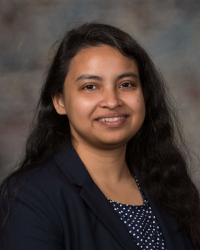 Shudipto Dishari, Chemical and Biomolecular Engineering, is one of 23 faculty and staff to receive an award from the Office of the Executive Vice Chancellor for 2023. Dishari was honored with a College Distinguished Teaching Award, which recognizes faculty with excellence in teaching.
(3/27/23)
Shudipto Dishari, Chemical and Biomolecular Engineering, is one of 23 faculty and staff to receive an award from the Office of the Executive Vice Chancellor for 2023. Dishari was honored with a College Distinguished Teaching Award, which recognizes faculty with excellence in teaching.
(3/27/23)
Cui praises NUtech workshop
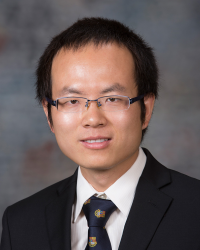 Bai Cui, R. Vernon McBroom Associate Professor of Mechanical and Materials Engineering, was one of many participants offering praise for the Business Model Canvas workshop hosted by NUtech Ventures. Cui, who is also co-founder of PromeMaterials LLC, said, “These workshops provide valuable opportunities for scientists such as me to learn more about how to convert research concepts into business ideas. The lectures in this workshop shared the most critical knowledge for beginners, and the class discussions helped me to refine my business plans. Also, the NUtech Ventures team has been supporting and encouraging me in the journey to commercializing some new material and manufacturing technologies developed from my lab, including 3D printing.”
(3/27/23)
Bai Cui, R. Vernon McBroom Associate Professor of Mechanical and Materials Engineering, was one of many participants offering praise for the Business Model Canvas workshop hosted by NUtech Ventures. Cui, who is also co-founder of PromeMaterials LLC, said, “These workshops provide valuable opportunities for scientists such as me to learn more about how to convert research concepts into business ideas. The lectures in this workshop shared the most critical knowledge for beginners, and the class discussions helped me to refine my business plans. Also, the NUtech Ventures team has been supporting and encouraging me in the journey to commercializing some new material and manufacturing technologies developed from my lab, including 3D printing.”
(3/27/23)
Dishari team developing polymers to boost hydrogen cell efficiency
 Shudipto Dishari, chemical and biomolecular engineering, is leading a research team that is designing polymers to find a solution to ion transport limitations in hydrogen fuel cells by making charge-bearing ions run faster across the cells. They aim to develop new, biological ion channel-inspired ionomers to boost the movement of those charges and improve the performance of clean energy technologies to meet the cost-performance-durability targets set by the Department of Energy.
(3/8/23)
Shudipto Dishari, chemical and biomolecular engineering, is leading a research team that is designing polymers to find a solution to ion transport limitations in hydrogen fuel cells by making charge-bearing ions run faster across the cells. They aim to develop new, biological ion channel-inspired ionomers to boost the movement of those charges and improve the performance of clean energy technologies to meet the cost-performance-durability targets set by the Department of Energy.
(3/8/23)
New technique yielding insights, potential inhibitors of disease-related enzyme
 A team led by David Berkowitz, Willa Cather Professor of chemistry, recently revealed a technique for recording the enzyme serine racemase in action, tracking its reactions, and screening for inhibitors that could influence its activity. The platform – which is also useful for studying other enzymes – will enable researchers to learn about serine racemase’s chemistry in detail and facilitates the hunt for potential pharmaceutical-grade inhibitors.
(3/6/23)
A team led by David Berkowitz, Willa Cather Professor of chemistry, recently revealed a technique for recording the enzyme serine racemase in action, tracking its reactions, and screening for inhibitors that could influence its activity. The platform – which is also useful for studying other enzymes – will enable researchers to learn about serine racemase’s chemistry in detail and facilitates the hunt for potential pharmaceutical-grade inhibitors.
(3/6/23)
Atom-thin walls could smash size, memory barriers in next-gen devices
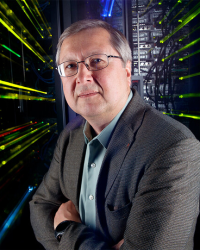 Evgeny Tsymbal and an international team have demonstrated how to construct, control and explain the oxygen-deprived walls of a nanoscopically thin material suited to next-gen electronics. These walls can talk in several electronic dialects that could allow the devices housing them to store even more data, and they can retain their data states even if their devices turn off. Tsymbal's team published its findings in the journal Nature.
Evgeny Tsymbal and an international team have demonstrated how to construct, control and explain the oxygen-deprived walls of a nanoscopically thin material suited to next-gen electronics. These walls can talk in several electronic dialects that could allow the devices housing them to store even more data, and they can retain their data states even if their devices turn off. Tsymbal's team published its findings in the journal Nature.
Top Sponsored Awards, December 2022
 The following awards from public entities include grants of $200,000 or more between Oct. 16 and Nov. 15, 2022, as reported through NUgrant:
The following awards from public entities include grants of $200,000 or more between Oct. 16 and Nov. 15, 2022, as reported through NUgrant:
Patrick Dussault (chemistry), R. Powers, T. Helikar; $659,073; University of Nebraska Medical Center; Further Development of 5-AED (Androstenediol, Neumune) for the Protection from Acute Radiation Syndrome (ARS)
(2/9/23)
Berkowitz featured on Molecular Moments podcast
 David Berkowitz, chemistry, was the featured guest on the Molecular Moments podcast on Jan. 6. He discussed his educational background, his involvement with the National Strategic Research Institute, his work with enzymes, how higher education has changed over the years and his participation in the Lincoln Marathon.
(2/9/23)
David Berkowitz, chemistry, was the featured guest on the Molecular Moments podcast on Jan. 6. He discussed his educational background, his involvement with the National Strategic Research Institute, his work with enzymes, how higher education has changed over the years and his participation in the Lincoln Marathon.
(2/9/23)
NRIC 2023: Topology & Valley-Driven Quantum Phenomena
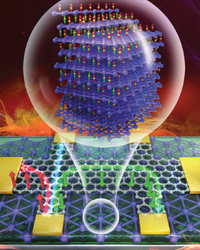 The 2023 Nebraska Research and Innovation Conference (NRIC) -- Topology
and Valley-Driven Quantum Phenomena -- will take place Friday, March 17, at the Embassy Suites
Hotel in downtown Lincoln. This all-day meeting includes invited speakers and poster sessions with EQUATE
student and post-doctoral researchers. The cost to attend this event is free, however, pre-registration is required.
(1/11/23)
The 2023 Nebraska Research and Innovation Conference (NRIC) -- Topology
and Valley-Driven Quantum Phenomena -- will take place Friday, March 17, at the Embassy Suites
Hotel in downtown Lincoln. This all-day meeting includes invited speakers and poster sessions with EQUATE
student and post-doctoral researchers. The cost to attend this event is free, however, pre-registration is required.
(1/11/23)
U.S.-Issued Patents, October-December 2022
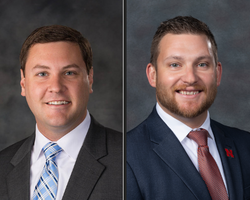 The following list includes
U.S.-issued patents granted by the U.S. Patent and Trademark Office to NCMN researchers from
Oct. 1, 2022, to Dec. 31, 2022, as reported by NUtech Ventures:
The following list includes
U.S.-issued patents granted by the U.S. Patent and Trademark Office to NCMN researchers from
Oct. 1, 2022, to Dec. 31, 2022, as reported by NUtech Ventures:
Hybrid Additive Manufacturing Method, Michael Sealy, Guru
Charan, Reddy Madireddy, Haitham Hadidi, Cody Kanger - 11,491,718
Single Site Robotic Device and Related Systems and Methods, Thomas Frederick, Shane M.
Farritor, Eric Markvicka, Joe Bartels, Jack Mondry -
11,529,201
(1/11/23)
Top Sponsored Awards, November 2022
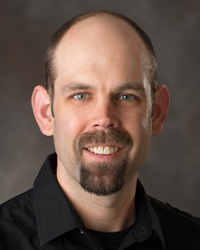 The
following awards from public entities include grants of $200,000 or more between Oct. 16 and
Nov. 15, 2022, as reported through NUgrant:
The
following awards from public entities include grants of $200,000 or more between Oct. 16 and
Nov. 15, 2022, as reported through NUgrant:
Stephen Morin, $478,683, Department of Defense-U.S. Army Research
Office, Powering Soft Actuators Directly with Small Molecule Fuels for Operational
Versatility
(1/11/23)
Nebraska engineers, national labs partner on energy-related research
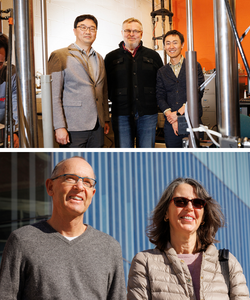 More than $1.4 million in funding from the U.S. Department of Energy will
allow two College of Engineering teams to expand innovative energy-related research in
partnership with national laboratories.
More than $1.4 million in funding from the U.S. Department of Energy will
allow two College of Engineering teams to expand innovative energy-related research in
partnership with national laboratories.
Jongwan Eun, associate professor of civil and environmental
engineering; Seunghee Kim, assistant professor of civil and
environmental engineering; and Yuris Dzenis, R. Vernon McBroom
Professor of mechanical and materials engineering, received $675,000 over three years to
investigate how inorganic microfibers can make a more resilient barrier material to improve the
long-term storage capabilities of vessels that contain high-level nuclear waste and spent
nuclear fuel.
Peter Sutter, professor of electrical and computer
engineering, and Eli Sutter, professor of mechanical and
materials engineering, received $747,387 over three years to study new classes of
semiconductors for use in photovoltaics and information processing. (1/3/23)
NU Annual Report: Reducing greenhouse gas emissions
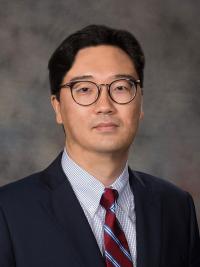 Jongwan Eun, associate professor of civil and environmental engineering, and
colleague Yunwoo Nam, associate professor of community and regional planning, are studying how
to remediate gas emissions from landfills with an innovative ground-covering system. They’re
using a cover made from an extruded geomembrane with an ethylene vinyl-alcohol layer sandwiched
between two inner, low-density polyethylene layers. The team is comparing this system in field
tests to traditional covering systems made of low-density polyethylene and no covering. Read
more about the project here. (12/13/22)
Jongwan Eun, associate professor of civil and environmental engineering, and
colleague Yunwoo Nam, associate professor of community and regional planning, are studying how
to remediate gas emissions from landfills with an innovative ground-covering system. They’re
using a cover made from an extruded geomembrane with an ethylene vinyl-alcohol layer sandwiched
between two inner, low-density polyethylene layers. The team is comparing this system in field
tests to traditional covering systems made of low-density polyethylene and no covering. Read
more about the project here. (12/13/22)
NU Annual Report: faculty earn CAREER Awards
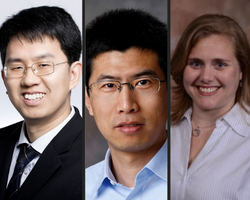 NCMN faculty made up three of
the seven Nebraska researchers to earn CAREER Awards in 2022. Wei Bao
is working to expand access to quantum simulators. Ruiguo
Yang is exploring cell-cell junctions and their link to human health. Nicole Iverson is using and developing nanosensors to detect disease. (12/13/22)
NCMN faculty made up three of
the seven Nebraska researchers to earn CAREER Awards in 2022. Wei Bao
is working to expand access to quantum simulators. Ruiguo
Yang is exploring cell-cell junctions and their link to human health. Nicole Iverson is using and developing nanosensors to detect disease. (12/13/22)
NU Annual Report: Markvicka named 2021 Innovator of the Year
 Eric Markvicka, assistant professor of
mechanical and materials engineering, is the Emerging Innovator of the Year for his robotics
research. By combining computer and materials science knowledge, Markvicka studies how
materials interact with the human body and the surrounding environment. His work has
applications for wearable medical devices, biosensors, soft robotics, and multifunctional
materials. The honor recognizes a researcher, often a junior faculty member, for recent
innovative contributions. (12/13/22)
Eric Markvicka, assistant professor of
mechanical and materials engineering, is the Emerging Innovator of the Year for his robotics
research. By combining computer and materials science knowledge, Markvicka studies how
materials interact with the human body and the surrounding environment. His work has
applications for wearable medical devices, biosensors, soft robotics, and multifunctional
materials. The honor recognizes a researcher, often a junior faculty member, for recent
innovative contributions. (12/13/22)
Top Sponsored Awards, October 2022
 The following awards from public
entities include grants of $200,000 or more between Sept. 16 and Oct. 15, 2022, as reported
through NUgrant:
The following awards from public
entities include grants of $200,000 or more between Sept. 16 and Oct. 15, 2022, as reported
through NUgrant:
EQUATE awards SEED grants
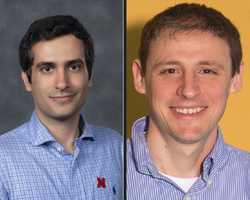 Mohammad Ghashami, mechanical and materials engineering, and Martin Centurion, physics and astronomy, were both recently awarded
SEED grants from the Emergent Quantum Materials and Technologies (EQUATE) project to study quantum topics in their work.
Centurion's project is titled: Characterization of the ultrafast structural response in
photoexcite materials. Ghashami's project is titled: Quantum Size Effect on Radiative and
Electronic Transport. (12/5/22)
Mohammad Ghashami, mechanical and materials engineering, and Martin Centurion, physics and astronomy, were both recently awarded
SEED grants from the Emergent Quantum Materials and Technologies (EQUATE) project to study quantum topics in their work.
Centurion's project is titled: Characterization of the ultrafast structural response in
photoexcite materials. Ghashami's project is titled: Quantum Size Effect on Radiative and
Electronic Transport. (12/5/22)
College of Engineering faculty honored with new named professorships
 This fall, four NCMN members from
the College of Engineering have been honored with named professorships. They join the ranks of
ten other faculty who have continuing professorships. Congratulations to all!
This fall, four NCMN members from
the College of Engineering have been honored with named professorships. They join the ranks of
ten other faculty who have continuing professorships. Congratulations to all!
Fall 2022 New Professorships
Scilight: Iron nanoparticles boost magnetocaloric effect
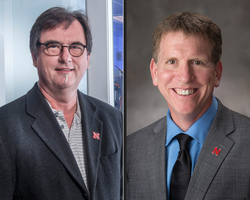 A paper authored by Chrisitan Binek, Jeff Shield, and colleagues
from North Carolina A&T (NCAT) was recently published in the Journal of Applied Physics. The
article "Large
refrigerant capacity in superparamagnetic iron nanoparticles embedded in a thin film
matrix" was also chosen by AIP's editors to be featured in a "Scilight" - a science
highlight showcasing the most interesting research published in AIP Publishing Journals.
NCAT was also recently awarded a $10 million grant from the Department of Energy to establish a
center focused on clean energy initiatives led by paper
co-author Dhananjay Kumar. (11/23/22)
A paper authored by Chrisitan Binek, Jeff Shield, and colleagues
from North Carolina A&T (NCAT) was recently published in the Journal of Applied Physics. The
article "Large
refrigerant capacity in superparamagnetic iron nanoparticles embedded in a thin film
matrix" was also chosen by AIP's editors to be featured in a "Scilight" - a science
highlight showcasing the most interesting research published in AIP Publishing Journals.
NCAT was also recently awarded a $10 million grant from the Department of Energy to establish a
center focused on clean energy initiatives led by paper
co-author Dhananjay Kumar. (11/23/22)
Ghashami, Wang selected for Neb. EPSCoR FIRST Awards
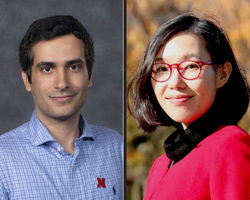 Mohammad Ghashami and Yanan Wang were
among the recipients of Nebraska EPSCoR's annual FIRST Awards. Funded by the National Science
Foundation's (NSF) infrastructure grant to Nebraska EPSCoR, the competitive FIRST Award grant
program assists Nebraska's early-career, tenure-track faculty. The grants are designed to help
early career faculty initiate their research programs and compete more effectively for NSF
CAREER grants. (11/23/22)
Mohammad Ghashami and Yanan Wang were
among the recipients of Nebraska EPSCoR's annual FIRST Awards. Funded by the National Science
Foundation's (NSF) infrastructure grant to Nebraska EPSCoR, the competitive FIRST Award grant
program assists Nebraska's early-career, tenure-track faculty. The grants are designed to help
early career faculty initiate their research programs and compete more effectively for NSF
CAREER grants. (11/23/22)
Pannier says ‘future is so bright’ for gene therapy
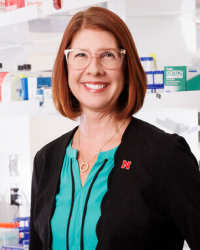 Angie Pannier, Swarts Family Chair of
Biological Systems Engineering, delivered the Nebraska Lecture on Nov. 17,
laying out the history of her field and both the challenges and promises ahead. “It’s an
exciting time to be in this field,” Pannier said. “It’s an exciting time to be a patient that
might have their life dramatically changed by these therapies.” (11/18/22)
Angie Pannier, Swarts Family Chair of
Biological Systems Engineering, delivered the Nebraska Lecture on Nov. 17,
laying out the history of her field and both the challenges and promises ahead. “It’s an
exciting time to be in this field,” Pannier said. “It’s an exciting time to be a patient that
might have their life dramatically changed by these therapies.” (11/18/22)
Watch
on YouTube
Teamwork by Hong and Schubert leads investigation of remote surface optical phonon scattering in ferroelectric oxide-gated graphene
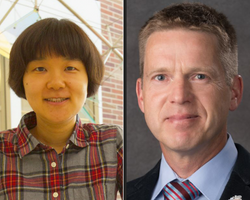 The October 2022 edition of
the Journal of Applied Physics features research from a collaboration led by Xia Hong and Mathias Schubert. Their study
reveals the room temperature mobility limit in graphene imposed by the ferroelectric oxide
gate, providing important material information for designing high-performance
ferroelectric/graphene transistors for high frequency, low power nanoelectronic applications.
Learn more at https://aip.scitation.org/doi/full/10.1063/5.0106939. (11/10/22)
The October 2022 edition of
the Journal of Applied Physics features research from a collaboration led by Xia Hong and Mathias Schubert. Their study
reveals the room temperature mobility limit in graphene imposed by the ferroelectric oxide
gate, providing important material information for designing high-performance
ferroelectric/graphene transistors for high frequency, low power nanoelectronic applications.
Learn more at https://aip.scitation.org/doi/full/10.1063/5.0106939. (11/10/22)
Top Sponsored Awards, September 2022
 The
following awards from public entities include grants of $200,000 or more between Aug. 16 and
Sept. 15, 2022, as reported through NUgrant:
The
following awards from public entities include grants of $200,000 or more between Aug. 16 and
Sept. 15, 2022, as reported through NUgrant:
Arman Roohi; $260,664; NSF; Integrated Sensing and Normally-off
Computing for Edge Imaging Systems
(11/7/22)
Yang wins Outstanding Achievement award
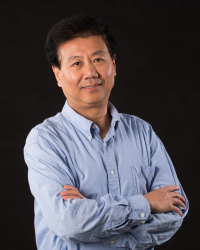 Yiqi Yang, Charles Bessey professor in the Department of Textiles,
Merchandising and Fashion Design, is the recipient of the 2021 Olney Medal for Outstanding Achievement in Textile Science from the
American Association of Textile Chemists and Colorists. The Olney Medal is AATCC’s highest
scientific award, established in 1944 in honor of Louis Atwell Olney, the founder and first
president of AATCC. The award consists of a gold medal, a scroll, and an honorarium. Yang
received the award at the AATCC Textile Discovery Summit in Charlotte, North Carolina, on Oct.
6, where he also delivered the traditional Olney Medal Address. His talk was titled “A Step
Toward a More Sustainable, Responsible and Profitable Textile Industry.” (11/2/22)
Yiqi Yang, Charles Bessey professor in the Department of Textiles,
Merchandising and Fashion Design, is the recipient of the 2021 Olney Medal for Outstanding Achievement in Textile Science from the
American Association of Textile Chemists and Colorists. The Olney Medal is AATCC’s highest
scientific award, established in 1944 in honor of Louis Atwell Olney, the founder and first
president of AATCC. The award consists of a gold medal, a scroll, and an honorarium. Yang
received the award at the AATCC Textile Discovery Summit in Charlotte, North Carolina, on Oct.
6, where he also delivered the traditional Olney Medal Address. His talk was titled “A Step
Toward a More Sustainable, Responsible and Profitable Textile Industry.” (11/2/22)
Research Roundup: Uneven Flow
 Xiao Cheng Zeng, Chancellor’s University Professor emeritus of chemistry,
recently teamed with
colleagues in China and the United States to study how the length of the nanotubes can
influence how fast they transport water. On the macroscale, water flow typically slows as a
tube lengthens. But simulations run by the team suggest that in relatively narrow carbon
nanotubes — those less than a nanometer in diameter — the speed of water flow instead increases
as those nanotubes lengthen from zero to 0.37 nanometers. Beyond that length, the rate of water
transport either slowly decreases or slightly varies, according to the simulations.
(11/2/22)
Xiao Cheng Zeng, Chancellor’s University Professor emeritus of chemistry,
recently teamed with
colleagues in China and the United States to study how the length of the nanotubes can
influence how fast they transport water. On the macroscale, water flow typically slows as a
tube lengthens. But simulations run by the team suggest that in relatively narrow carbon
nanotubes — those less than a nanometer in diameter — the speed of water flow instead increases
as those nanotubes lengthen from zero to 0.37 nanometers. Beyond that length, the rate of water
transport either slowly decreases or slightly varies, according to the simulations.
(11/2/22)
Sabirianov named Milo Bail Chair
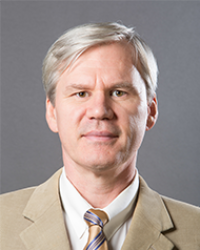 At the
University of Nebraska at Omaha's 2022 Faculty Honors Convocation, Renat Sabirianov was recognized as a recipient of the Milo Bail Chair
in Physics. Named chairs and professorships highlight achievements in teaching, research,
innovation, and commitment to supporting students. (10/14/22)
At the
University of Nebraska at Omaha's 2022 Faculty Honors Convocation, Renat Sabirianov was recognized as a recipient of the Milo Bail Chair
in Physics. Named chairs and professorships highlight achievements in teaching, research,
innovation, and commitment to supporting students. (10/14/22)
Li chosen for Big Ten leadership program
 Yusong Li, Professor of Civil and
Environmental Engineering and Associate Dean for Faculty and Inclusion in the College of
Engineering, has been chosen by the Office of the Executive Vice Chancellor to participate in a
Big Ten Academic Alliance leadership program this year. Li has been selected for the Academic Leadership Program. ALP Fellows attend three 3-day seminars, each at a
different Big Ten campus. They also participate in on-campus meetings throughout the academic
year with members of our university's academic leadership. (10/12/22)
Yusong Li, Professor of Civil and
Environmental Engineering and Associate Dean for Faculty and Inclusion in the College of
Engineering, has been chosen by the Office of the Executive Vice Chancellor to participate in a
Big Ten Academic Alliance leadership program this year. Li has been selected for the Academic Leadership Program. ALP Fellows attend three 3-day seminars, each at a
different Big Ten campus. They also participate in on-campus meetings throughout the academic
year with members of our university's academic leadership. (10/12/22)
U.S.-Issued Patents, July-September 2022
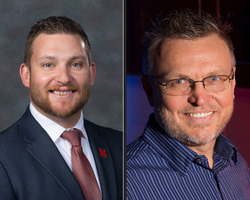 The following list includes
U.S.-issued patents granted by the U.S. Patent and Trademark Office to NCMN researchers from
July 1, 2022, to Sept. 30, 2022, as reported by NUtech Ventures:
The following list includes
U.S.-issued patents granted by the U.S. Patent and Trademark Office to NCMN researchers from
July 1, 2022, to Sept. 30, 2022, as reported by NUtech Ventures:
Robotic Device with Compact Joint Design and Related Systems and Methods, Thomas
Frederick, Shane M. Farritor, Dmitry Oleynikov, Eric
Markvicka, 11,406,458
Method of Fabricating a Continuous Nanofiber, Yuris
Dzenis, 11,414,790
(10/10/22)
Top Sponsored Awards, September 2022
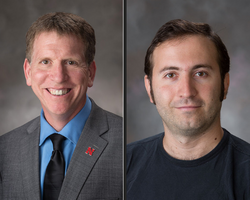 Top sponsored awards are awards from
public entities, including grants of $200,000 or more between July 16 and Aug. 15, 2022, as
reported through NUgrant.
Top sponsored awards are awards from
public entities, including grants of $200,000 or more between July 16 and Aug. 15, 2022, as
reported through NUgrant.
Jeff Shield, $444,124, NSF, Non-equilibrium Phase Discovery in
Finite-sized Systems
M. Vuran, Christos Argyropoulos, Y. Ge, Q. Liu, S. Nie, S.
Pitla; $1,000,000; NSF; CNS Core: Medium: Field-Nets: Field-to-Edge Connectivity for Joint
Communication and Sensing in Next-Generation Intelligent Agricultural Networks
(10/10/22)
Pannier to present Nebraska Lecture Nov. 17
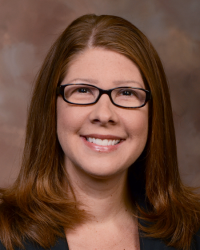 Angie Pannier, Swarts Family Chair in biological systems engineering,
will present the Nov. 17 Nebraska Lecture, “DNA and RNA Delivery: From Novel Therapies to
Vaccines that End Pandemics.” Pannier’s laboratory has worked to understand and innovate DNA
and RNA delivery and to develop methods to transfer those molecules more efficiently into human
cells. Her talk will describe the history of gene therapy, the events in 2020 that changed the
field, and the future technologies that will revolutionize medical therapies. (10/5/22)
Angie Pannier, Swarts Family Chair in biological systems engineering,
will present the Nov. 17 Nebraska Lecture, “DNA and RNA Delivery: From Novel Therapies to
Vaccines that End Pandemics.” Pannier’s laboratory has worked to understand and innovate DNA
and RNA delivery and to develop methods to transfer those molecules more efficiently into human
cells. Her talk will describe the history of gene therapy, the events in 2020 that changed the
field, and the future technologies that will revolutionize medical therapies. (10/5/22)
Hu wins pitch contest at Energy Center workshop
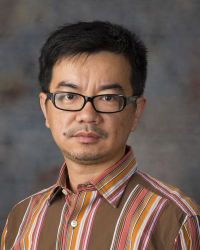 Jiong Hu won first place in a pitch contest held as part of an Energy Center
Entrepreneurship Workshop hosted by the Nebraska Center for Energy Sciences Research, Nebraska
Public Power District, NUtech Ventures, and Innosphere Ventures.
Jiong Hu won first place in a pitch contest held as part of an Energy Center
Entrepreneurship Workshop hosted by the Nebraska Center for Energy Sciences Research, Nebraska
Public Power District, NUtech Ventures, and Innosphere Ventures.
“I just wanted to thank NUtech and NCESR for hosting this Energy Center Entrepreneurship
Workshop,” Hu said. “As a researcher, we always want our research products to be applied and
used, as it will benefit not just us at UNL but also the entire society. However, we don’t
always think from the entrepreneurial viewpoint, which often narrows the opportunities and
limits the impact on the larger community. The workshop gave us a comprehensive view of how to
better position ourselves to put our products on the market. It was also a great experience to
pitch our research products in front of the guest panel with local entrepreneurs and funding
organizations and receive constructive feedback from the experts. I look forward to
opportunities that might present in the near future. Once again, thanks for all the efforts in
organizing the workshop.” (10/5/22)
NCMN Faculty and Staff earn Service Awards
 The following NCMN faculty and
staff were honored with Employee Service Awards during a ceremony held on September 28.
The following NCMN faculty and
staff were honored with Employee Service Awards during a ceremony held on September 28.
5 Years: Samone Behrendt, NCMN
10 Years: Steve Michalski, NCMN
15 Years: Angela Pannier, BSE; Rebecca Lai, CHEM; Alexei Gruverman, PHYS
20 Years: Yongfeng Lu, ECE; Eva Schubert, ECE; Zhaoyan
Zhang, MME; Kirill Belashchenko, PHYS; Evgeny Tsymbal, PHYS
25 Years: Joseph Turner, MME; Jiashi Yang, MME; Herman Batelaan,
PHYS
30 Years: Hendrik Viljoen, CHME; Andrzej Rajca, CHEM
50 Years: David Sellmyer, PHYS (in memoriam)
(10/5/22)
Berkowitz, Morin work featured in Research Roundup
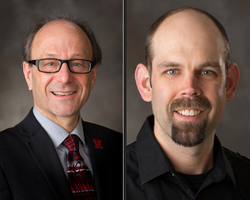 The latest 'Research Roundup'
highlighted some of the latest work from the labs of David
Berkowitz and Stephen Morin. The Berkowitz Group penned an 81-page
overview of how large biological molecules have stimulated the discovery of innovation-driving
catalysts and chemical reactions that recently graced the cover of Chemical Reviews. Morin's group has developed
a simple, scalable, and inexpensive method of adhering
certain metals to commercially viable plastics — an appealing option for engineers of
wearable electronics, smart packaging, and other technologies. (9/21/22)
The latest 'Research Roundup'
highlighted some of the latest work from the labs of David
Berkowitz and Stephen Morin. The Berkowitz Group penned an 81-page
overview of how large biological molecules have stimulated the discovery of innovation-driving
catalysts and chemical reactions that recently graced the cover of Chemical Reviews. Morin's group has developed
a simple, scalable, and inexpensive method of adhering
certain metals to commercially viable plastics — an appealing option for engineers of
wearable electronics, smart packaging, and other technologies. (9/21/22)
Binek awarded IOP Trusted Reviewer status
 Christian Binek has been awarded 'IOP Trusted Reviewer' status from
IOP Publishing. 'Trusted Reviewer'
status is achieved following the submission of a top-quality review report, indicating a high
level of peer review competence and the ability to constructively critique scientific
literature to an exceptional standard without the need for training. (9/12/22)
Christian Binek has been awarded 'IOP Trusted Reviewer' status from
IOP Publishing. 'Trusted Reviewer'
status is achieved following the submission of a top-quality review report, indicating a high
level of peer review competence and the ability to constructively critique scientific
literature to an exceptional standard without the need for training. (9/12/22)
Top Sponsored Awards, July 2022
 Top
sponsored awards are awards from public entities, including grants of $200,000 or more between
June 16 and July 15, 2022, as reported through NUgrant.
Top
sponsored awards are awards from public entities, including grants of $200,000 or more between
June 16 and July 15, 2022, as reported through NUgrant.
Herman Batelaan, physics and astronomy; $588,032; NSF; Coherent Electron Control (9/6/22)
Four NCMN faculty selected for Research Leaders Program
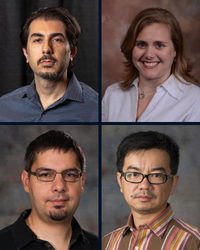 The Office for Research and Economic Development has announced the third
cohort of its Research Leaders Program. Four of the 15 faculty selected belong to NCMN:
Ozan Ciftci, food science and technology; Jiong Hu, civil and environmental engineering; Nicole Iverson, biological systems engineering; Alexey Kovalev, physics and astronomy. The program is aimed at
identifying and developing the next generation of research leaders and is believed to be the
first of its kind in the Big Ten and among the first nationally. (8/31/22)
The Office for Research and Economic Development has announced the third
cohort of its Research Leaders Program. Four of the 15 faculty selected belong to NCMN:
Ozan Ciftci, food science and technology; Jiong Hu, civil and environmental engineering; Nicole Iverson, biological systems engineering; Alexey Kovalev, physics and astronomy. The program is aimed at
identifying and developing the next generation of research leaders and is believed to be the
first of its kind in the Big Ten and among the first nationally. (8/31/22)
Berkowitz Lab review article on Chemical Reviews cover
 A
review article from the lab of David Berkowitz, Willa Cather
Professor of Chemistry, is featured on the cover of Chemical Reviews, a journal published by
the American Chemical Society. The review, “Biomacromolecule-Assisted Screening for Reaction Discovery and Catalyst
Optimization,” was co-authored by doctoral alumni Stephany Ramos De Dios and Christopher
McCune, postdoctoral researcher Virendra Tiwari, and former Husker postdoc Ranjeet Dhokale.
(8/26/22)
A
review article from the lab of David Berkowitz, Willa Cather
Professor of Chemistry, is featured on the cover of Chemical Reviews, a journal published by
the American Chemical Society. The review, “Biomacromolecule-Assisted Screening for Reaction Discovery and Catalyst
Optimization,” was co-authored by doctoral alumni Stephany Ramos De Dios and Christopher
McCune, postdoctoral researcher Virendra Tiwari, and former Husker postdoc Ranjeet Dhokale.
(8/26/22)
Li team tracks tiny particle movement through pipes
 Yusong Li, and colleague Jae Sung Park,
are working on a three-year, $418,120 National Science Foundation grant to learn how small
particles – some less than 10 microns – better move through confined fluid flows in transport
systems, such as pipes. The study looks to determine better ways for energy and environmental
sectors to achieve greater efficiency at mitigating contamination or in providing cheaper fuel.
(8/24/22)
Yusong Li, and colleague Jae Sung Park,
are working on a three-year, $418,120 National Science Foundation grant to learn how small
particles – some less than 10 microns – better move through confined fluid flows in transport
systems, such as pipes. The study looks to determine better ways for energy and environmental
sectors to achieve greater efficiency at mitigating contamination or in providing cheaper fuel.
(8/24/22)
NSF Funds NV Quantum Sensing Capabilities for NCMN Attocube System
 NCMN is pleased to announce that
the National Science Foundation has decided to fund our Major Research Instrumentation
proposal, "Acquisition of optical access in a cryogenic scanning probe microscope for quantum
sensing capabilities." This instrument will leverage the existing scanning probe microscopy
capabilities we have at NCMN and add the first commercial quantum sensing device to the set of
characterization facilities at NCMN. There are only a few instruments of this kind available
throughout the country. Christian Binek is the PI, and Xia Hong, Abdelghani Laraoui, and Xiaoshan Xu are Co-PI's.
NCMN is pleased to announce that
the National Science Foundation has decided to fund our Major Research Instrumentation
proposal, "Acquisition of optical access in a cryogenic scanning probe microscope for quantum
sensing capabilities." This instrument will leverage the existing scanning probe microscopy
capabilities we have at NCMN and add the first commercial quantum sensing device to the set of
characterization facilities at NCMN. There are only a few instruments of this kind available
throughout the country. Christian Binek is the PI, and Xia Hong, Abdelghani Laraoui, and Xiaoshan Xu are Co-PI's.
We can’t wait to set the system up and see it producing scientific results. (8/18/22)
Kidambi named Neb. Governance and Technology Center faculty fellow
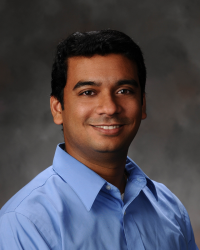 Srivatsan Kidambi is among the newest cohort of faculty fellows for the
Nebraska Governance and Technology Center.
The fellows are drawn from across the university and are interested in the challenges of
changing technology. The goal of the Fellows program is to form a unit of academics who study
technology in interdisciplinary terms. (8/15/22)
Srivatsan Kidambi is among the newest cohort of faculty fellows for the
Nebraska Governance and Technology Center.
The fellows are drawn from across the university and are interested in the challenges of
changing technology. The goal of the Fellows program is to form a unit of academics who study
technology in interdisciplinary terms. (8/15/22)
Top Sponsored Awards, June 2022
 The following awards from public
entities include grants of $200,000 or more between Feb. 16 and March 15, 2022, as reported
through NUgrant:
The following awards from public
entities include grants of $200,000 or more between Feb. 16 and March 15, 2022, as reported
through NUgrant:
(8/1/22)
Researchers predict climate impacts on herbicide runoff
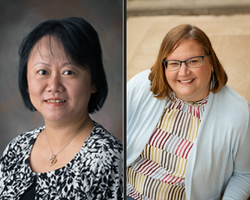 Yusong Li and Shannon Bartelt-Hunt
(with colleague Chuyang Liu) have used supercomputers to run 2,000 simulations
to predict the climate of a research site near Shelton, Neb. in the years 2056 through 2059.
The researchers aim to understand the characteristics of atrazine (a popular herbicide) runoff
in a future affected by climate change. The team concluded that climate variability will
generally matter only if atrazine degrades slowly in soils, or if those soils are poor at
clinging to and absorbing the herbicide. Given the potential importance of atrazine degradation
rates, future research should investigate the factors that influence those rates, the
researchers said. (7/26/22)
Yusong Li and Shannon Bartelt-Hunt
(with colleague Chuyang Liu) have used supercomputers to run 2,000 simulations
to predict the climate of a research site near Shelton, Neb. in the years 2056 through 2059.
The researchers aim to understand the characteristics of atrazine (a popular herbicide) runoff
in a future affected by climate change. The team concluded that climate variability will
generally matter only if atrazine degrades slowly in soils, or if those soils are poor at
clinging to and absorbing the herbicide. Given the potential importance of atrazine degradation
rates, future research should investigate the factors that influence those rates, the
researchers said. (7/26/22)
Nebraska researchers look to further understand energy requirements of walking in older adults
 Scientists
who have studied the metabolic cost of different phases of the walking gait cycle have
difficulty collecting data — partly due to physical demands on the test subjects and because
measurements aren’t collected quickly enough to be of great value. In collaboration with
researchers from the University of Nebraska at Omaha, Keegan Moore
looks to use cutting-edge digital technologies — such as artificial intelligence and machine
learning — to improve the current collection methods and develop algorithms that can further
research. The team at UNO will conduct motion-capture experiments in which they will influence
different phases using a robotic waist tether. Engineers in Moore’s lab will use data from these
experiments to develop algorithms to estimate fluctuations in a person’s metabolism during
different phases of their gait cycle. (7/22/22)
Scientists
who have studied the metabolic cost of different phases of the walking gait cycle have
difficulty collecting data — partly due to physical demands on the test subjects and because
measurements aren’t collected quickly enough to be of great value. In collaboration with
researchers from the University of Nebraska at Omaha, Keegan Moore
looks to use cutting-edge digital technologies — such as artificial intelligence and machine
learning — to improve the current collection methods and develop algorithms that can further
research. The team at UNO will conduct motion-capture experiments in which they will influence
different phases using a robotic waist tether. Engineers in Moore’s lab will use data from these
experiments to develop algorithms to estimate fluctuations in a person’s metabolism during
different phases of their gait cycle. (7/22/22)
Roohi, Kidambi receive Layman Awards
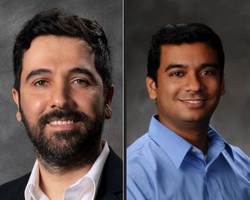 Arman
Roohi and Srivatsan Kidambi will recieve Layman Awards from
the Office of Research and Economic Development, which fund work that enhances a researcher’s
ability to obtain external funding to support prominent scholarship.
Arman
Roohi and Srivatsan Kidambi will recieve Layman Awards from
the Office of Research and Economic Development, which fund work that enhances a researcher’s
ability to obtain external funding to support prominent scholarship.
Roohi received his award through the Layman Seed Program for his project, “Enabling robust
quantized neural network acceleration in federated edge computing.” The Layman Seed Program
funds new projects by early-career faculty who are nontenured at the time of submission.
Kidambi received his award through the New Directions Program for his project, “Synthetic
biomimetic environment (BEASTS) to investigate the role of stiffness in altered redox signaling
and inflammation in placenta during HDP.” The New Directions Program funds tenured faculty who
are branching into new research directions or need funding to support pilot or developmental
work toward the next step in a funded research program. (7/12/22)
Team achieves ‘significant breakthrough’ in data-encoding material
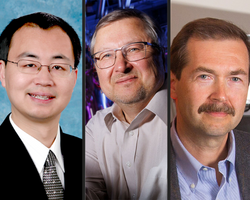 Bucking years of conventional wisdom, Husker researchers have shown that
hafniumm oxide's most technologically appealing property can emerge from unexpected conditions.
In a new Nature Materials study, a team led by Nebraska’s Xiaoshan
Xu, Evgeny Tsymbal and Alexei
Gruverman has demonstrated that growing a higher-quality, larger-grained crystal of hafnium
oxide can actually generate higher polarization and potentially more reliable ferroelectricity.
The quality of the crystal, meanwhile, is offering sharper insights into how and why that
ferroelectricity occurs. (7/11/22)
Bucking years of conventional wisdom, Husker researchers have shown that
hafniumm oxide's most technologically appealing property can emerge from unexpected conditions.
In a new Nature Materials study, a team led by Nebraska’s Xiaoshan
Xu, Evgeny Tsymbal and Alexei
Gruverman has demonstrated that growing a higher-quality, larger-grained crystal of hafnium
oxide can actually generate higher polarization and potentially more reliable ferroelectricity.
The quality of the crystal, meanwhile, is offering sharper insights into how and why that
ferroelectricity occurs. (7/11/22)
Kidambi co-authors new paper on cyberbiosecurity
 Srivatsan Kidambi is among the co-authors of a newly published
paper that examines the emerging and expanding interdisciplinary field of cyberbiosecurity.
The paper explores the concept of "biohacking,” in which an attack is conducted both from the
cyber and biological domain. The paper also examines the use of deep learning technologies to
safeguard DNA sequencing against such attacks. (7/8/22)
Srivatsan Kidambi is among the co-authors of a newly published
paper that examines the emerging and expanding interdisciplinary field of cyberbiosecurity.
The paper explores the concept of "biohacking,” in which an attack is conducted both from the
cyber and biological domain. The paper also examines the use of deep learning technologies to
safeguard DNA sequencing against such attacks. (7/8/22)
Krasnoslobodtsev receives grant to study nanomaterials with medical applications
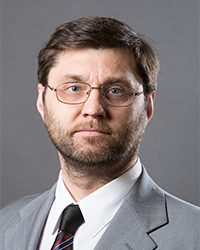 UNO biophysicist Alexey
Krasnoslobodtsev, in collaboration with colleagues, was awarded an $814,324 grant from the
National Science Foundation to study a new class of biomaterials that respond to external
stimuli and to develop Nebraska’s growing biotechnology workforce. The materials, called
programmable nucleic acid nanoparticles (NANPs), will be suitable for a broad range of
biomedical applications. (7/6/22)
UNO biophysicist Alexey
Krasnoslobodtsev, in collaboration with colleagues, was awarded an $814,324 grant from the
National Science Foundation to study a new class of biomaterials that respond to external
stimuli and to develop Nebraska’s growing biotechnology workforce. The materials, called
programmable nucleic acid nanoparticles (NANPs), will be suitable for a broad range of
biomedical applications. (7/6/22)
U.S.-Issued Patents, April - June 2022
 The following list includes
U.S.-issued patents granted by the U.S. Patent and Trademark Office to NCMN researchers from
April 1, 2022, to June 30, 2022, as reported by NUtech Ventures:
The following list includes
U.S.-issued patents granted by the U.S. Patent and Trademark Office to NCMN researchers from
April 1, 2022, to June 30, 2022, as reported by NUtech Ventures:
Circuits Based on Magnetoelectric Transistor Devices; Andrew Marshall, Peter A. Dowben, Nishtha Sharma, Dmitri E. Nikonov; 11,349,480
Nanoporous Starch Aerogels Impregnated with Phytosterols and Methods of Preparing the
Nanoporous Starch Aerogels, Ozan Nazim Ciftci, 11,369,895
(7/5/22)
New device gets scientists closer to quantum materials breakthrough
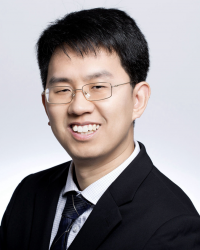 Researchers
from the University of Nebraska-Lincoln and the University of California, Berkeley, have
developed a new photonic device that could get scientists closer to the “holy grail” of finding
the global minimum of mathematical formulations at room temperature. Finding that elusive
mathematical value would be a major advancement in opening new options for simulations
involving quantum materials. Wei Bao is the corresponding author of a
paper reporting
this research, published in Nature Materials. (6/17/22)
Researchers
from the University of Nebraska-Lincoln and the University of California, Berkeley, have
developed a new photonic device that could get scientists closer to the “holy grail” of finding
the global minimum of mathematical formulations at room temperature. Finding that elusive
mathematical value would be a major advancement in opening new options for simulations
involving quantum materials. Wei Bao is the corresponding author of a
paper reporting
this research, published in Nature Materials. (6/17/22)
Hage wins 2022 AACC Merit Award
 The
American Association for Clinical Chemistry
(AACC) has chosen David Hage as the winner for its 2022 award for
Outstanding Contributions to Education in Clinical Chemistry. This award recognizes an
individual who has devoted a major portion of his/her professional life to enhancing the
practice and profession of clinical chemistry through education. Hage and his students are
interested in the theory, development, and use of affinity-based separations in
high-performance liquid chromatography and capillary electrophoresis, with an emphasis on
clinical and biomedical applications. He has been a research mentor to over 80 undergraduate
students and 75 graduate students, resulting in roughly 80 Ph.D. or M.S. degrees and with many
of these students entering the fields of clinical chemistry or biomedical research.
(6/1/22)
The
American Association for Clinical Chemistry
(AACC) has chosen David Hage as the winner for its 2022 award for
Outstanding Contributions to Education in Clinical Chemistry. This award recognizes an
individual who has devoted a major portion of his/her professional life to enhancing the
practice and profession of clinical chemistry through education. Hage and his students are
interested in the theory, development, and use of affinity-based separations in
high-performance liquid chromatography and capillary electrophoresis, with an emphasis on
clinical and biomedical applications. He has been a research mentor to over 80 undergraduate
students and 75 graduate students, resulting in roughly 80 Ph.D. or M.S. degrees and with many
of these students entering the fields of clinical chemistry or biomedical research.
(6/1/22)
NCMN researchers appointed NSRI Fellows
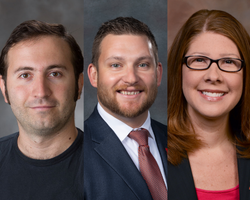 Christos Argyropoulos, Eric
Markvicka, and Angela Pannier have been named National
Strategic Research Institute (NSRI) Fellows. According to Maj. Gen., USAF (Ret.) Rick Evans,
NSRI executive director, "(NSRI's) objective is to bring the might of the University of
Nebraska System's intellectual and physical research capability and capacity to the DOD and the
Nation." The aim of an NSRI Fellow is to contribute their expertise to the strategic deterrence
and countering weapons of mass destruction mission areas. (5/4/22)
Christos Argyropoulos, Eric
Markvicka, and Angela Pannier have been named National
Strategic Research Institute (NSRI) Fellows. According to Maj. Gen., USAF (Ret.) Rick Evans,
NSRI executive director, "(NSRI's) objective is to bring the might of the University of
Nebraska System's intellectual and physical research capability and capacity to the DOD and the
Nation." The aim of an NSRI Fellow is to contribute their expertise to the strategic deterrence
and countering weapons of mass destruction mission areas. (5/4/22)
Iverson receives CAREER Award
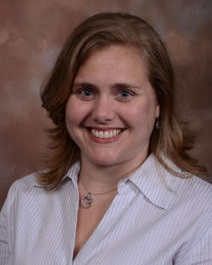 Nicole Iverson has received a five-year, $550,000 grant from the National
Science Foundation's Faculty Early Career Development Program. The award supports her team's
research into using carbon nanotubes to diagnose diseases like diabetes or certain forms of
cancer. It also will be used for community outreach to expand understanding of nanotechnology.
(5/4/22)
Nicole Iverson has received a five-year, $550,000 grant from the National
Science Foundation's Faculty Early Career Development Program. The award supports her team's
research into using carbon nanotubes to diagnose diseases like diabetes or certain forms of
cancer. It also will be used for community outreach to expand understanding of nanotechnology.
(5/4/22)
Top Sponsored Awards, March 2022
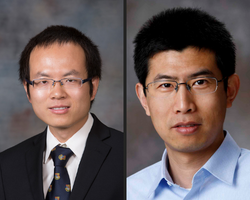 The
following awards from public entities include grants of $200,000 or more between Feb. 16 and
March 15, 2022, as reported through NUgrant:
The
following awards from public entities include grants of $200,000 or more between Feb. 16 and
March 15, 2022, as reported through NUgrant:
Bai Cui; $300,000; West Virginia University; Additively
Manufactured Graded Composite Transition Joints for Dissimilar Metal Weldments in Advanced
Ultra-Supercritical Power Plant
Ruiguo Yang; $536,907; National Science Foundation; CAREER:
Characterization of the Rate-Dependent Mechanical Behavior of the Cell-Cell Adhesion
Interface (5/4/22)
Husker team demonstrates that MoS2 is ferroelectric
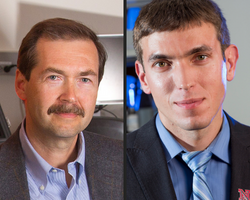 Alexei Gruverman, Alex Sinitskii, and colleagues (including Evgeny Tsymbal) have demonstrated that molybdenum disulfide
(MoS2) is ferroelectric. The vertical separation and arrangement of negative vs.
positive charges in ferroelectric materials can be instantaneously flipped just by applying
some voltage. Those oppositely aligned, or polarized, states can be read or stored as the 1s
and 0s of binary data, with the states remaining even when a power source has been cut.
(4/27/22)
Alexei Gruverman, Alex Sinitskii, and colleagues (including Evgeny Tsymbal) have demonstrated that molybdenum disulfide
(MoS2) is ferroelectric. The vertical separation and arrangement of negative vs.
positive charges in ferroelectric materials can be instantaneously flipped just by applying
some voltage. Those oppositely aligned, or polarized, states can be read or stored as the 1s
and 0s of binary data, with the states remaining even when a power source has been cut.
(4/27/22)
Gruverman earns University Professorship
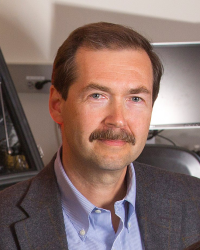 Alexei Gruverman will be Charles J. Mach professor of physics and astronomy. Gruverman currently
holds a Charles Bessey professorship and conducts research related to ferroelectric materials,
which are critical elements of modern electronics. He pioneered the use of piezoresponse force
microscopy for nondestructive imaging of ferroelectric domains and his method is now actively
used in ferroelectric research worldwide. His research into applications of PFM has resulted in
over 240 publications, many in journals of international stature. The impact of Gruverman's
research spans more than 15,000 citations of his work and numerous invitations to seminars. He
has received many awards and honors, most notable being the Humboldt Research Award and being
named an International Fellow of the Japan Society of Applied Physics. Gruverman has won, led,
and participated in about 20 research projects as PI or co-PI with total funding of more than
$34 million ($3 million as principal investigator) over his career. He played a major role in
the success of the National Science Foundation-funded Materials Research Science and
Engineering Center, as well as several other large multi-investigator grants. (4/25/22)
Alexei Gruverman will be Charles J. Mach professor of physics and astronomy. Gruverman currently
holds a Charles Bessey professorship and conducts research related to ferroelectric materials,
which are critical elements of modern electronics. He pioneered the use of piezoresponse force
microscopy for nondestructive imaging of ferroelectric domains and his method is now actively
used in ferroelectric research worldwide. His research into applications of PFM has resulted in
over 240 publications, many in journals of international stature. The impact of Gruverman's
research spans more than 15,000 citations of his work and numerous invitations to seminars. He
has received many awards and honors, most notable being the Humboldt Research Award and being
named an International Fellow of the Japan Society of Applied Physics. Gruverman has won, led,
and participated in about 20 research projects as PI or co-PI with total funding of more than
$34 million ($3 million as principal investigator) over his career. He played a major role in
the success of the National Science Foundation-funded Materials Research Science and
Engineering Center, as well as several other large multi-investigator grants. (4/25/22)
NCMN faculty receive promotion, tenure
 Congratulations to the following
NCMN faculty members receiving promotions in 2022!
Congratulations to the following
NCMN faculty members receiving promotions in 2022!
Promoted to associate professor and granted tenure:
- Shudipto Dishari, Chemical and Biomolecular Engineering
- Jongwan Eun, Civil and Environmental Engineering
- Nicole Iverson, Biological Systems Engineering
- Forrest Kievit, Biological Systems Engineering
- Ruiguo Yang, Mechanical and Materials Engineering
Promoted to professor and granted tenure:
- Jiong Hu, Civil and Environmental Engineering
Promoted to professor:
- Xia Hong, Physics and Astronomy & Nebraska Center for Materials
and Nanoscience
(4/20/22)
Mourning the death of Ralph Skomski
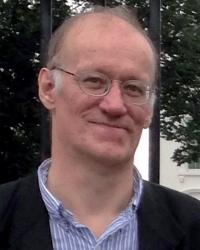 Dr. Ralph
Skomski suddenly passed away at home on April 10. Skomski was a gifted theoretical researcher,
publishing over 425 papers, books, and book chapters in his career. He was a Fellow of the
American Physical Society and a member of the Editorial Boards of IEEE Magn. Lett., J. Phys. D
and J. Magn. Magn. Mater.
Dr. Ralph
Skomski suddenly passed away at home on April 10. Skomski was a gifted theoretical researcher,
publishing over 425 papers, books, and book chapters in his career. He was a Fellow of the
American Physical Society and a member of the Editorial Boards of IEEE Magn. Lett., J. Phys. D
and J. Magn. Magn. Mater.
Skomski began working at UNL as a Visiting Assistant Professor in 1998. He was promoted to
Research Assistant Professor in 2000, Research Associate Professor in 2003, and Research Full
Professor in 2012. He was an active researcher working for many years with Professor David
Sellmyer, who died only a few weeks ago. (4/19/22)
Yang advancing work on cell-cell junctions and their link to human health
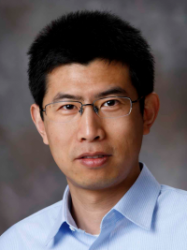 Ruiguo Yang is using a $540,000 grant from NSF’s Faculty Early Career
Development Program to explore how cell-cell bridges respond to strains of different magnitudes
and rates. Since these junctions maintain tissue integrity and regulate cell-to-cell signaling,
understanding their response to strain could shed light on the mechanics of diseases like
cancer, genetic mutations in the heart, autoimmune skin conditions and more — and offer clues
about how to effectively treat them. (4/15/22)
Ruiguo Yang is using a $540,000 grant from NSF’s Faculty Early Career
Development Program to explore how cell-cell bridges respond to strains of different magnitudes
and rates. Since these junctions maintain tissue integrity and regulate cell-to-cell signaling,
understanding their response to strain could shed light on the mechanics of diseases like
cancer, genetic mutations in the heart, autoimmune skin conditions and more — and offer clues
about how to effectively treat them. (4/15/22)
Nebraska, Buffalo researchers create first magneto-electric transistor
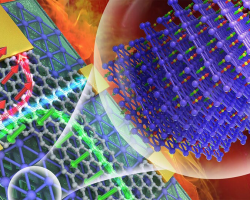 Christian Binek, Peter Dowben, Will Echtenkamp, Ather Mahmood, and colleagues from the
University at Buffalo have teamed up to fabricate a new type of transistor that could curb
energy consumption of microelectronics and reduce the number of transistors needed to store
certain data by as much as 75%. This new transistor could cut 5 percent from the world's
digital energy budget, while also saving space and retaining memory in the event of a power
loss. (4/11/22)
Christian Binek, Peter Dowben, Will Echtenkamp, Ather Mahmood, and colleagues from the
University at Buffalo have teamed up to fabricate a new type of transistor that could curb
energy consumption of microelectronics and reduce the number of transistors needed to store
certain data by as much as 75%. This new transistor could cut 5 percent from the world's
digital energy budget, while also saving space and retaining memory in the event of a power
loss. (4/11/22)
Xu paper on cover of Crystal Growth & Design
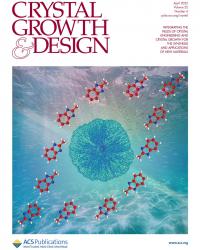 A paper on organic ferroelectrics by
Xiaoshan Xu and colleagues was recently published as a cover story in
Crystal Growth & Design. The article is titled "Highly Oriented Organic
Ferroelectric Films with Single-Crystal-Level." (4/6/22)
A paper on organic ferroelectrics by
Xiaoshan Xu and colleagues was recently published as a cover story in
Crystal Growth & Design. The article is titled "Highly Oriented Organic
Ferroelectric Films with Single-Crystal-Level." (4/6/22)
Remembering the life and work of David Sellmyer
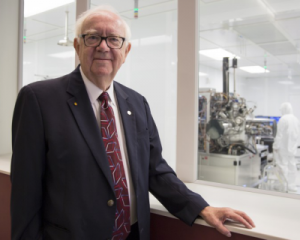 Founding
director of the Nebraska Center for Materials and Nanoscience, David J. Sellmyer, 83, died at
home surrounded by his family on March 25. Sellmyer was the driving force behind the creation
of NCMN, the Voelte-Keegan Nanoscience Research building, and the Nebraska Nanoscale Facility.
Dan Claes, current department chair and professor of physics and astronomy said of Sellmyer's
leadership, "I don’t believe there’s anyway we could overstate the impact Dave has had on the
department, university and specifically our materials science program. It’s a legacy that will
be with us this forever.”
Founding
director of the Nebraska Center for Materials and Nanoscience, David J. Sellmyer, 83, died at
home surrounded by his family on March 25. Sellmyer was the driving force behind the creation
of NCMN, the Voelte-Keegan Nanoscience Research building, and the Nebraska Nanoscale Facility.
Dan Claes, current department chair and professor of physics and astronomy said of Sellmyer's
leadership, "I don’t believe there’s anyway we could overstate the impact Dave has had on the
department, university and specifically our materials science program. It’s a legacy that will
be with us this forever.”
Condolences can be left on the Wyuka website, and a recording of the funeral service is available on
YouTube. (4/5/22)
Wang receives MPMD Distinguished Scientist/Engineer Award
 Jian Wang has received the
Distinguished Scientist/Engineer Award from the Materials Processing and
Manufacturing Division of The Minerals, Metals, and Materials Society. The award recognizes an
individual who has made a long-lasting contribution to the design, synthesis, processing, and
performance of engineering materials, with significant industrial applications. Wang was
honored for his efforts to understand the structure-properties relationships of structural
materials. (4/5/22)
Jian Wang has received the
Distinguished Scientist/Engineer Award from the Materials Processing and
Manufacturing Division of The Minerals, Metals, and Materials Society. The award recognizes an
individual who has made a long-lasting contribution to the design, synthesis, processing, and
performance of engineering materials, with significant industrial applications. Wang was
honored for his efforts to understand the structure-properties relationships of structural
materials. (4/5/22)
US-Issued Patents, January - March 2022
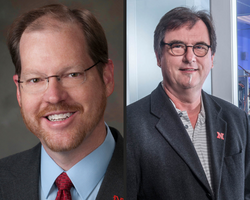 The following list includes all
U.S.-issued patents granted by the U.S. Patent and Trademark Office to University of
Nebraska-Lincoln researchers from Jan 1, 2022, to March 31, 2022, as reported by NUtech
Ventures.
The following list includes all
U.S.-issued patents granted by the U.S. Patent and Trademark Office to University of
Nebraska-Lincoln researchers from Jan 1, 2022, to March 31, 2022, as reported by NUtech
Ventures.
Decomposition of Organic Peroxides and Hydrogen Peroxide by the Iron Thiolates and Related
Complexes; Patrick H. Dussault, Andrew Olson; 11,242,296
Hall Bar Device for Memory and Logic Applications; Christian
Binek, Ather Mahmood, Will Echtenkamp; 11,233,192
(4/5/22)
Top Sponsored Awards, February 2022
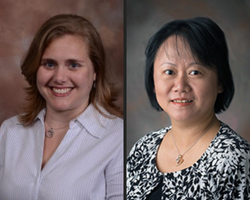 Top sponsored awards are awards from
public entities including all arts and humanities grants of $10,000 or more and all other
grants of $200,000 or more between Jan. 16 and Feb. 15, 2022, as reported through NUgrant.
Top sponsored awards are awards from
public entities including all arts and humanities grants of $10,000 or more and all other
grants of $200,000 or more between Jan. 16 and Feb. 15, 2022, as reported through NUgrant.
Nicole Iverson; $550,000; NSF; CAREER: Extracellular Hydrogen
Peroxide and Nitric Oxide Detection and Quantification Via Biocompatible Carbon
Nanotubes
J. Park, Yusong Li; $418,120; NSF; Exploring Flow
Enhancements of Hydrophobic Particles in Confined Fluid Flow
(4/5/22)
Nebraska researchers published in Advanced Materials
 Christian Binek and
Peter Dowben were among the authors of a study recently published
in Advanced Materials. Imagery from the article, "Graphene on Chromia: A System for Beyond-Room-Temperature Spintronics," was chosen
for the back cover of the journal. (3/29/22)
Christian Binek and
Peter Dowben were among the authors of a study recently published
in Advanced Materials. Imagery from the article, "Graphene on Chromia: A System for Beyond-Room-Temperature Spintronics," was chosen
for the back cover of the journal. (3/29/22)
Hage to receive ACS Award in Chromatography
 On March
24, David Hage will receive the 2021 ACS Award in Chromatography from the American Chemical Society at the Spring 2022
ACS National Meeting and Exposition in San Diego. Recipients are recognized for outstanding
contributions to the field of chromatography, with particular consideration given to the
development of new methods. (3/18/22)
On March
24, David Hage will receive the 2021 ACS Award in Chromatography from the American Chemical Society at the Spring 2022
ACS National Meeting and Exposition in San Diego. Recipients are recognized for outstanding
contributions to the field of chromatography, with particular consideration given to the
development of new methods. (3/18/22)
Angela Pannier elected to 2022 Class of the AIMBE College of Fellows
 Angela Pannier was elected to the 2022 American Institute for Medical and Biological Engineering College of
Fellows. Fellows comprise the top 2% of medical and biological engineers in the country and are
selected for their contributions to teaching, research, and innovation. Pannier was recognized
for her contributions to understanding and engineering biomaterials and cellular systems for
applications in gene therapy, tissue engineering, and vaccination. (3/8/22)
Angela Pannier was elected to the 2022 American Institute for Medical and Biological Engineering College of
Fellows. Fellows comprise the top 2% of medical and biological engineers in the country and are
selected for their contributions to teaching, research, and innovation. Pannier was recognized
for her contributions to understanding and engineering biomaterials and cellular systems for
applications in gene therapy, tissue engineering, and vaccination. (3/8/22)
Top Sponsored Awards, January 2022
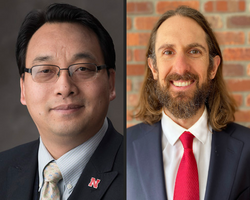 Top sponsored awards are awards
from public entities including all arts and humanities grants of $10,000 or more and all other
grants of $200,000 or more between July 16 and August 15, 2021, as reported
through NUgrant.
Top sponsored awards are awards
from public entities including all arts and humanities grants of $10,000 or more and all other
grants of $200,000 or more between July 16 and August 15, 2021, as reported
through NUgrant.
Jian Wang, $219,838, Auburn University, Technical Basis of
Microstructure Criteria and Accelerated Testing for Qualifying Additively-manufactured 316H
Stainless Steel for High-temperature Cyclic Service
Forrest Kievit, J. Zempleni, J. Guo; $630,000; USDA-NIFA;
Biopharming: Engineering Nanoparticles in Milk for Use in Drug Delivery
(3/8/22)
Saraf receives Family and Friends Recognition Award
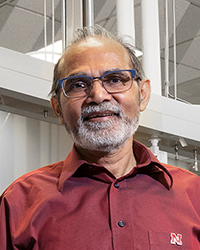 Ravi Saraf was one of 46 employees to receive a Family and Friends
Recognition Award for their support of students during a ceremony on March 4; nominations are
made by family and friends of students. This was Saraf's first time receiving the award.
(3/7/22)
Ravi Saraf was one of 46 employees to receive a Family and Friends
Recognition Award for their support of students during a ceremony on March 4; nominations are
made by family and friends of students. This was Saraf's first time receiving the award.
(3/7/22)
Schubert on international team published in Nature
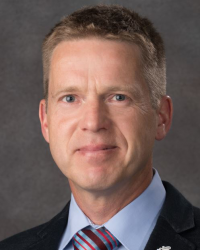 A
study published six years ago by Mathias Schubert
planted the seeds for what grew to an international collaboration and the discovery of a new
material class that could impact the future of emerging biotechnology and nanotechnology.
Schubert and his colleagues had their latest paper, Hyperbolic shear
polaritons in low-symmetry crystals, published in Nature. The group believe their results
“will motivate new directions for polariton physics … greatly expanding the material base and
extending design opportunities for compact photonic devices.” (Other articles: Nebraska EPSCoR, College of Engineering, Max Planck Society, Vanderbilt University)
A
study published six years ago by Mathias Schubert
planted the seeds for what grew to an international collaboration and the discovery of a new
material class that could impact the future of emerging biotechnology and nanotechnology.
Schubert and his colleagues had their latest paper, Hyperbolic shear
polaritons in low-symmetry crystals, published in Nature. The group believe their results
“will motivate new directions for polariton physics … greatly expanding the material base and
extending design opportunities for compact photonic devices.” (Other articles: Nebraska EPSCoR, College of Engineering, Max Planck Society, Vanderbilt University)
(3/6/22)
Olympic Physics: Gay breaks down the bobsled run
 Tim Gay
continues his masterclass in winter Olympic physics with a new video explaining the key
principle behind "sliding sports" like the bobsled and luge - the conservation of energy; “The
team that best keeps the loss of kinetic energy to a minimum,” Gay said, “wins the gold.”
(2/16/22)
Tim Gay
continues his masterclass in winter Olympic physics with a new video explaining the key
principle behind "sliding sports" like the bobsled and luge - the conservation of energy; “The
team that best keeps the loss of kinetic energy to a minimum,” Gay said, “wins the gold.”
(2/16/22)
Olympic Physics: Doin' the Slide
Video: Tim Gay explains the physic that powers the sliding sports - bobsled, luge, and skeleton
Bao's CAREER Award supports work to make quantum simulators function at room temperature
 Quantum
simulators are key tools in the study of quantum systems, but their use is limited because they
must operate with bulky ultra-low-temperature vacuum systems beyond the capacity of many
research labs. With a five-year, $756,713 grant from the National Science Foundation’s Faculty
Early Career Development Program, Wei Bao hopes to find a way to make
those simulators function at room temperature; this would greatly expand the scope and
accessibility of work with quantum simulators. (2/16/22)
Quantum
simulators are key tools in the study of quantum systems, but their use is limited because they
must operate with bulky ultra-low-temperature vacuum systems beyond the capacity of many
research labs. With a five-year, $756,713 grant from the National Science Foundation’s Faculty
Early Career Development Program, Wei Bao hopes to find a way to make
those simulators function at room temperature; this would greatly expand the scope and
accessibility of work with quantum simulators. (2/16/22)
Olympic physics: Gay breaks down a figure skater's spin
 Although you can usually find Tim Gay talking
about the physics of football, in honor of the Winter Olympics he breaks down the
physics behind a figure skater's spin in a recent video. (2/14/22)
Although you can usually find Tim Gay talking
about the physics of football, in honor of the Winter Olympics he breaks down the
physics behind a figure skater's spin in a recent video. (2/14/22)
Olympic Physics: Putting a Spin On It
Video: Tim Gay explains the physics of a figure skater's spin
Argyropoulos paper featured on cover of Nanoscale
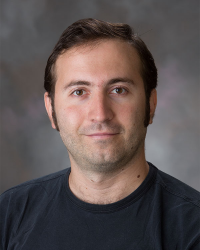 Christos Argyropoulos, and graduate
students Boyuan Jin and Dhananjay Mishra, published an article titled ‘‘Efficient
Single-Photon Pair Generation by Spontaneous Parametric Down-Conversion in Nonlinear Plasmonic
Metasurfaces” in the journal Nanoscale. Journal editors selected the paper to be featured
on the cover, an honor given to the best papers of each issue. (2/8/22)
Christos Argyropoulos, and graduate
students Boyuan Jin and Dhananjay Mishra, published an article titled ‘‘Efficient
Single-Photon Pair Generation by Spontaneous Parametric Down-Conversion in Nonlinear Plasmonic
Metasurfaces” in the journal Nanoscale. Journal editors selected the paper to be featured
on the cover, an honor given to the best papers of each issue. (2/8/22)
Top Sponsored Awards, December 2021
 Top sponsored
awards are awards from public entities including all arts and humanities grants of $10,000 or
more and all other grants of $200,000 or more between Nov. 16 and Dec. 15, 2021, as reported
through NUgrant.
Top sponsored
awards are awards from public entities including all arts and humanities grants of $10,000 or
more and all other grants of $200,000 or more between Nov. 16 and Dec. 15, 2021, as reported
through NUgrant.
Wei Bao; $756,713; National Science Foundation; CAREER: Towards
Room-Temperature Quantum Simulators Enabled by Halide Perovskites (2/8/22)
Second Hong "Nano Matters" podcast interview released
 A second
podcast interview between Xia Hong and Lisa Friedersdorf, Director
of the National Nanotechnology Coordination Office has been released on YouTube. In this episode,
Hong describes how she and her team are creating and studying complex oxide nanostructures and
interfaces for advanced electronics. (2/2/22)
A second
podcast interview between Xia Hong and Lisa Friedersdorf, Director
of the National Nanotechnology Coordination Office has been released on YouTube. In this episode,
Hong describes how she and her team are creating and studying complex oxide nanostructures and
interfaces for advanced electronics. (2/2/22)
Yang team working to improve strength, color of feather-based fibers
 A team
led by Yiqi Yang is developing a process that would transform
chicken feathers - largely considered a waste product of chicken production - into fibers that
find a place in natural fabrics. In a
recent study, Yang’s team experimented with a cross-linking class known as saccharide
aldehydes. By modifying the molecular structure and concentration of the aldehydes, the team
developed keratin fibers substantially stronger than those produced via another popular
cross-linker, citric acid. (1/12/22)
A team
led by Yiqi Yang is developing a process that would transform
chicken feathers - largely considered a waste product of chicken production - into fibers that
find a place in natural fabrics. In a
recent study, Yang’s team experimented with a cross-linking class known as saccharide
aldehydes. By modifying the molecular structure and concentration of the aldehydes, the team
developed keratin fibers substantially stronger than those produced via another popular
cross-linker, citric acid. (1/12/22)
U.S.-Issued Patents, July-December 2021
 The following list includes all U.S.-issued patents granted by the U.S.
Patent and Trademark Office to University of Nebraska-Lincoln researchers from July 1, 2021, to
Dec. 31, 2021, as reported by NUtech Ventures.
The following list includes all U.S.-issued patents granted by the U.S.
Patent and Trademark Office to University of Nebraska-Lincoln researchers from July 1, 2021, to
Dec. 31, 2021, as reported by NUtech Ventures.
Oxygen Reactive Polymers for Treatment of Traumatic Brain Injury; Forrest Kievit, P. Stayton, M. Ypma, P. Chiarelli, J. S. H. Park, R.
Ellenbogen, J. M. Xu, P. Mourad, D. Lee, A. Convertine; Issued July 20, 2021
Expedited PCR with Stirring; Hendrik J. Viljoen; Issued
Oct. 26, 2021
Methods of Making and Using Lignin Derivatives; Barry
Cheung, M. A. Helle; Issued Oct. 26, 2021
Substrate Delivery of Embedded Liposomes; Srivatsan
Kidambi, S. L. Hayward; Issued Dec. 21, 2021 (1/11/22)
Top Sponsored Awards, November 2021
 Top sponsored awards are awards from public entities including all arts
and humanities grants of $10,000 or more and all other grants of $200,000 or more between Oct.
16 and Nov. 15, 2021, as reported through NUgrant.
Top sponsored awards are awards from public entities including all arts
and humanities grants of $10,000 or more and all other grants of $200,000 or more between Oct.
16 and Nov. 15, 2021, as reported through NUgrant.
James Takacs, J. Checco, J. Clarke, E. Dodds, C. Eichhorn, J. Guo,
Rebecca Lai, M. Morton, W. Niu, R. Powers, J. Riethoven, M. Wilson,
Y. Zhou; $10,667,732; U.S. Department of Health and Human Services-National Institute of
General Medical Sciences; Nebraska Center for Integrated Biomolecular Communication, Phase
2
Shannon Bartelt-Hunt; $326,090; Nebraska Department of
Health and Human Services; NWSS Laboratory Workplan
Jian Wang; $333,267; National Science Foundation; A Metamodeling
Framework for Multiscale Mechanical Modeling of Nano-Architectural Crystalline-Amorphous
Composites (1/11/22)
Accolades, December 2021
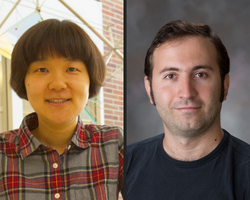 Xia Hong was featured on the podcast
“NanoTube,” which is produced by the National Nanotechnology Initiative. During the
episode, Hong described her work investigating the properties of complex oxide nanostructures
and interfaces.
Xia Hong was featured on the podcast
“NanoTube,” which is produced by the National Nanotechnology Initiative. During the
episode, Hong described her work investigating the properties of complex oxide nanostructures
and interfaces.
Christos Argyropoulos, along with co-author Yang Li of Nanjing University of Information
Science and Technology, published “Multiqubit entanglement and quantum phase gates with epsilon-near-zero
plasmonic waveguides,” an article that was selected as an Editor’s Pick by the editors at
Applied Physics Letters. Editor’s Picks are selected to highlight noteworthy articles that have
excellent scientific quality. (1/11/22)
Tsymbal team's data-decoding approach could lead to faster, smaller digital tech
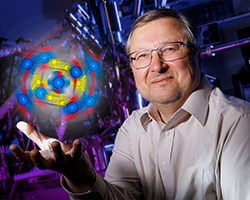 Evgeny Tsymbal and colleagues have
published a new study showing that spin-independent conductance in compensated antiferromagnets
and normal metals can be efficiently exploited in spintronics. The team identified ruthenium
oxide as just such an antiferromagnet, as well as titanium dioxide as the barrier through which
electrons can tunnel. Critically, the atoms of the two respective oxides form the same
crystalline structure, resulting in a seamless match that allows electrons to maintain their
momentum — and their momentum-dependent spin — as they move between the materials. This
research was supported, in part, from the National Science Foundation's $20 million grant
facilitating Nebraska's EPSCoR-EQUATE project.
(1/6/22)
Evgeny Tsymbal and colleagues have
published a new study showing that spin-independent conductance in compensated antiferromagnets
and normal metals can be efficiently exploited in spintronics. The team identified ruthenium
oxide as just such an antiferromagnet, as well as titanium dioxide as the barrier through which
electrons can tunnel. Critically, the atoms of the two respective oxides form the same
crystalline structure, resulting in a seamless match that allows electrons to maintain their
momentum — and their momentum-dependent spin — as they move between the materials. This
research was supported, in part, from the National Science Foundation's $20 million grant
facilitating Nebraska's EPSCoR-EQUATE project.
(1/6/22)
Hong featured on "Stories from the NNI" podcast
 A podcast
interview between Xia Hong and Lisa Friedersdorf, Director of the
National Nanotechnology Coordination Office has been released online. In this episode, Hong
discusses her work investigating the properties of complex oxide nanostructures and interfaces.
The podcast interview is available on YouTube. (12/16/21)
A podcast
interview between Xia Hong and Lisa Friedersdorf, Director of the
National Nanotechnology Coordination Office has been released online. In this episode, Hong
discusses her work investigating the properties of complex oxide nanostructures and interfaces.
The podcast interview is available on YouTube. (12/16/21)
Markvicka, Gay in the national news: November 2021
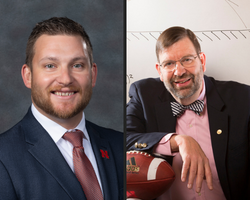 For Eric Markvicka and colleagues, droplets of liquid metal are emerging as
a protagonist in the quest to dissipate heat — and prevent overheating — in wearable
technology, soft robotics and other microelectronic-packed applications. Phys.org and Technology.org ran articles on the research.
For Eric Markvicka and colleagues, droplets of liquid metal are emerging as
a protagonist in the quest to dissipate heat — and prevent overheating — in wearable
technology, soft robotics and other microelectronic-packed applications. Phys.org and Technology.org ran articles on the research.
Tim Gay was featured in a recent NFL Films video.
He discussed the physics behind a well-thrown football pass. (12/3/21)
NCMN faculty/staff receive Celebration of Service awards
 The following NCMN faculty and staff were honored at the 2021 Celebration
of Service, which celebrates faculty and staff employed with the University in five-year
increments.
The following NCMN faculty and staff were honored at the 2021 Celebration
of Service, which celebrates faculty and staff employed with the University in five-year
increments.
Shield and team look to boost heat transfer of copper
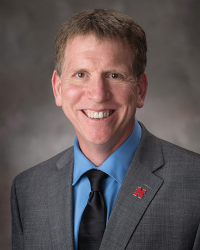 Jeff Shield and colleagues have been investigating how to improve the heat
transfer of copper used in pool boiling. In a new
study, the team increased the surface area of copper by firing 4-picosecond-long laser
pulses at it. However, this also coated the surface with oxides that curbed the otherwise
improved heat transfer. So the team tried cleaning the surface with different acids, and found
that citric acid worked best, but only when the number of laser pulses remained below a certain
threshold. (11/15/21)
Jeff Shield and colleagues have been investigating how to improve the heat
transfer of copper used in pool boiling. In a new
study, the team increased the surface area of copper by firing 4-picosecond-long laser
pulses at it. However, this also coated the surface with oxides that curbed the otherwise
improved heat transfer. So the team tried cleaning the surface with different acids, and found
that citric acid worked best, but only when the number of laser pulses remained below a certain
threshold. (11/15/21)
Markvicka team's design could curb overheating, up performance of soft electronics
 A new study from a team led by Eric
Markvicka has shown that embedding a silicone material with gallium-based droplets — and,
crucially, embedding those droplets with microscopic spheres of hollow glass — can mostly
retain the boost in heat dissipation without sacrificing the material’s lightweight pliability.
This design could greatly impact things like the computing power of microelectronics and
thermoregulatory garments. Markvicka's team included NCMN members Sangjin
Ryu and Jeff Shield. (11/15/21)
A new study from a team led by Eric
Markvicka has shown that embedding a silicone material with gallium-based droplets — and,
crucially, embedding those droplets with microscopic spheres of hollow glass — can mostly
retain the boost in heat dissipation without sacrificing the material’s lightweight pliability.
This design could greatly impact things like the computing power of microelectronics and
thermoregulatory garments. Markvicka's team included NCMN members Sangjin
Ryu and Jeff Shield. (11/15/21)
Advancing the Second Quantum Revolution
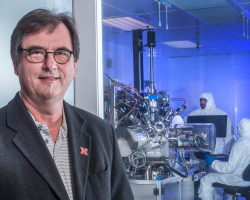 A feature story in the 2020-2021 Nebraska Research
Report described the Emergent Quantum
Materials and Technologies (EQUATE) collaboration, made possible by a five-year, $20
million award from the National Science Foundation. The EQUATE project is a key component to
achieving the goals of Nebraska's Quantum Science and Engineering Grand Challenge. (11/9/21)
A feature story in the 2020-2021 Nebraska Research
Report described the Emergent Quantum
Materials and Technologies (EQUATE) collaboration, made possible by a five-year, $20
million award from the National Science Foundation. The EQUATE project is a key component to
achieving the goals of Nebraska's Quantum Science and Engineering Grand Challenge. (11/9/21)
NNF featured in Annual Research Report
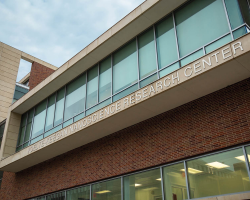 The Nebraska Nanoscale Facility was the star of a feature story in
the 2020-2021 Nebraska
Research Report. The story highlights the importance of the facility for advancing academic
and industry nanoscience research in the Midwest, the success the facility saw in it's first
five years, and the education and outreach activities that are key to the facility's mission.
(11/9/21)
The Nebraska Nanoscale Facility was the star of a feature story in
the 2020-2021 Nebraska
Research Report. The story highlights the importance of the facility for advancing academic
and industry nanoscience research in the Midwest, the success the facility saw in it's first
five years, and the education and outreach activities that are key to the facility's mission.
(11/9/21)
Annual Research Report Highlights
 Siamek Nejati, James Takacs, and David Hage were all featured
in the 2020-2021 Nebraska
Research Report. Nejati received a CAREER award for his work on building 3D porous organic
frameworks. Takacs was named an American Association for the Advancement of Science Fellow in
2020; he was recognized for contributions to synthetic organic chemistry. And Hage earned the
2021 ACS Award in Chromatography from the American Chemical Society. (11/9/21)
Siamek Nejati, James Takacs, and David Hage were all featured
in the 2020-2021 Nebraska
Research Report. Nejati received a CAREER award for his work on building 3D porous organic
frameworks. Takacs was named an American Association for the Advancement of Science Fellow in
2020; he was recognized for contributions to synthetic organic chemistry. And Hage earned the
2021 ACS Award in Chromatography from the American Chemical Society. (11/9/21)
EQUATE Awards SEED Grants
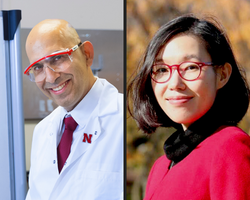 Siamak
Nejati and Yanan (Laura) Wang were awarded SEED grants from
the EQUATE project to study quantum topics in their research. Nejati proposed “Heterostructures
of 2D Materials and Porphyrin-Based Covalent Organic Frameworks as a Tunable Device Platform
for Quantum Technologies," and will work with Alexander
Sinitskii on this research. Wang proposed “Dynamic Control of 2D Single-Photon Quantum
Emitters via Strain Engineering,” and will work with Christo
Argyropoulos. Both researchers will receive $56,000 for their projects. (11/4/21)
Siamak
Nejati and Yanan (Laura) Wang were awarded SEED grants from
the EQUATE project to study quantum topics in their research. Nejati proposed “Heterostructures
of 2D Materials and Porphyrin-Based Covalent Organic Frameworks as a Tunable Device Platform
for Quantum Technologies," and will work with Alexander
Sinitskii on this research. Wang proposed “Dynamic Control of 2D Single-Photon Quantum
Emitters via Strain Engineering,” and will work with Christo
Argyropoulos. Both researchers will receive $56,000 for their projects. (11/4/21)
Markvicka named Emerging Innovator of the Year
 Eric Markvicka received the Emerging
Innovator of the Year award at NUtech Ventures 2021 Innovator Awards, held as part of Nebraska
Research Days. The award recognizes an individual, often a junior faculty member, for recent
innovation contributions. Markvicka’s research, positioned at the intersection of computer and materials
science, aims to transform how materials interact with the human body and the external
environment. His systems have applications for wearable biosensors, soft robotics, and
multifunctional materials. (11/3/21)
Eric Markvicka received the Emerging
Innovator of the Year award at NUtech Ventures 2021 Innovator Awards, held as part of Nebraska
Research Days. The award recognizes an individual, often a junior faculty member, for recent
innovation contributions. Markvicka’s research, positioned at the intersection of computer and materials
science, aims to transform how materials interact with the human body and the external
environment. His systems have applications for wearable biosensors, soft robotics, and
multifunctional materials. (11/3/21)
Tan, Sealy join NSF I-Corps Program
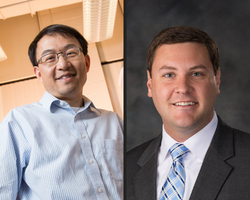 Li Tan and Michael
Sealy served as faculty leads for two of three Nebraska teams that joined the National
Science Foundation's 2021 Innovation Corps. The I-Corps program uses
experiential education to help researchers gain valuable insight into starting a business and
industry requirements and challenges. During the program Husker researchers, along with
graduate students and business mentors, learned entrepreneurship concepts, explored technology
commercialization and conducted 100 interviews with prospective customers. (10/27/21)
Li Tan and Michael
Sealy served as faculty leads for two of three Nebraska teams that joined the National
Science Foundation's 2021 Innovation Corps. The I-Corps program uses
experiential education to help researchers gain valuable insight into starting a business and
industry requirements and challenges. During the program Husker researchers, along with
graduate students and business mentors, learned entrepreneurship concepts, explored technology
commercialization and conducted 100 interviews with prospective customers. (10/27/21)
Nebraska students win NNCI image contest
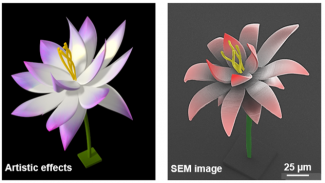 'A
Micro Blooming Lotus,' the image submitted by Aofei Mao and Peixun Fan to the National
Nanotechnology Coordinated Infrastructure's (NNCI) Plenty of Beauty at the Bottom image
contest, was the winning entry in the Most Stunning category. The contest is held yearly in
honor of National Nanotechnology Day and winning artists will receive up to $1,000 in travel
support to a professional conference of their choice. (10/25/21)
'A
Micro Blooming Lotus,' the image submitted by Aofei Mao and Peixun Fan to the National
Nanotechnology Coordinated Infrastructure's (NNCI) Plenty of Beauty at the Bottom image
contest, was the winning entry in the Most Stunning category. The contest is held yearly in
honor of National Nanotechnology Day and winning artists will receive up to $1,000 in travel
support to a professional conference of their choice. (10/25/21)
Saraf advances work on first-of-its-kind ‘living’ transistor chip
 Ravi Saraf and his team are one step closer to developing a new kind of
transistor chip that harnesses the biological responses of living organisms to drive current
through the device, shedding light on cellular activity at an unprecedented level of
sensitivity. Eventually, this “living” chip may enable faster and simpler diagnosis of sepsis,
illuminate understanding of antibiotic resistance and bolster efforts to develop neuromorphic
devices, which mimic the human brain. (10/11/21)
Ravi Saraf and his team are one step closer to developing a new kind of
transistor chip that harnesses the biological responses of living organisms to drive current
through the device, shedding light on cellular activity at an unprecedented level of
sensitivity. Eventually, this “living” chip may enable faster and simpler diagnosis of sepsis,
illuminate understanding of antibiotic resistance and bolster efforts to develop neuromorphic
devices, which mimic the human brain. (10/11/21)
Zeng's simulations show dissolved salt reassembling at the nanoscale
 Xiao Cheng Zeng and colleagues recently ran computer simulations to
determine how sodium chloride and lithium chloride might respond when submerged in a nanoscopic
stream of water bordered by two smooth, water-repellent walls. The findings suggest that, when
confined to a nanoscopic space, sodium and chlorine atoms can reassemble after being dissolved.
The team's simulations also found the same with lithium and chlorine atoms. (10/1/21)
Xiao Cheng Zeng and colleagues recently ran computer simulations to
determine how sodium chloride and lithium chloride might respond when submerged in a nanoscopic
stream of water bordered by two smooth, water-repellent walls. The findings suggest that, when
confined to a nanoscopic space, sodium and chlorine atoms can reassemble after being dissolved.
The team's simulations also found the same with lithium and chlorine atoms. (10/1/21)
Top Sponsored Awards, August 2021
 Top
sponsored awards are awards from public entities including all arts and humanities grants of
$10,000 or more and all other grants of $200,000 or more between July 16 and August 15, 2021,
as reported through NUgrant.
Top
sponsored awards are awards from public entities including all arts and humanities grants of
$10,000 or more and all other grants of $200,000 or more between July 16 and August 15, 2021,
as reported through NUgrant.
Hong team develop technique to measure anisotropy of rhenium disulfide
 Xia Hong and colleagues (including Evgeny
Tsymbal and Stephen Ducharme) have developed a new technique
that allows them to study and more precisely measure the anisotropy of a promising
semiconductor - rhenium disulfide. By layering a ferroelectric polymer atop the rhenium
disulfide, then flipping the polarization of a narrow sliver within the polymer, the team
discovered that rhenium disulfide’s conductivity greatly depends on the orientation of the path
itself. They also found the anisotropy was largest when measuring it in rhenium disulfide that
was four atomic layers thick. (9/22/21)
Xia Hong and colleagues (including Evgeny
Tsymbal and Stephen Ducharme) have developed a new technique
that allows them to study and more precisely measure the anisotropy of a promising
semiconductor - rhenium disulfide. By layering a ferroelectric polymer atop the rhenium
disulfide, then flipping the polarization of a narrow sliver within the polymer, the team
discovered that rhenium disulfide’s conductivity greatly depends on the orientation of the path
itself. They also found the anisotropy was largest when measuring it in rhenium disulfide that
was four atomic layers thick. (9/22/21)
Cheung team develops more durable hemp-based biocomposite for hydroponics
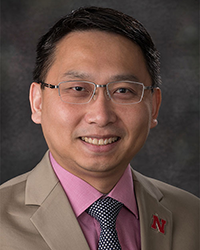 Barry Cheung and colleagues recently introduced an approach that
chemically couples a structure-granting component of hemp fibers, lignin, with “linking
molecules” that fortify the resulting biocomposite. Unlike prior techniques, the team’s
approach requires only water as a solvent, yielding harmless inorganic salts rather than VOCs
as byproducts. Mechanical testing revealed that the new biocomposite is more durable than a
standard hemp-based counterpart, holding its shape far better when subjected to compressive
forces. It can also hold roughly twice as much water as pure hemp fiber, putting its capacity
nearly on par with commercial peat moss. (9/15/21)
Barry Cheung and colleagues recently introduced an approach that
chemically couples a structure-granting component of hemp fibers, lignin, with “linking
molecules” that fortify the resulting biocomposite. Unlike prior techniques, the team’s
approach requires only water as a solvent, yielding harmless inorganic salts rather than VOCs
as byproducts. Mechanical testing revealed that the new biocomposite is more durable than a
standard hemp-based counterpart, holding its shape far better when subjected to compressive
forces. It can also hold roughly twice as much water as pure hemp fiber, putting its capacity
nearly on par with commercial peat moss. (9/15/21)
Bartelt-Hunt selected for Big Ten leadership program
 Shannon Bartelt-Hunt is one of 11
faculty selected by the Office of the Executive Vice Chancellor to participate in a Big Ten
Academic Alliance leadership program this year. Bartelt-Hunt was chosen for the Department
Executive Officers Progam, where fellows will attend a virtual program to learn about
leadership at a departmental level, including unique perspectives and challenges regarding
faculty development, performance, communication, conflict resolution, time management, and
mentoring. (9/13/21)
Shannon Bartelt-Hunt is one of 11
faculty selected by the Office of the Executive Vice Chancellor to participate in a Big Ten
Academic Alliance leadership program this year. Bartelt-Hunt was chosen for the Department
Executive Officers Progam, where fellows will attend a virtual program to learn about
leadership at a departmental level, including unique perspectives and challenges regarding
faculty development, performance, communication, conflict resolution, time management, and
mentoring. (9/13/21)
Hong, Wang, selected for Research Leaders Program
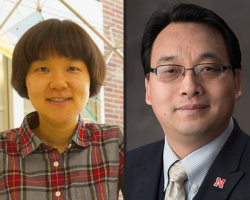 Xia Hong
and Jian Wang are among 15 faculty members selected for the second
cohort of ORED's Research
Leader's Program. These research-active faculty will learn the information, skills and
connections needed to assemble and lead teams in the pursuit of major extramural funding.
(9/7/21)
Xia Hong
and Jian Wang are among 15 faculty members selected for the second
cohort of ORED's Research
Leader's Program. These research-active faculty will learn the information, skills and
connections needed to assemble and lead teams in the pursuit of major extramural funding.
(9/7/21)
Argyropoulos named senior member of SPIE
 Christos Argyropoulous has been named a senior member of
SPIE, the international society for optics and photonics. Senior members are honored for their
scientific excellence across the broad spectrum of optics and photonics research and
applications, their active involvement with the optics community and SPIE, and significant
performance that distinguishes them. Argyropoulos is the principal investigator for Nebraska’s
Plasmonics, Metamaterials, and Integrated Nanophotonics Lab. (9/6/21)
Christos Argyropoulous has been named a senior member of
SPIE, the international society for optics and photonics. Senior members are honored for their
scientific excellence across the broad spectrum of optics and photonics research and
applications, their active involvement with the optics community and SPIE, and significant
performance that distinguishes them. Argyropoulos is the principal investigator for Nebraska’s
Plasmonics, Metamaterials, and Integrated Nanophotonics Lab. (9/6/21)
Top Sponsored Awards, July 2021
 Top sponsored awards are awards from public entities including all arts
and humanities grants of $10,000 or more and all other grants of $200,000 or more between June
16 and July 15, 2021, as reported through NUgrant.
Top sponsored awards are awards from public entities including all arts
and humanities grants of $10,000 or more and all other grants of $200,000 or more between June
16 and July 15, 2021, as reported through NUgrant.
Alexander Sinitskii; $627,324; University of Pittsburgh;
Topological Spin Qubits Based on Graphene Nanoribbons
David Hage, D. Snow; $400,000; National Science Foundation;
Ultrafast Affinity Extraction Fundamental Studies and Use in Environmental
Applications
Prahalada Rao, K. Cole; $250,000; National Science Foundation;
UFAST: Ultrafast Additive Simulation Technology (9/3/21)
John earns NNCI Outstanding Staff Award
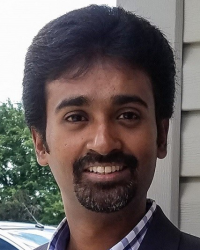 Jacob John,
Coordinator and Program Manager of the Nebraska Nanoscale
Facility, has been awarded a 2021 Outstanding NNCI Staff Member award in the category of
'User Support.' The awards, presented by the National Nanotechnology Coordinated Infrastructure (NNCI), acknowledge the
significant efforts by NNCI site staff members who endeavor to provide excellent service and
support to all network users. (8/20/21)
Jacob John,
Coordinator and Program Manager of the Nebraska Nanoscale
Facility, has been awarded a 2021 Outstanding NNCI Staff Member award in the category of
'User Support.' The awards, presented by the National Nanotechnology Coordinated Infrastructure (NNCI), acknowledge the
significant efforts by NNCI site staff members who endeavor to provide excellent service and
support to all network users. (8/20/21)
Kidambi, Sealy named Governance and Technology Center fellows
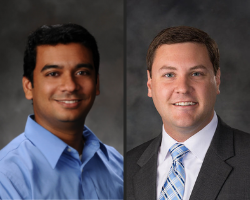 Srivatsan Kidambi and Michael Sealy were
named to the second class of the Nebraska
Governance and Technology Center's faculty fellows. The fellows are academics with an
interdisciplinary inclination who are interested in the challenges of changing technology. The
goal of the program is to develop a cohort of academics who are able to understand - and
effectively communicate about - technology challenges in interdisciplinary terms. (8/10/21)
Srivatsan Kidambi and Michael Sealy were
named to the second class of the Nebraska
Governance and Technology Center's faculty fellows. The fellows are academics with an
interdisciplinary inclination who are interested in the challenges of changing technology. The
goal of the program is to develop a cohort of academics who are able to understand - and
effectively communicate about - technology challenges in interdisciplinary terms. (8/10/21)
Haghshenas Fatmehsari team looking at corn, soybean oil to recycle asphalt
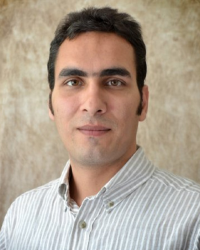 Hamzeh Haghshenas Fatmehsari and colleagues are studying the efficacy
of using corn and soybean oil in the process of recycling asphalt. The rising cost and
environmental impact of using crude oil in the process prompted Haghshenas Fatmehsari to
explore greener alternatives. He knew that vegetable oils, specifically corn and soybean oil,
were great options for recycling asphalt in the short term. Now he and his team are trying to
improve the long-term performance of the recycled asphalt pavement (RAP) material containing
these oils. (8/4/21)
Hamzeh Haghshenas Fatmehsari and colleagues are studying the efficacy
of using corn and soybean oil in the process of recycling asphalt. The rising cost and
environmental impact of using crude oil in the process prompted Haghshenas Fatmehsari to
explore greener alternatives. He knew that vegetable oils, specifically corn and soybean oil,
were great options for recycling asphalt in the short term. Now he and his team are trying to
improve the long-term performance of the recycled asphalt pavement (RAP) material containing
these oils. (8/4/21)
Top Sponsored Awards, June 2021
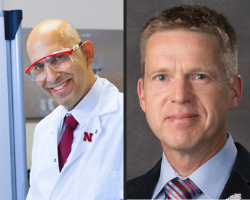 Top Sponsored Awards include
awards from public entities includes all arts and humanities grants of $10,000 or more and all
other grants of $200,000 or more between May 16 and June 15, 2021, as reported
through NUgrant:
Top Sponsored Awards include
awards from public entities includes all arts and humanities grants of $10,000 or more and all
other grants of $200,000 or more between May 16 and June 15, 2021, as reported
through NUgrant:
Siamek Nejati; $593,240; National Science Foundation; CAREER: Molecular Layer Deposition of Porous Organic Frameworks
Mathias Schubert and R. Korlacki; $499,987; U.S. Department
of Defense-Air Force Office of Scientific Research; Terahertz Electron Paramagnetic
Resonance Ellipsometry Defect Characterization in Ultrawideband Gap Monoclinic Gallium Oxide
and Related Alloys
(7/30/21)
Binek, Pannier on Grand Challenges steering committee
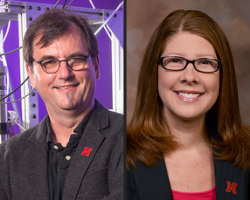 Christian
Binek and Angela Pannier have been selected for a steering
committee created to guide the next steps of the University of Nebraska-Lincoln's Grand Challenges process. “This
committee will serve as a bridge from the N2025 Strategic Plan
to the development of a process for implementing our Grand Challenges,” said Rick Bevins,
committee co-chair. “In our first meeting, it was clear that the members care deeply and will
work hard to ensure success.” (7/30/21)
Christian
Binek and Angela Pannier have been selected for a steering
committee created to guide the next steps of the University of Nebraska-Lincoln's Grand Challenges process. “This
committee will serve as a bridge from the N2025 Strategic Plan
to the development of a process for implementing our Grand Challenges,” said Rick Bevins,
committee co-chair. “In our first meeting, it was clear that the members care deeply and will
work hard to ensure success.” (7/30/21)
Lu team develop method to guard carbon fiber against oxidation
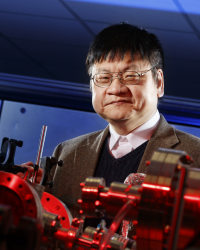 Yongfeng Lu and colleagues have developed a low-cost, scalable method of
protecting carbon fibers from oxidation when exposed to extreme temperatures. They found that
dipping carbon fibers into a molten salt mixture containing titanium and chromium powders
triggers a spontaneous reaction that leaves the fibers with a three-layer protective coating.
The coated carbon fibers remained undamaged when exposed to 2,200 degrees Fahrenheit and
extreme environmental conditions simulated with an oxyacetylene flame. Bai Cui is also involved in this research. (7/26/21)
Yongfeng Lu and colleagues have developed a low-cost, scalable method of
protecting carbon fibers from oxidation when exposed to extreme temperatures. They found that
dipping carbon fibers into a molten salt mixture containing titanium and chromium powders
triggers a spontaneous reaction that leaves the fibers with a three-layer protective coating.
The coated carbon fibers remained undamaged when exposed to 2,200 degrees Fahrenheit and
extreme environmental conditions simulated with an oxyacetylene flame. Bai Cui is also involved in this research. (7/26/21)
Pannier named inaugural Swarts Family Chair
 Angela Pannier has been named the University of Nebraska–Lincoln’s
inaugural Swarts Family Chair in Biological Systems Engineering. The named chair is an honor
decades in the making, taking root in 1997 when a scholarship gift sparked a friendship between
Pannier (then an engineering student) and Dr. Carol Swarts, a pioneering Nebraska physician. “I
am humbled and grateful that I not only get to hold the endowed chair, but I get to hold the
Swarts family endowed chair, endowed by a person who has meant and continues to mean so much to
me,” Pannier said. (7/20/21)
Angela Pannier has been named the University of Nebraska–Lincoln’s
inaugural Swarts Family Chair in Biological Systems Engineering. The named chair is an honor
decades in the making, taking root in 1997 when a scholarship gift sparked a friendship between
Pannier (then an engineering student) and Dr. Carol Swarts, a pioneering Nebraska physician. “I
am humbled and grateful that I not only get to hold the endowed chair, but I get to hold the
Swarts family endowed chair, endowed by a person who has meant and continues to mean so much to
me,” Pannier said. (7/20/21)
Nejati earns CAREER award
 Siamak Nejati has received a five-year, $593,240 Faculty Early Career
Development Program grant from the National Science Foundation to build on his previous
research on molecular structures. The goal of Nejati’s CAREER project is to realize a new green
pathway that enables the high-precision deposition of ultra-thin porous and covalent organic
frameworks. He will use a molecular layer deposition approach to construct films that feature a
wide and tunable range of porosity in a solvent-free coating process. (7/16/21)
Siamak Nejati has received a five-year, $593,240 Faculty Early Career
Development Program grant from the National Science Foundation to build on his previous
research on molecular structures. The goal of Nejati’s CAREER project is to realize a new green
pathway that enables the high-precision deposition of ultra-thin porous and covalent organic
frameworks. He will use a molecular layer deposition approach to construct films that feature a
wide and tunable range of porosity in a solvent-free coating process. (7/16/21)
NCMN Faculty receive Layman Awards
 The Office of Research and Economic Development has announced the
recipients of its 2021-22 Layman Awards program, which funds work that enhances a researcher’s
ability to obtain external funding to support prominent scholarship.
The Office of Research and Economic Development has announced the
recipients of its 2021-22 Layman Awards program, which funds work that enhances a researcher’s
ability to obtain external funding to support prominent scholarship.
Robert Streubel received an award through the Layman Seed
Program track, which funds new projects by early-career faculty who are nontenured. Shireen Adenwalla and Gustavo Larsen
received their awards through the New Directions Program tract, which funds tenured faculty who
are branching into new research directions or need funding to support pilot or developmental
work toward the next step in a funded research program. (7/2/21)
Top Sponsored Awards, May 2021
 Top Sponsored
Awards include awards from public entities includes all arts and humanities grants of $10,000
or more and all other grants of $200,000 or more between April 16 and May 15, 2021, as reported
through NUgrant:
Top Sponsored
Awards include awards from public entities includes all arts and humanities grants of $10,000
or more and all other grants of $200,000 or more between April 16 and May 15, 2021, as reported
through NUgrant:
Rebecca Lai; $339,325; University of Connecticut; A Wireless,
Closed-Loop Neural Probe for Optogenetics, Pharmacology and Neurochemical Monitoring
(7/2/21)
U.S.-Issued Patents, April-June 2021
 The following includes U.S.-issued patents granted by the U.S. Patent and
Trademark Office to University of Nebraska-Lincoln researchers from April 1, 2021, to June 30,
2021, as reported by NUtech Ventures:
The following includes U.S.-issued patents granted by the U.S. Patent and
Trademark Office to University of Nebraska-Lincoln researchers from April 1, 2021, to June 30,
2021, as reported by NUtech Ventures:
- Portable Laparoscope System; Dennis Alexander, C. Are, M. Are; 11,006,818
- Fast Spin-Polarized Electron Source; Timothy Gay, Herman Batelaan, E. Brunkow, E. Jones; 11,011,337
- Control of Change of Phase Through Physical Surface Shaping; Dennis Alexander, Sidy Ndao, G. Gogos, T. Anderson, C. Zuhlke; 11,047,053
(7/1/21)
Sellmyer honored with endowed chair
 David Sellmyer has been recognized for his achievements at Nebraska with
an endowed faculty chair named in his honor. The David J. Sellmyer Chair in Condensed Matter
Physics was established with a gift from John Woollam to the
University of Nebraska Foundation. The Sellmyer Chair will be used to recruit faculty members
with a strong publication record, proven effectiveness in building experimental collaborations,
and success in securing collaborative grants. Additionally, the chair holder will grow the
stature of the condensed-matter physics program, be dedicated to mentoring graduate students,
and promote excellent physics education at all levels. (6/24/21)
David Sellmyer has been recognized for his achievements at Nebraska with
an endowed faculty chair named in his honor. The David J. Sellmyer Chair in Condensed Matter
Physics was established with a gift from John Woollam to the
University of Nebraska Foundation. The Sellmyer Chair will be used to recruit faculty members
with a strong publication record, proven effectiveness in building experimental collaborations,
and success in securing collaborative grants. Additionally, the chair holder will grow the
stature of the condensed-matter physics program, be dedicated to mentoring graduate students,
and promote excellent physics education at all levels. (6/24/21)
Skomski receives REPM 2021 award
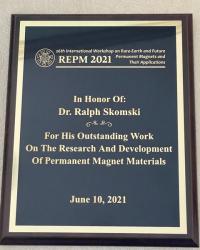 Ralph
Skomski was honored with an REPM award at the 26th International Workshop on Rare-Earth and
Future Permanent Magnets and their Applications. The award recognizes Skomski for his
outstanding work on the research and development of permanent magnet materials. (6/10/21)
Ralph
Skomski was honored with an REPM award at the 26th International Workshop on Rare-Earth and
Future Permanent Magnets and their Applications. The award recognizes Skomski for his
outstanding work on the research and development of permanent magnet materials. (6/10/21)
EQUATE project feature of WebMD article
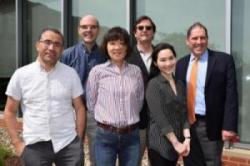 The
EPSCoR-EQUATE project (funded by a $20 million NSF grant) was the topic of a recent WebMD news article. The article highlighted Nebraska's unique position in
the 'Silicon Prairie' to build a qualified workforce of quantum experts between the coasts.
Christian Binek was interviewed and discussed the importance of the
quantum science revolution and some of the advances in electronics, lasers, and medicine this
grant will support. (6/9/21)
The
EPSCoR-EQUATE project (funded by a $20 million NSF grant) was the topic of a recent WebMD news article. The article highlighted Nebraska's unique position in
the 'Silicon Prairie' to build a qualified workforce of quantum experts between the coasts.
Christian Binek was interviewed and discussed the importance of the
quantum science revolution and some of the advances in electronics, lasers, and medicine this
grant will support. (6/9/21)
Streubel team advances understanding, control of magnetic droplets
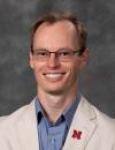 In 2019,
a team that included Robert Streubel managed to endow liquid
droplets with permanent magnetism, partly by embedding them with tens of billions of iron oxide
nanoparticles. Now, the team has shown the ability to tailor the magnetic properties of those
droplets in multiple ways. The researchers were especially interested in learning how to tailor
the magnetic properties of the droplets and, by extension, gain greater control over their
movement. See
the study. (6/8/21)
In 2019,
a team that included Robert Streubel managed to endow liquid
droplets with permanent magnetism, partly by embedding them with tens of billions of iron oxide
nanoparticles. Now, the team has shown the ability to tailor the magnetic properties of those
droplets in multiple ways. The researchers were especially interested in learning how to tailor
the magnetic properties of the droplets and, by extension, gain greater control over their
movement. See
the study. (6/8/21)
Recent publications: Streubel and Tsymbal
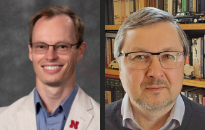 Robert Streubel and Evgeny Tsymbal are
co-authors of a perspective published in the Journal of Applied Physics titled, Magnetism in curved
geometries.
Robert Streubel and Evgeny Tsymbal are
co-authors of a perspective published in the Journal of Applied Physics titled, Magnetism in curved
geometries.
Streubel is also co-author of a study published in the Proceedings of the National Academy of
Sciences USA titled, Ferromagnetic liquid droplets with adjustable magnetic properties.
(6/1/21)
Morin demonstrates control over the transport of microscopic droplets
 By
stretching and relaxing their specially designed films, Nebraska chemists Stephen
Morin and Ali Mazaltarim have demonstrated unprecedented control over the movement of
liquid droplets on flat surfaces. That control could make the technique useful in self-cleaning
materials, water harvesting and other applications. See the
study. (5/28/21)
By
stretching and relaxing their specially designed films, Nebraska chemists Stephen
Morin and Ali Mazaltarim have demonstrated unprecedented control over the movement of
liquid droplets on flat surfaces. That control could make the technique useful in self-cleaning
materials, water harvesting and other applications. See the
study. (5/28/21)
Kim awarded Nebraska Environmental Trust grant
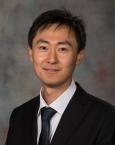 Seunghee Kim was one of 23 Nebraska researchers who received a 2021 grant from
the Nebraska Environmental
Trust. Kim received $196,467 for his work to assess greenhouse gas sequestration resources
in Districts 5, 6 and 7 to improve carbon management opportunities in Nebraska. (5/25/21)
Seunghee Kim was one of 23 Nebraska researchers who received a 2021 grant from
the Nebraska Environmental
Trust. Kim received $196,467 for his work to assess greenhouse gas sequestration resources
in Districts 5, 6 and 7 to improve carbon management opportunities in Nebraska. (5/25/21)
NCMN faculty named NSRI Fellows
 The National Strategic Research Institute at the University of Nebraska
has launched NSRI Fellows to amplify the university system’s research contributions to the
Department of Defense and other federal agencies with national security missions. The following
NCMN members are part of the inaugural group, featuring 31 University of Nebraska-Lincoln
faculty out of 74
researchers from across the NU system: David Berkowitz,
Chemistry; Rebecca Lai, Chemistry; Sy-Hwang
Liou, Physics & Astronomy; Eric Carnes, Chemical Engineering
at UNMC; Patrick Dussault, Chemistry. (5/20/21)
The National Strategic Research Institute at the University of Nebraska
has launched NSRI Fellows to amplify the university system’s research contributions to the
Department of Defense and other federal agencies with national security missions. The following
NCMN members are part of the inaugural group, featuring 31 University of Nebraska-Lincoln
faculty out of 74
researchers from across the NU system: David Berkowitz,
Chemistry; Rebecca Lai, Chemistry; Sy-Hwang
Liou, Physics & Astronomy; Eric Carnes, Chemical Engineering
at UNMC; Patrick Dussault, Chemistry. (5/20/21)
$20 million grant for EQUATE announced
 The University of Nebraska has received a five-year, $20 million award from the National
Science Foundation’s Established Program to Stimulate Competitive Research (EPSCoR) to create a
research and education cluster aimed at enhancing the state’s competitiveness in the field of
emergent quantum materials and technologies, and boosting the participating institutions’
research and education capacity. The Nebraska EPSCoR-Emergent Quantum Materials and
Technologies (EQUATE) collaboration will revolutionize quantum science and create opportunities
in education and through economic development. This announcement was also featured in the
Lincoln Journal Star. (5/24/21)
The University of Nebraska has received a five-year, $20 million award from the National
Science Foundation’s Established Program to Stimulate Competitive Research (EPSCoR) to create a
research and education cluster aimed at enhancing the state’s competitiveness in the field of
emergent quantum materials and technologies, and boosting the participating institutions’
research and education capacity. The Nebraska EPSCoR-Emergent Quantum Materials and
Technologies (EQUATE) collaboration will revolutionize quantum science and create opportunities
in education and through economic development. This announcement was also featured in the
Lincoln Journal Star. (5/24/21)
Binek named Charles Bessey professor of physics and astronomy
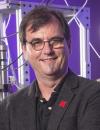 Christian Binek was one of six professors recently awarded professorship
from the Office of the Executive Vice-Chancellor. The Charles Bessey/Willa Cather professorship was established in 2001 to recognize
faculty members with the rank of professor who have established exceptional records of
distinguished scholarship or creative activity.
Christian Binek was one of six professors recently awarded professorship
from the Office of the Executive Vice-Chancellor. The Charles Bessey/Willa Cather professorship was established in 2001 to recognize
faculty members with the rank of professor who have established exceptional records of
distinguished scholarship or creative activity.
Binek is internationally recognized in the field of magneto-electric phenomena related to
spintronics, which explores and exploits the quantum spin on atoms, molecules, or assemblies as
the basis for a new generation of electronic and data storage devices. He has written 122
peer-reviewed papers, co-authored a textbook on thermodynamics, published a monograph on
Ising-Antiferromagnets, three book chapters, and five patents. Binek is involved with many
initiatives that pursue major grant-funded research objectives and regularly speaks at domestic
and international venues, including 2018 testimony on nanotechnology before a Congressional
Committee. Binek serves as director of the university’s Nebraska Nanoscale Facility and as
director of the Nebraska Center for Materials and Nanoscience. (5/10/21)
NCMN faculty receive promotion, tenure
 Promotion and tenure recipients for 2021 have been announced and include
the following NCMN faculty members: Promoted to Associate Professor and Granted
Tenure: Christos Argyropoulos, Electrical and
Computer Engineering; Michael Sealy, Mechanical and Materials
Engineering; Vitaly Alexandrov, Chemical and Biomolecular
Engineering. Promoted to Professor: Martin
Centurion, Physics and Astronomy. (4/26/21)
Promotion and tenure recipients for 2021 have been announced and include
the following NCMN faculty members: Promoted to Associate Professor and Granted
Tenure: Christos Argyropoulos, Electrical and
Computer Engineering; Michael Sealy, Mechanical and Materials
Engineering; Vitaly Alexandrov, Chemical and Biomolecular
Engineering. Promoted to Professor: Martin
Centurion, Physics and Astronomy. (4/26/21)
Morin to speak in MRS Webinar Series
 Stephen Morin will be speaking in a webinar on
'Materials Challenges in Soft Robotics' hosted by the Materials Research Society (MRS). The
webinar will take place on Wednesday, April 28 at 7 a.m. The event is free, but you must
register to attend. Register here. (4/26/21)
Stephen Morin will be speaking in a webinar on
'Materials Challenges in Soft Robotics' hosted by the Materials Research Society (MRS). The
webinar will take place on Wednesday, April 28 at 7 a.m. The event is free, but you must
register to attend. Register here. (4/26/21)
Pocket Science feature: Lu's lasers and flames
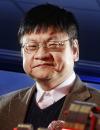 Yongfeng Lu and colleagues (including Rebecca Lai and Bai Cui) have shown how a laser can
modify chemical reactions taking place within a flame, allowing them to coat materials with
performance-enhancing chemicals while avoiding a side effect that reduces the performance of
semiconductors and other microelectronic components. View the study.
(4/23/21)
Yongfeng Lu and colleagues (including Rebecca Lai and Bai Cui) have shown how a laser can
modify chemical reactions taking place within a flame, allowing them to coat materials with
performance-enhancing chemicals while avoiding a side effect that reduces the performance of
semiconductors and other microelectronic components. View the study.
(4/23/21)
Binek to present for W2S webinar
 Christian Binek will present his topic, 'Voltage controlled Néel vector rotation in
zero magnetic field,' as part of the Webinar series on Spintronics hosted by the National
Institute of Science Education and Research Bhubaneswar in India. The webinar will take place
on April 21 at 11 p.m. CST. Please contact Dr. Subhankar Bedanta at sbedanta@niser.ac.in if you
would like to attend. (4/20/21)
Christian Binek will present his topic, 'Voltage controlled Néel vector rotation in
zero magnetic field,' as part of the Webinar series on Spintronics hosted by the National
Institute of Science Education and Research Bhubaneswar in India. The webinar will take place
on April 21 at 11 p.m. CST. Please contact Dr. Subhankar Bedanta at sbedanta@niser.ac.in if you
would like to attend. (4/20/21)
Hage, Yang receive Family and Friends Recognition Award
 David Hage and Ruiguo Yang are two of 75 recipients of the 2020-2021 Family and
Friends award. The Family and Friends Awards, formerly known as the Parents’ Recognition
Awards, recognize faculty and staff who have made a significant difference in students’ lives.
All nominations are submitted by parents, family and friends of students who include a short
explanation of why this person was nominated. This is a first-time award for both professors.
(4/12/21)
David Hage and Ruiguo Yang are two of 75 recipients of the 2020-2021 Family and
Friends award. The Family and Friends Awards, formerly known as the Parents’ Recognition
Awards, recognize faculty and staff who have made a significant difference in students’ lives.
All nominations are submitted by parents, family and friends of students who include a short
explanation of why this person was nominated. This is a first-time award for both professors.
(4/12/21)
Binek, Dowben, Gruverman team makes breakthrough with antiferromagnetic material
 After years of toil, a team led by Christian
Binek, Peter Dowben, and Alexei
Gruverman have developed a quantum material whose magnetic states can be altered by
electric means alone, and above room temperature. The antiferromagnetic material - chromium
oxide with a dash of boron - has properties that could make it a practical candidate for
drastically improving the power consumption and speed of digital memory. The study was published in
Nature Communications. (4/5/21)
After years of toil, a team led by Christian
Binek, Peter Dowben, and Alexei
Gruverman have developed a quantum material whose magnetic states can be altered by
electric means alone, and above room temperature. The antiferromagnetic material - chromium
oxide with a dash of boron - has properties that could make it a practical candidate for
drastically improving the power consumption and speed of digital memory. The study was published in
Nature Communications. (4/5/21)
Dishari receives 3M Award
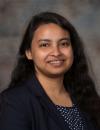 Shudipto Dishari has received
the 3M Non-Tenured Faculty Award for 2021. This highly competitive award recognizes the
outstanding young faculty across the U.S. who excel in STEM research, academic leadership and
experience, and is designed to help them achieve tenure by providing an unrestricted gift of
$15,000 per year for up to three years. (4/5/21)
Shudipto Dishari has received
the 3M Non-Tenured Faculty Award for 2021. This highly competitive award recognizes the
outstanding young faculty across the U.S. who excel in STEM research, academic leadership and
experience, and is designed to help them achieve tenure by providing an unrestricted gift of
$15,000 per year for up to three years. (4/5/21)
Ndao article in top 100 downloads in 2020
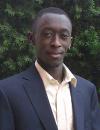 Sidy Ndao's article - NanoThermoMechanical AND and OR Logic Gates - received 2,191 downloads in
2020, placing it as one of the top 100 downloaded physics papers for Scientific Reports in
2020. The journal published more than 800 physics papers in 2020. (4/1/21)
Sidy Ndao's article - NanoThermoMechanical AND and OR Logic Gates - received 2,191 downloads in
2020, placing it as one of the top 100 downloaded physics papers for Scientific Reports in
2020. The journal published more than 800 physics papers in 2020. (4/1/21)
Iverson featured in "She's a Scientist" series
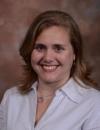 Nicole Iverson, assistant
professor of biological systems engineering, was featured in University Communications "She's a
Scientist" video series this week. Iverson is currently working to develop nanoscopic sensors
aimed at detecting earlier hints of disease at the cellular level. (3/26/21)
Nicole Iverson, assistant
professor of biological systems engineering, was featured in University Communications "She's a
Scientist" video series this week. Iverson is currently working to develop nanoscopic sensors
aimed at detecting earlier hints of disease at the cellular level. (3/26/21)
Lai featured in "She's a Scientist" series
 Rebecca Lai, associate professor of chemistry and Harry
Potter aficionado, is the second researcher to be featured in the "She's a Scientist" video
series produced by University Communications to celebrate Women's History Month. Lai is well
known for her unique teaching approach of combining Harry Potter with chemistry, associating
elements of the fictional world with real-life applications. (3/12/21)
Rebecca Lai, associate professor of chemistry and Harry
Potter aficionado, is the second researcher to be featured in the "She's a Scientist" video
series produced by University Communications to celebrate Women's History Month. Lai is well
known for her unique teaching approach of combining Harry Potter with chemistry, associating
elements of the fictional world with real-life applications. (3/12/21)
Eun, Kim team aims for safer storage of nuclear waste
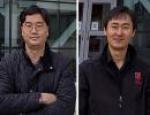 Jongwan Eun and
Seunghee Kim are leading a team of researchers working to develop a
barrier material that will make the geological storage of spent nuclear fuels a safer
proposition. The team is looking at adding an inorganic microfiber, such as glass, to bentonite
to create a less-permeable and more-durable and heat-resistant material to store the spent
fuel. The team has received a three-year, $800,000 grant from the U.S. Department of Energy.
(3/10/21)
Jongwan Eun and
Seunghee Kim are leading a team of researchers working to develop a
barrier material that will make the geological storage of spent nuclear fuels a safer
proposition. The team is looking at adding an inorganic microfiber, such as glass, to bentonite
to create a less-permeable and more-durable and heat-resistant material to store the spent
fuel. The team has received a three-year, $800,000 grant from the U.S. Department of Energy.
(3/10/21)
Bao published in Nature Photonics
 Wei Bao and colleagues recently published an article in
Nature Photonics titled A non-unitary metasurface enables continuous control of quantum
photon–photon interactions from bosonic to fermionic. (2/17/21)
Wei Bao and colleagues recently published an article in
Nature Photonics titled A non-unitary metasurface enables continuous control of quantum
photon–photon interactions from bosonic to fermionic. (2/17/21)
A non-unitary metasurface enables continuous control of quantum photon–photon interactions from bosonic to fermionic
Abstract
Faculty acknowledged for work on Grand Challenges framework
 Following Chancellor Ronnie Green’s 2020 State of Our
University address, ORED was charged with designing and leading an open, participatory process
for the campus community to identify a portfolio of Nebraska “Grand Challenges.” The challenge
themes will help guide activities and talent and be used to direct institutional investment and
resource allocation. The following NCMN faculty contributed to the process of identifying the
Grand Challenge themes.
Those with an asterisk (*) listed after their names also participated in writing the theme
descriptions:
Following Chancellor Ronnie Green’s 2020 State of Our
University address, ORED was charged with designing and leading an open, participatory process
for the campus community to identify a portfolio of Nebraska “Grand Challenges.” The challenge
themes will help guide activities and talent and be used to direct institutional investment and
resource allocation. The following NCMN faculty contributed to the process of identifying the
Grand Challenge themes.
Those with an asterisk (*) listed after their names also participated in writing the theme
descriptions:
- Shireen Adenwalla, Physics
- Shannon Bartelt-Hunt, Civil and Environmental Engineering
- Herman Batelaan, Physics and Astronomy
- Christian Binek*, Physics and Astronomy
- Martin Centurion, Physics
- Lucia Fernandez-Ballester, College of Engineering
- Timothy Gay, Physics and Astronomy
- Seunghee Kim, Civil and Environmental Engineering
- Abdelghani Laraoui*, Mechanical and Materials Engineering
- Angie Pannier, Biological Systems Engineering
- Jody Redepenning*, Chemistry
- Eva Schubert, Electrical and Computer Engineering
- David Sellmyer*, Nebraska Center for Materials and Nanoscience, Physics
- Jeff Shield*, Mechanical and Materials Engineering
- Xiaoshan Xu, Physics and Astronomy
Zeng's 'Nice Ice' featured in "Deep Freeze" article
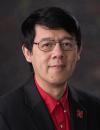 A Nebraska Today article highlighting "downright cold feats at Nebraska" in light
of recent subzero temps, featured Xiao Cheng Zeng and his 'Nice Ice.' Cheng and colleagues discovered that ice grows upward from
water-repellent surfaces, making it far easier to remove than ice that grows flat on more
absorbent surfaces. (2/15/21)
A Nebraska Today article highlighting "downright cold feats at Nebraska" in light
of recent subzero temps, featured Xiao Cheng Zeng and his 'Nice Ice.' Cheng and colleagues discovered that ice grows upward from
water-repellent surfaces, making it far easier to remove than ice that grows flat on more
absorbent surfaces. (2/15/21)
Yang team develops system to measure resilience, breakage of cellular bridge
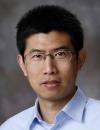 Ruiguo Yang and his colleagues have managed to
record the biomechanical behavior of mature, individual cell-to-cell junctions for the first
time, as reported in Proceedings of the National Academy of Sciences. (2/3/21)
Ruiguo Yang and his colleagues have managed to
record the biomechanical behavior of mature, individual cell-to-cell junctions for the first
time, as reported in Proceedings of the National Academy of Sciences. (2/3/21)
Characterization of the strain-rate–dependent mechanical response of single cell–cell junctions
Abstract
Accolades, January 2021
 Alexei Gruverman received the
Humboldt Research Award from the Alexander von Humboldt Foundation. The honor goes to up to 100 people per year,
recognizing researchers whose fundamental discoveries, theories or insights have had — and will
continue to have — a significant impact in their field. Recipients are invited to carry out
research projects in cooperation with specialist colleagues in Germany.
Alexei Gruverman received the
Humboldt Research Award from the Alexander von Humboldt Foundation. The honor goes to up to 100 people per year,
recognizing researchers whose fundamental discoveries, theories or insights have had — and will
continue to have — a significant impact in their field. Recipients are invited to carry out
research projects in cooperation with specialist colleagues in Germany.
 Jian Wang was named a fellow of the American Society of Mechanical Engineers. The ASME
Committee of Past Presidents confers fellowship status to worthy candidates to recognize their
outstanding engineering achievements. Nominated by ASME members and fellows, an ASME member
must have 10 or more years of active practice and at least 10 years of active corporate
membership in ASME.
Jian Wang was named a fellow of the American Society of Mechanical Engineers. The ASME
Committee of Past Presidents confers fellowship status to worthy candidates to recognize their
outstanding engineering achievements. Nominated by ASME members and fellows, an ASME member
must have 10 or more years of active practice and at least 10 years of active corporate
membership in ASME.
(1/29/21)
Yang team applying electric charges to cell surfaces
 Ruiguo Yang and colleague Jae Sung Park have
received a three-year, $387,356 grant from the National Science Foundation to apply electric
charges to cells and study how those charges change the flows around pores in a cell’s surface.
The idea is to improve drug delivery systems that could help fight cancer, heart disease, and
neurodegenerative diseases. (1/26/21)
Ruiguo Yang and colleague Jae Sung Park have
received a three-year, $387,356 grant from the National Science Foundation to apply electric
charges to cells and study how those charges change the flows around pores in a cell’s surface.
The idea is to improve drug delivery systems that could help fight cancer, heart disease, and
neurodegenerative diseases. (1/26/21)
Research Highlight: Robert Streubel
 Robert Streubel has been
recognized as an Emerging Leader by the Journal of Physics: Condensed Matter. His special issue
contribution "The effect of Cu additions in FePt-BN-SiO2 heat-assisted magnetic recording
media" focuses on the impact of structural and chemical order in L10 FePt.
Robert Streubel has been
recognized as an Emerging Leader by the Journal of Physics: Condensed Matter. His special issue
contribution "The effect of Cu additions in FePt-BN-SiO2 heat-assisted magnetic recording
media" focuses on the impact of structural and chemical order in L10 FePt.
Streubel's work was also recently published in Advanced Materials. "Chiral Spin
Textures in Amorphous Iron–Germanium Thick Films" reports experimental evidence of 3D
chiral spin textures, i.e., helical spins and skyrmions with different chirality and
topological charge, stabilized in amorphous Fe–Ge thick films. (1/22/21)
NCMN faculty featured in NUtech annual report
 The following NCMN faculty members were featured in NUtech
Venture's 2019-2020 Nebraska Research Report:
The following NCMN faculty members were featured in NUtech
Venture's 2019-2020 Nebraska Research Report:
- Alexander Sinitskii was featured for his research on using DNA nanotechnology to shape graphene nanoribbons into functional electronic structures for device applications. Sinitskii received a three-year, $4.5 million grant from the U.S. Department of Defense’s Office of Naval Research for this work.
- Vitaly Alexandrov was highlighted for earning a Faculty Early Career Development Program award from the National Science Foundation for his work in expanding the understanding of how nanomaterials dissolve in water.
- Shudipto Dishari received accolades for earning the Early Career Research Program award from the Department of Energy’s Office of Science. "With the funding, Dishari will design new polymer materials that improve energy efficiency and storage, possibly in devices such as fuel cells and redox-flow batteries."
Achievements, January 15
 Florin Bobaru, and colleagues
Siavash Jafarzadeh and Ziguang Chen, have been awarded the 2020 Corrosion Best Paper Award from NACE International for “Peridynamic Modeling
of Repassivation in Pitting Corrosion of Stainless Steel,” published in Corrosion.
(1/15/21)
Florin Bobaru, and colleagues
Siavash Jafarzadeh and Ziguang Chen, have been awarded the 2020 Corrosion Best Paper Award from NACE International for “Peridynamic Modeling
of Repassivation in Pitting Corrosion of Stainless Steel,” published in Corrosion.
(1/15/21)
Hage, Dishari highlighted by NUtech Ventures
 David Hage and Shudipto Dishari were featured in an article from NUtech Ventures
highlighting key stories from 2020 that shaped the transfer of research and creative activity
to the marketplace. Hage helped design a COVID-19 antibody test and Dishari is developing polymers to reduce the cost and improve the energy efficiency of
hydrogen-based fuel cells, which are used to fuel electric cars. (1/12/21)
David Hage and Shudipto Dishari were featured in an article from NUtech Ventures
highlighting key stories from 2020 that shaped the transfer of research and creative activity
to the marketplace. Hage helped design a COVID-19 antibody test and Dishari is developing polymers to reduce the cost and improve the energy efficiency of
hydrogen-based fuel cells, which are used to fuel electric cars. (1/12/21)
US-Issued Patents, Oct-Dec 2020
 The following list includes all U.S.-issued patents granted by
the U.S. Patent and Trademark Office to University of Nebraska-Lincoln researchers from Oct. 1,
2020, to Dec. 31, 2020, as reported by NUtech Ventures.
The following list includes all U.S.-issued patents granted by
the U.S. Patent and Trademark Office to University of Nebraska-Lincoln researchers from Oct. 1,
2020, to Dec. 31, 2020, as reported by NUtech Ventures.
- Leidenfrost Droplet Microfluidics; Sidy Ndao, Dennis Alexander, George Gogos, Troy Anderson, Craig Zuhlke; 10,792,660
- Hydrogel Microphone; Li Tan, Yang Gao, Qin Zhou, Yongmei Chen; 10,801,906
- Effective Hair Styling Compositions and Processes; Yiqi Yang, Helan Xu, Kaili Song; 10,828,246
(1/8/21)
Top Sponsored Awards, November 2020
 These are awards from public entities, including all arts and
humanities grants of $10,000 or more and all other grants of $200,000 or more between October
16 and November 15, 2020, as reported through NUgrant:
These are awards from public entities, including all arts and
humanities grants of $10,000 or more and all other grants of $200,000 or more between October
16 and November 15, 2020, as reported through NUgrant:
- Ozan Ciftci (and colleagues D. Ciftci and R. Hutkins); FDST; $481,960; Department of Agriculture-National Institute of Food and Agriculture; An Innovative Green Platform Technology to Manufacture Novel Multifunctional Hollow Solid Lipid Micro- and Nanoparticles
- Evgeny Tsymbal; PHYS; $375,005; University of Wisconsin; Engineered Quantum Heterostructures with Epitaxial Antiperovskites
(1/8/21)
Ciftci receives LIST International Award in Bioinnovation
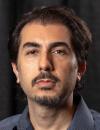 Ozan Ciftci has received the
LIST International Award in Bioinnovation from the Luxembourg Institute of
Science and Technology. The award honors the most outstanding research in the areas of
bioavailability of nutrients, nutrient transport or nutrient effectiveness on a cellular level.
Ciftci was honored for his discovery of a novel, green-based approach to improve the
bioaccessibility of curcumin, a chemical compound found in turmeric that has the potential to
help prevent heart disease, Alzheimer’s, cancer and other diseases. (12/7/20)
Ozan Ciftci has received the
LIST International Award in Bioinnovation from the Luxembourg Institute of
Science and Technology. The award honors the most outstanding research in the areas of
bioavailability of nutrients, nutrient transport or nutrient effectiveness on a cellular level.
Ciftci was honored for his discovery of a novel, green-based approach to improve the
bioaccessibility of curcumin, a chemical compound found in turmeric that has the potential to
help prevent heart disease, Alzheimer’s, cancer and other diseases. (12/7/20)
Takacs named AAAS fellow
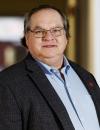 James Takacs is one of four
Nebraska faculty to be named fellows of the American Association for the Advancement of
Science, the world's largest general scientific society. Takacs was elected for distinguished
contributions to synthetic organic chemistry, commitment to mentoring and excellence in
postsecondary chemical education, and the advancement of science through academic
administration. (11/24/20)
James Takacs is one of four
Nebraska faculty to be named fellows of the American Association for the Advancement of
Science, the world's largest general scientific society. Takacs was elected for distinguished
contributions to synthetic organic chemistry, commitment to mentoring and excellence in
postsecondary chemical education, and the advancement of science through academic
administration. (11/24/20)
Iverson team earns grant to improve nitric oxide sensors
 A team led by Nicole Iverson has
earned a $1.77 million grant from the Department of Health and Human Services to make nitric
oxide sensors easy to use and to utilize them to study both healthy and diseased cells.
(11/11/20)
A team led by Nicole Iverson has
earned a $1.77 million grant from the Department of Health and Human Services to make nitric
oxide sensors easy to use and to utilize them to study both healthy and diseased cells.
(11/11/20)
Dishari named NUtech Emerging Innovator of the Year
 NUtech Ventures hosted its Innovator Celebration on Nov. 2,
held as part of Nebraska Research Days. The Emerging Innovator of the Year award went to
Shudipto Dishari, assistant professor of chemical and
biomolecular engineering. The award recognizes an individual, often a junior faculty member,
for recent innovation contributions.
NUtech Ventures hosted its Innovator Celebration on Nov. 2,
held as part of Nebraska Research Days. The Emerging Innovator of the Year award went to
Shudipto Dishari, assistant professor of chemical and
biomolecular engineering. The award recognizes an individual, often a junior faculty member,
for recent innovation contributions.
Dishari’s research focuses on designing ion-conducting and light-harvesting polymers, exploring
the nanoscale phenomena within polymeric thin films and membranes. Her work could help reduce
the cost and improve the energy efficiency of hydrogen-based fuel cells. Other potential
applications include energy conversion and storage device systems, such as lithium batteries,
semi-conductors, and biochemical systems. (11/4/20)
Yang publishes new book
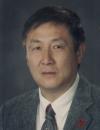 Jiashi Yang recently published his new book
Mechanics of Piezoelectric, 2nd Edition. This book covers one- and
two-dimensional theories of piezoelectric structures including rods, beams, plates and shells.
In addition to the so-called low-frequency motions of extension and bending, high-frequency
motions of thickness shear and thickness stretch are also considered for certain applications
unique in resonant piezoelectric devices. Both single-layer and multi-layer structures are
treated. Nonlinear effects due to large deflection or large shear deformation are also
discussed. The emphasis is on the development of structural theories with various levels of
sophistication for different applications in piezoelectric devices. (10/31/20)
Jiashi Yang recently published his new book
Mechanics of Piezoelectric, 2nd Edition. This book covers one- and
two-dimensional theories of piezoelectric structures including rods, beams, plates and shells.
In addition to the so-called low-frequency motions of extension and bending, high-frequency
motions of thickness shear and thickness stretch are also considered for certain applications
unique in resonant piezoelectric devices. Both single-layer and multi-layer structures are
treated. Nonlinear effects due to large deflection or large shear deformation are also
discussed. The emphasis is on the development of structural theories with various levels of
sophistication for different applications in piezoelectric devices. (10/31/20)
Accolades, October 2020
 Angela Pannier was named to the
2020 Class of Fellows in the Biomedical
Engineering Society. Fellows have demonstrated exceptional achievements and have made
significant contributions within the biomedical engineering field. They also have extensive
leadership within the field and have served within the society. (10/30/20)
Angela Pannier was named to the
2020 Class of Fellows in the Biomedical
Engineering Society. Fellows have demonstrated exceptional achievements and have made
significant contributions within the biomedical engineering field. They also have extensive
leadership within the field and have served within the society. (10/30/20)
Gay solves conundrum of football physics
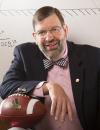 Tim Gay and colleagues have
discovered the answer to a football physics question that stumped him for years - when a
quarterback throws a deep, well-thrown pass, why does the football point up when thrown and
then down when about to be caught? The answer lay in the concept of gyroscopic stabilization.
The team knew that a well-thrown football, like the high-RPM gyroscope, possesses plenty of
angular momentum. But with the aid of math and computer simulations, they came to a vital
conclusion: The football can adopt a precession, too. (10/5/20)
Tim Gay and colleagues have
discovered the answer to a football physics question that stumped him for years - when a
quarterback throws a deep, well-thrown pass, why does the football point up when thrown and
then down when about to be caught? The answer lay in the concept of gyroscopic stabilization.
The team knew that a well-thrown football, like the high-RPM gyroscope, possesses plenty of
angular momentum. But with the aid of math and computer simulations, they came to a vital
conclusion: The football can adopt a precession, too. (10/5/20)
Top Awards from Public Sponsors, August 2020
 These are awards from public entities, including all arts and
humanities grants of $10,000 or more and all other grants of $200,000 or more between May 16
and June 15, 2020, as reported through NUgrant. NCMN recipients:
These are awards from public entities, including all arts and
humanities grants of $10,000 or more and all other grants of $200,000 or more between May 16
and June 15, 2020, as reported through NUgrant. NCMN recipients:
- Joe Turner (and colleagues L. Rilett and H. Sharif-Kashani); MME; $535,500; Kansas State University; Rural Rail Safety Center
- Alexey Kovalev; PHYS; $344,971; Department of Energy; Spin Currents in Magnetic Systems and Heterostructures
(10/5/20)
2020 Service Awards for NCMN faculty and staff
 The following NCMN faculty and staff were honored during this
year's (virtual) Celebration of Service, which celebrates faculty and staff employed with the
University in five-year increments.
The following NCMN faculty and staff were honored during this
year's (virtual) Celebration of Service, which celebrates faculty and staff employed with the
University in five-year increments.
- 5 Years: Nicole Iverson-BSE, Vitaly Alexandrov-CBE, Jiong Hu-CEE Omaha, Eli Sutter-MME, Peter Sutter-ECE, Jian Wang-MME, Michael Sealy-MME
- 10 Years: Srivatsan Kidambi-CBE, Lucia Fernandez Ballester-MME, Jiong Hua-NCMN
- 15 Years: Yong Rak Kim-CEE, Mathias Schubert-ECE, Li Tan-MME
- 20 Years: Xingzhong Li-NCMN
- 30 Years: Jody Redepenning-CHEM, Shelli Krupricka-NCMN
- 45 Years: Dennis Alexander-ECE
(9/29/20)
Centurion named APS fellow
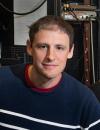 Martin Centurion has been
elected a 2020 Fellow of the American Physical Society. Fellowships recognize members who may
have made advances in physics through original research and publication; significant,
innovative contributions in the application of physics to science and technology; significant
contributions to the teaching of physics; or service and participation in the activities of the
Society. (9/28/20)
Martin Centurion has been
elected a 2020 Fellow of the American Physical Society. Fellowships recognize members who may
have made advances in physics through original research and publication; significant,
innovative contributions in the application of physics to science and technology; significant
contributions to the teaching of physics; or service and participation in the activities of the
Society. (9/28/20)
Bartelt-Hunt searching sewage for COVID-19
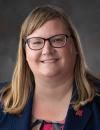 Shannon Bartelt-Hunt is
expanding her research on identifying SARS-CoV-2 in sewage to the University of
Nebraska-Lincoln's City Campus. This testing is part of a larger research project Bartelt-Hunt
is working on with UNMC to determine the feasibility of using wastewater for SARS-CoV-2
community surveillance. (9/25/20)
Shannon Bartelt-Hunt is
expanding her research on identifying SARS-CoV-2 in sewage to the University of
Nebraska-Lincoln's City Campus. This testing is part of a larger research project Bartelt-Hunt
is working on with UNMC to determine the feasibility of using wastewater for SARS-CoV-2
community surveillance. (9/25/20)
Turner selected for Research Leaders Program
 Joe Turner is one of 15 UNL
faculty members selected to participate in the inaugural cohort of the Office of Research and
Economic Development’s Research Leaders Program. Among the first of its kind in the nation,
this initiative to identify and develop Nebraska’s next generation of research leaders is in
partnership with the Center for Professional and Executive Development in the College of
Business. (9/4/20)
Joe Turner is one of 15 UNL
faculty members selected to participate in the inaugural cohort of the Office of Research and
Economic Development’s Research Leaders Program. Among the first of its kind in the nation,
this initiative to identify and develop Nebraska’s next generation of research leaders is in
partnership with the Center for Professional and Executive Development in the College of
Business. (9/4/20)
NCMN honors and publications for Sept. 4
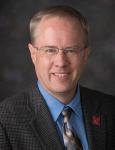 David Hage has earned the ACS
Award in Chromatography from the American Chemical Society. Recipients are recognized for
outstanding contributions to the field of chromatography, with particular consideration given
to developments of new methods. He will be honored at the ACS 2021 Spring National Meeting in
San Antonio.
David Hage has earned the ACS
Award in Chromatography from the American Chemical Society. Recipients are recognized for
outstanding contributions to the field of chromatography, with particular consideration given
to developments of new methods. He will be honored at the ACS 2021 Spring National Meeting in
San Antonio.
 Shudipto Dishari and a team of researchers co-authored an article titled
Ionomers From Kraft Lignin for Renewable Energy Applications that is featured in
Frontiers in Chemistry’s “Women In Science”. (9/4/20)
Shudipto Dishari and a team of researchers co-authored an article titled
Ionomers From Kraft Lignin for Renewable Energy Applications that is featured in
Frontiers in Chemistry’s “Women In Science”. (9/4/20)
Bartelt-Hunt on team finding antibiotics in Nebraska watersheds
 Shannon Bartelt-Hunt is
among a team of researchers from UNL and UNMC that have discovered antibiotics used in human
treatment in two Nebraska watersheds near Fremont and Lincoln. The discovery has researchers
concerned about the impact this will have on the increasing resistance to antibiotics in
humans. (9/3/20)
Shannon Bartelt-Hunt is
among a team of researchers from UNL and UNMC that have discovered antibiotics used in human
treatment in two Nebraska watersheds near Fremont and Lincoln. The discovery has researchers
concerned about the impact this will have on the increasing resistance to antibiotics in
humans. (9/3/20)
Top Awards from Public Sponsors, July 2020
 These are awards from public entities, including all arts and humanities
grants of $10,000 or more and all other grants of $200,000 or more between May 16 and June 15,
2020, as reported through NUgrant. NCMN recipients:
These are awards from public entities, including all arts and humanities
grants of $10,000 or more and all other grants of $200,000 or more between May 16 and June 15,
2020, as reported through NUgrant. NCMN recipients:
- Joe Turner; MME; $301,395; National Science Foundation, Integrated Analysis of the Cell Biological, Biomechanical, and Physiological Dynamics of Stomatal Guard Cells in Plants
UNL announces NNF five-year renewal
 The
University of Nebraska has announced the five-year renewal of the Nebraska Nanoscale Facility through the NSF’s National
Nanotechnology Coordinated Infrastructure program.
The
University of Nebraska has announced the five-year renewal of the Nebraska Nanoscale Facility through the NSF’s National
Nanotechnology Coordinated Infrastructure program.
“We can proudly say here in Nebraska that this is quite an elite club we are in,” said Christian Binek, director of the nanoscale facility. The national
infrastructure aims to ensure “the entire country is equipped with the tools and expertise to
perform nanoscience and nanotechnology. With this infrastructure we have, we are in a very good
position to play an important role and compete nationwide and even internationally in this
field,” Binek said. (8/28/20)
Bartelt-Hunt receives COVID-related grant from ORED
 Shannon Bartelt-Hunt is
heading one of 20 research teams at Nebraska that have received a grant from the Office of
Research and Economic Development’s COVID-19 Rapid Response Grant Program. Bartelt-Hunt’s
project: “Using Wastewater to Track COVID in Nebraska’s Communities.” (8/7/20)
Shannon Bartelt-Hunt is
heading one of 20 research teams at Nebraska that have received a grant from the Office of
Research and Economic Development’s COVID-19 Rapid Response Grant Program. Bartelt-Hunt’s
project: “Using Wastewater to Track COVID in Nebraska’s Communities.” (8/7/20)
Top Awards from Public Sponsors, June 2020
 These are awards from public entities, including all arts and humanities
grants of $10,000 or more and all other grants of $200,000 or more between May 16 and June 15,
2020, as reported through NUgrant. NCMN recipients:
These are awards from public entities, including all arts and humanities
grants of $10,000 or more and all other grants of $200,000 or more between May 16 and June 15,
2020, as reported through NUgrant. NCMN recipients:
- David Berkowitz; CHEM; $476,140; National Science Foundation; NSF IPA Assignment
- Yuris Dzenis; MME; $599,374; Department of Defense-Air Force Office of Scientific Research; Ultratough Lightweight High-Temperature Nanofibers for Aerospace Composites
- Florin Bobaru (and colleague A. Larios); MME; $748,375; National Science Foundation; Corrosion-Induced Fracture and Failure: Transforming Computations from Micrometers and Minutes to Meters and Years
- Peter Dowben; PHYS; $486,234; National Science Foundation; Heteromolecular Interface Design for Better Multiferroic Molecular Spintronics
- Jongwan Eun and Seunghee Kim (and colleagues J. Steelman, M. Asadollahipajouh, C. Song, and C. Stolle); CEE; $248,261; Alaska Dept of Transportation & Public Facilities; Evaluation of Light Pole Foundation Embedment
Husker team fine-tuning skyrmions to improve data storage, processing
 A team led by David Sellmyer, Balamurugan
Balasubramanian, and Ralph Skomski continue to make progress on
their work improving skyrmions, by making them smaller and more stable, so they can be useful
in practical applications. The team was recently able to increase the magnetic ordering
temperature of a skyrmion supporting material beyond room temperature while also shrinking the
size of the skyrmions to ~17 nanometers. This discovery counters the conventional wisdom that
only larger skyrmions can be realized at room temperature; for future applications, skyrmions
would ideally be ~10 nanometers. (7/21/20)
A team led by David Sellmyer, Balamurugan
Balasubramanian, and Ralph Skomski continue to make progress on
their work improving skyrmions, by making them smaller and more stable, so they can be useful
in practical applications. The team was recently able to increase the magnetic ordering
temperature of a skyrmion supporting material beyond room temperature while also shrinking the
size of the skyrmions to ~17 nanometers. This discovery counters the conventional wisdom that
only larger skyrmions can be realized at room temperature; for future applications, skyrmions
would ideally be ~10 nanometers. (7/21/20)
Binek contributes to 2020 Magnetism Roadmap
 Christian Binek was one of several scientists chosen to
contribute to the 2020 Magnetism Roadmap, which offers an expose of newly relevant and highly
active areas in magnetism research. Binek’s contribution is titled “Multiferroic
heterostructures and magnetoelectrics.” (7/20/20)
Christian Binek was one of several scientists chosen to
contribute to the 2020 Magnetism Roadmap, which offers an expose of newly relevant and highly
active areas in magnetism research. Binek’s contribution is titled “Multiferroic
heterostructures and magnetoelectrics.” (7/20/20)
Bartelt-Hunt on team testing wastewater for virus detection
 Shannon Bartelt-Hunt and a
team of researchers from the University of Nebraska-Lincoln and the University of Nebraska
Medical Center have partnered with the Lincoln Wastewater System to start projects that use
wastewater samples for early detection of the SARS-CoV-2 coronavirus. In a study conducted at
Yale University, researchers were able to predict the number of coronavirus cases seven days
ahead using the amounts of coronavirus found in wastewater samples. Bartelt-Hunt has been
collecting weekly wastewater samples from Lincoln, Grand Island, and Omaha and working with
researchers at UNMC on testing methods and the possibilities of sequencing and culturing the
virus to learn more about its origins as well as precautions needed for utilities workers.
(7/10/20)
Shannon Bartelt-Hunt and a
team of researchers from the University of Nebraska-Lincoln and the University of Nebraska
Medical Center have partnered with the Lincoln Wastewater System to start projects that use
wastewater samples for early detection of the SARS-CoV-2 coronavirus. In a study conducted at
Yale University, researchers were able to predict the number of coronavirus cases seven days
ahead using the amounts of coronavirus found in wastewater samples. Bartelt-Hunt has been
collecting weekly wastewater samples from Lincoln, Grand Island, and Omaha and working with
researchers at UNMC on testing methods and the possibilities of sequencing and culturing the
virus to learn more about its origins as well as precautions needed for utilities workers.
(7/10/20)
NCMN in the national news, June 2020
 Xiao Cheng Zeng was elected to the Chemistry Division of
the European Academy of Sciences, an independent
organization of the most distinguished scholars and engineers who are at the forefront of
research and development of advanced technologies. (7/6/20)
Xiao Cheng Zeng was elected to the Chemistry Division of
the European Academy of Sciences, an independent
organization of the most distinguished scholars and engineers who are at the forefront of
research and development of advanced technologies. (7/6/20)
Top Awards from Public Sponsors, May 2020
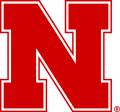 These are awards from public entities, including all arts and
humanities grants of $10,000 or more and all other grants of $200,000 or more between March 16
and April 15, 2020, as reported through NUgrant. NCMN recipients:
These are awards from public entities, including all arts and
humanities grants of $10,000 or more and all other grants of $200,000 or more between March 16
and April 15, 2020, as reported through NUgrant. NCMN recipients:
- David Berkowitz (and colleagues M. Wilson, W. Nui); CHEM; $603,881; National Science Foundation; Engineering Enzymes for New Stereoselective and Stereodynamic Processes: An Integrated Chemistry-Bioengineering-X-Ray Crystallography-Molecular Dynamics Approach
- Dennis Alexander, Christos Argyropoulos (and colleagues C. Zuhlke, G. Gogos, N. Ianno, J.Shield); ECE; $385,240; Department of Defense-Office of Naval Research-Defense University Research Instrumentation Program; Femtosecond Streak Camera for Studying the Role of Laser Induced Plasmas in Ultrafast Light-Matter Interactions
- Ozan Ciftci (and colleagues Y. Menese Gonzalez, R. Moreau, D. Rose); FDST; $468,000; USDA-NIFA; An Innovative Approach to Increasing Bioavailability of Curcumin using Nanoporous Starch Bioaerogels
U.S.-Issued Patents, April-June 2020
 The following U.S.-issued patents were granted by the U.S.
Patent and Trademark Office to University of Nebraska-Lincoln researchers from April 1, 2020,
to June 30, 2020, as reported by NUtech Ventures:
The following U.S.-issued patents were granted by the U.S.
Patent and Trademark Office to University of Nebraska-Lincoln researchers from April 1, 2020,
to June 30, 2020, as reported by NUtech Ventures:
- Christopher Exstrom (and colleagues J. Huang, B. Mao); Patent 10,680,125; Synthesis of Air Stable Pyrite Nanocrystals for Photovoltaic Application
NCMN in the national news, June 2020
 David Berkowtiz was featured
in Chemistry World’s “Chemists Amid Coronavirus” series on June 16. He
recently began his appointment as director of the National Science Foundation’s Division of
Chemistry. He also continues to conduct research at Nebraska. (7/2/20)
David Berkowtiz was featured
in Chemistry World’s “Chemists Amid Coronavirus” series on June 16. He
recently began his appointment as director of the National Science Foundation’s Division of
Chemistry. He also continues to conduct research at Nebraska. (7/2/20)
Hage team helping develop COVID-19 antibody test
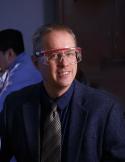 David Hage and his graduate
students are part of a nationwide team, led by ni2o
Inc., that is repurposing patented technologies to develop and manufacture a fast-acting
COVID-19 antibody test. Hage’s team is using his own previously patented research (a support
material that helps compounds rapidly bind together, along with a method for using the material
in clinical testing) to develop a faster antibody test that is easy to use in a clinical
setting. Right now they are just focusing on identifying any COVID-19 antibodies, but hope to
progress to where the test can identify different types of antibodies. Hage’s progress was
featured on KETV Omaha. (6/22/20)
David Hage and his graduate
students are part of a nationwide team, led by ni2o
Inc., that is repurposing patented technologies to develop and manufacture a fast-acting
COVID-19 antibody test. Hage’s team is using his own previously patented research (a support
material that helps compounds rapidly bind together, along with a method for using the material
in clinical testing) to develop a faster antibody test that is easy to use in a clinical
setting. Right now they are just focusing on identifying any COVID-19 antibodies, but hope to
progress to where the test can identify different types of antibodies. Hage’s progress was
featured on KETV Omaha. (6/22/20)
NCMN in the national news, May 2020
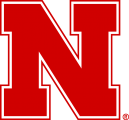 A study by Yuris
Dzenis and colleagues yielding breakthroughs in understanding the failure of
high-performance fibers was featured on Phys.org and Technology.org. (6/1/20)
A study by Yuris
Dzenis and colleagues yielding breakthroughs in understanding the failure of
high-performance fibers was featured on Phys.org and Technology.org. (6/1/20)
The legacy of Sellmyer’s career and leadership
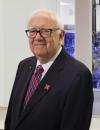 In the second story of a five part series from ORED
highlighting research leadership, the spotlight shined on David Sellmyer’s leadership successes during his long career. The article features
much commentary from current and former colleagues praising his leadership, mentorship,
management, and his knack for seeing the big picture. (5/29/20)
In the second story of a five part series from ORED
highlighting research leadership, the spotlight shined on David Sellmyer’s leadership successes during his long career. The article features
much commentary from current and former colleagues praising his leadership, mentorship,
management, and his knack for seeing the big picture. (5/29/20)
Berkowitz joins NSF
 On May 24, David
Berkowitz assumed the position of division director of NSF’s chemistry division under the
Intergovernmental Personnel Act; he is working “on loan” from Nebraska, but will continue his
research program at Nebraska through NSF’s Independent Research/Development Program.
(5/29/20)
On May 24, David
Berkowitz assumed the position of division director of NSF’s chemistry division under the
Intergovernmental Personnel Act; he is working “on loan” from Nebraska, but will continue his
research program at Nebraska through NSF’s Independent Research/Development Program.
(5/29/20)
Top Awards from Public Sponsors, April 2020
 These are awards from public entities, including all arts and
humanities grants of $10,000 or more and all other grants of $200,000 or more between March 16
and April 15, 2020, as reported through NUgrant. NCMN recipients:
These are awards from public entities, including all arts and
humanities grants of $10,000 or more and all other grants of $200,000 or more between March 16
and April 15, 2020, as reported through NUgrant. NCMN recipients:
- Peter and Eli Sutter; ECE/MME; $496,037, Department of Defense-Office of Naval Research; Riemann Surfaces in Layered Van der Waals Nanowires: Precision Twist Moires, Nanoscale Solenoids and Screw Dislocation Spin-Orbit Coupling
- Ruiguo Yang (and colleague J. Park); MME; $387,356; NSF; Nonlinear Electrokinetics at Polarizable Soft Interfaces: Implications for Cell Membrane Characterization and Nanopore Transport
Dzenis team makes breakthroughs studying high-performance fibers
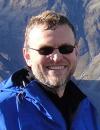 Yuris Dzenis and
colleagues have made some new discoveries while studying the failure of high-performance fibers
found in body armor and aerospace engineering. The team devised a way to analyze the failures
of the polymer fibers that avoided the perturbations that invalidated measurements captured by
other techniques. The study was recently featured on the cover of ACS Applied Materials and
Interfaces. (5/20/20)
Yuris Dzenis and
colleagues have made some new discoveries while studying the failure of high-performance fibers
found in body armor and aerospace engineering. The team devised a way to analyze the failures
of the polymer fibers that avoided the perturbations that invalidated measurements captured by
other techniques. The study was recently featured on the cover of ACS Applied Materials and
Interfaces. (5/20/20)
NCMN faculty receive promotions, tenure
 Four NCMN faculty members received promotions/tenure this
year. Bai Cui (MME) and Prahalada Rao (MME) were both promoted to associate professor and granted
tenure. Yusong Li (CEE) and Alexander Sinitskii (CHEM) were both promoted to full
professor. Congratulations! (5/15/20)
Four NCMN faculty members received promotions/tenure this
year. Bai Cui (MME) and Prahalada Rao (MME) were both promoted to associate professor and granted
tenure. Yusong Li (CEE) and Alexander Sinitskii (CHEM) were both promoted to full
professor. Congratulations! (5/15/20)
Hage, Hu receive College Distinguished Teaching Award
 David Hage and
Jiong Hu have been chosen to receive the College
Distinguished Teaching Award, a $1,000 stipend in recognition of excellent teaching. Each year,
15 faculty across campus are chosen, based on recommendations from their college. (5/4/20)
David Hage and
Jiong Hu have been chosen to receive the College
Distinguished Teaching Award, a $1,000 stipend in recognition of excellent teaching. Each year,
15 faculty across campus are chosen, based on recommendations from their college. (5/4/20)
NCMN faculty in national news, April 2020
 Two of our faculty members made national news in April.
Yiqi Yang was quoted in a Wall Street Journal article discussing the efficacy of DIY face masks. The
research of Xia Hong and colleagues was featured in
Phys.org and Technology.org. The researchers recently discovered unusual light-filtering
effects in a nanoscopic structure that could spur the development of smaller, smarter optical
filters. (5/4/20)
Two of our faculty members made national news in April.
Yiqi Yang was quoted in a Wall Street Journal article discussing the efficacy of DIY face masks. The
research of Xia Hong and colleagues was featured in
Phys.org and Technology.org. The researchers recently discovered unusual light-filtering
effects in a nanoscopic structure that could spur the development of smaller, smarter optical
filters. (5/4/20)
‘Strange effect’ raises possibility of smaller, smarter optical filters
 Xia Hong and
colleagues have discovered a ‘strange trick’ while studying how the optical behavior of
single-layer molybdenum disulfide responded when it was placed atop a ferroelectric material
called lead zirconate titanate, or PZT. Instead of observing second-harmonic generation
uniformly across the surface, the team noticed that certain segments were boosting the
phenomenon even as others dampened it. This discovery could spur the development of smaller,
more versatile optical filters that are especially adept at playing with a trick of the light.
Among the co-authors were two other NCMN faculty: Yongfeng
Lu and Evgeny Tsymbal. (4/29/20)
Xia Hong and
colleagues have discovered a ‘strange trick’ while studying how the optical behavior of
single-layer molybdenum disulfide responded when it was placed atop a ferroelectric material
called lead zirconate titanate, or PZT. Instead of observing second-harmonic generation
uniformly across the surface, the team noticed that certain segments were boosting the
phenomenon even as others dampened it. This discovery could spur the development of smaller,
more versatile optical filters that are especially adept at playing with a trick of the light.
Among the co-authors were two other NCMN faculty: Yongfeng
Lu and Evgeny Tsymbal. (4/29/20)
Nejati team experimenting with organic LEGOs
 A team led by Siamak
Nejati, including researchers from the Colorado School of Mines, Harbin Institute of
Technology, and the University of Pennsylvania, have discovered a way to synthesize a special
type of organic solids, known as porphyrin-based covalent organic frameworks (POR-COFs). COFs
are porous, lightweight and durable; the researchers compare them to LEGO bricks for their
ability to be assembled in defined ways and relatively quickly to form a variety of larger
structures. (4/14/20)
A team led by Siamak
Nejati, including researchers from the Colorado School of Mines, Harbin Institute of
Technology, and the University of Pennsylvania, have discovered a way to synthesize a special
type of organic solids, known as porphyrin-based covalent organic frameworks (POR-COFs). COFs
are porous, lightweight and durable; the researchers compare them to LEGO bricks for their
ability to be assembled in defined ways and relatively quickly to form a variety of larger
structures. (4/14/20)
Alexandrov receives CAREER Award
 Vitaly Alexandrov has received a $520,244 CAREER Award to advance basic
understanding of how nanocrystals dissolve in aqueous environments. (3/2/20)
Vitaly Alexandrov has received a $520,244 CAREER Award to advance basic
understanding of how nanocrystals dissolve in aqueous environments. (3/2/20)
Yang on team developing smart bandages
 Ruiguo Yang has been working
with Ali Tamayol (former Husker, now at University of Connecticut) to develop smart bandages,
which feature an array of tiny needles that can help heal chronic wounds by delivering
therapeutic drugs directly to damaged tissue. “By plunging past the dead surface-level tissue
that can persist for months in people with Type 2 diabetes, those needles could administer
drugs to help close wounds, reduce infection, stimulate cell growth and potentially restore
blood flow. Limiting the duration of such wounds, the researchers said, could also help
dethrone them as the leading non-traumatic cause of amputations.” (2/27/20)
Ruiguo Yang has been working
with Ali Tamayol (former Husker, now at University of Connecticut) to develop smart bandages,
which feature an array of tiny needles that can help heal chronic wounds by delivering
therapeutic drugs directly to damaged tissue. “By plunging past the dead surface-level tissue
that can persist for months in people with Type 2 diabetes, those needles could administer
drugs to help close wounds, reduce infection, stimulate cell growth and potentially restore
blood flow. Limiting the duration of such wounds, the researchers said, could also help
dethrone them as the leading non-traumatic cause of amputations.” (2/27/20)
“Droplet like it’s watt”
 Xiao Cheng Zeng and colleagues at
the City University of Hong Kong have developed a prototype that can yield a record amount of
electricity from falling raindrops. (2/10/20)
Xiao Cheng Zeng and colleagues at
the City University of Hong Kong have developed a prototype that can yield a record amount of
electricity from falling raindrops. (2/10/20)
Lai receives ORCA Award
 Rebecca Lai was recently honored by
the College of Arts and Sciences with it’s College Outstanding Research and Creative Activity
(ORCA) award. This award recognizes significant research and creative accomplishments of
university faculty in the last five years. (2/4/20)
Rebecca Lai was recently honored by
the College of Arts and Sciences with it’s College Outstanding Research and Creative Activity
(ORCA) award. This award recognizes significant research and creative accomplishments of
university faculty in the last five years. (2/4/20)
Lai gives SciPop Talk
 On February 19, Rebecca Lai gave a
SciPop talk on “Elements in the Harry Potter World.” The presentation discussed elements in our
world that are also featured in the Harry Potter world, like gold, silver, and mercury.
(1/30/20)
On February 19, Rebecca Lai gave a
SciPop talk on “Elements in the Harry Potter World.” The presentation discussed elements in our
world that are also featured in the Harry Potter world, like gold, silver, and mercury.
(1/30/20)
Binek gives CAS Inquire Lecture
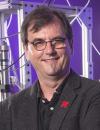 Christian Binek presented his CAS
Inquire lecture The Rise of
Nanotechnology: Small Machines with Big Impact, on January 28. A video of the lecture can
be viewed here. (1/29/20)
Christian Binek presented his CAS
Inquire lecture The Rise of
Nanotechnology: Small Machines with Big Impact, on January 28. A video of the lecture can
be viewed here. (1/29/20)
The Sutters team adds twist to van der Waals heterostructures
 Peter and Eli Sutter, along with colleagues from Aalto University and the
University of Wyoming, have discovered that by adding sulfur they could directly synthesize
twisted stacks of van der Waals heterostructures. (1/15/20)
Peter and Eli Sutter, along with colleagues from Aalto University and the
University of Wyoming, have discovered that by adding sulfur they could directly synthesize
twisted stacks of van der Waals heterostructures. (1/15/20)
Binek to give CAS Inquire Lecture
 On January 28, Christian Binek
will be delivering the first CAS Inquire lecture of the new year. Binek’s topic is “The Rise of
Nanotechnology: Small Machines with Big Impact.”
On January 28, Christian Binek
will be delivering the first CAS Inquire lecture of the new year. Binek’s topic is “The Rise of
Nanotechnology: Small Machines with Big Impact.”
The CAS Inquire program builds around a college-wide series of public lectures centering on a
new theme each year. The lecture series serves as a touchstone for the college—giving students,
staff, and faculty a focal point and shared topic for conversations and further inquiry. All
lectures will be at 5:30 p.m. in the Nebraska Union Auditorium. (1/15/20)
Watching Nebraska Ice Grow
 Xiao Cheng Zeng's team continues to
learn more about the 2D form of ice dubbed ‘Nebraska Ice.’ The team has been able to document
the shifting configuration of the ice as it grows, by freezing the ice itself. (1/2/20)
Xiao Cheng Zeng's team continues to
learn more about the 2D form of ice dubbed ‘Nebraska Ice.’ The team has been able to document
the shifting configuration of the ice as it grows, by freezing the ice itself. (1/2/20)
Negahban team working to redirect sound waves
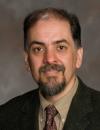 Mehrdad Negahban, working with
colleagues from Peking University, has developed a wave-altering prototype that can dynamically
redirect the sound waves passing through its surface. The prototype could lead to applications
ranging from magnifying signals to disorienting adversaries. (11/13/19)
Mehrdad Negahban, working with
colleagues from Peking University, has developed a wave-altering prototype that can dynamically
redirect the sound waves passing through its surface. The prototype could lead to applications
ranging from magnifying signals to disorienting adversaries. (11/13/19)
NCMN Faculty in national news, October 2019
 Several of our faculty members made national news last month.
Herman Batelaan was quoted in a Popular Mechanics article. Yongfeng Lu’s project,
supported by the U.S. Navy’s Office of Naval Research, was highlighted in a Tech Xplore
article. Rebecca Lai was featured in Chemical and Engineering News piece for combining chemistry with Harry Potter for
classes and outreach. Michael Sealy’s work with 3D printing
processes was the topic of a Modern Machine Shop article. Finally, Alexander
Sinitskii made local and national news when he was awarded a $4.5M grant from the DoD
Office of Naval Research for a multi-institutional project he’s leading to explore the use of
DNA nanotechnology to build graphene circuits (1, 2). (11/5/19)
Several of our faculty members made national news last month.
Herman Batelaan was quoted in a Popular Mechanics article. Yongfeng Lu’s project,
supported by the U.S. Navy’s Office of Naval Research, was highlighted in a Tech Xplore
article. Rebecca Lai was featured in Chemical and Engineering News piece for combining chemistry with Harry Potter for
classes and outreach. Michael Sealy’s work with 3D printing
processes was the topic of a Modern Machine Shop article. Finally, Alexander
Sinitskii made local and national news when he was awarded a $4.5M grant from the DoD
Office of Naval Research for a multi-institutional project he’s leading to explore the use of
DNA nanotechnology to build graphene circuits (1, 2). (11/5/19)
Pannier selected for Big Ten leadership programs
 Angela Pannier was selected by
the Executive Vice Chancellor’s Office as one of 11 faculty and executive-level staff to attend
two Big Ten Academic Alliance leadership programs this year. (10/30/19)
Angela Pannier was selected by
the Executive Vice Chancellor’s Office as one of 11 faculty and executive-level staff to attend
two Big Ten Academic Alliance leadership programs this year. (10/30/19)
Binek named Interim Director
 Christian Binek has been named
interim director of the Nebraska Center for Materials and Nanoscience and director of the
Nebraska Nanoscale Facility, succeeding David Sellmyer, George Holmes University Distinguished
Professor of physics.
Christian Binek has been named
interim director of the Nebraska Center for Materials and Nanoscience and director of the
Nebraska Nanoscale Facility, succeeding David Sellmyer, George Holmes University Distinguished
Professor of physics.
“As a veteran leader of interdisciplinary research within NCMN, as well as in the university’s
NSF-funded MRSEC, Christian is ideally positioned to advance the center’s mission,” said Bob
Wilhelm, vice chancellor for research and economic development. “This leadership experience,
combined with Christian’s nationally regarded research expertise in magnetoelectric materials
and spintronics, will help him elevate the center as Nebraska’s premier site for materials
research.”
Binek’s appointment became effective October 4. (10/11/19)
Centurion earns $2M grant
 Martin Centurion has been
awarded a $2 million grant from the Department of Energy for a project that aims to capture
moving images of single molecules in chemical transformations triggered by light. Centurion
will work in collaboration with researchers from Kansas State University, Louisiana State
University, and Brown University; the researchers will focus on molecules with possibilities
for industrial chemistry and for solar energy conversion and storage. (10/21/19)
Martin Centurion has been
awarded a $2 million grant from the Department of Energy for a project that aims to capture
moving images of single molecules in chemical transformations triggered by light. Centurion
will work in collaboration with researchers from Kansas State University, Louisiana State
University, and Brown University; the researchers will focus on molecules with possibilities
for industrial chemistry and for solar energy conversion and storage. (10/21/19)
Lu team develops “shipyard on a ship”
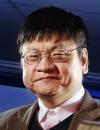 Yongfeng Lu and his team have
developed a laser system that prevents and repairs corrosion on aluminum-sided ships. Supported
by the U.S. Office of Naval Research, the team is now ready to test the laser on a fully
operational Navy ship, and will do so this fall. (10/2/19)
Yongfeng Lu and his team have
developed a laser system that prevents and repairs corrosion on aluminum-sided ships. Supported
by the U.S. Office of Naval Research, the team is now ready to test the laser on a fully
operational Navy ship, and will do so this fall. (10/2/19)
NNF Outreach featured in RAIN Newsletter
 The Remotely Accessible Instruments for Nanotechnology (RAIN) quarterly newsletter
highlighted the Nebraska Nanoscale Facility’s (NNF) summer outreach partnership with the
Extension Office and 4-H. Fourteen schools and programs in the Omaha area participated in the
Engineering with Nano Power experience. During these programs, participants were able to
examine a variety of materials using the remote capabilities of NNF’s XRF. (10/2/29)
The Remotely Accessible Instruments for Nanotechnology (RAIN) quarterly newsletter
highlighted the Nebraska Nanoscale Facility’s (NNF) summer outreach partnership with the
Extension Office and 4-H. Fourteen schools and programs in the Omaha area participated in the
Engineering with Nano Power experience. During these programs, participants were able to
examine a variety of materials using the remote capabilities of NNF’s XRF. (10/2/29)
Kidambi named Faculty Fellow for Student Success
 Srivatsan Kidambi, Dept. of
Chemical & Biomolecular Engineering, is one of seven UNL faculty members to be named
Faculty Fellows for Student Success. The fellows will meet bimonthly with directors of academic
support and engagement units, focusing on gaining expertise and leading change at the
university. (9/30/19)
Srivatsan Kidambi, Dept. of
Chemical & Biomolecular Engineering, is one of seven UNL faculty members to be named
Faculty Fellows for Student Success. The fellows will meet bimonthly with directors of academic
support and engagement units, focusing on gaining expertise and leading change at the
university. (9/30/19)
Ciftci team develop nanoparticles that could help lower cholesterol
 Ozan Ciftci and colleagues have
developed phytosterol nanoparticles that are designed to help facilitate bodily absorption of
phytosterols, which are plant-derived compounds that are known to lower LDL cholesterol that
contributes to plaque buildup in arteries. (8/30/19)
Ozan Ciftci and colleagues have
developed phytosterol nanoparticles that are designed to help facilitate bodily absorption of
phytosterols, which are plant-derived compounds that are known to lower LDL cholesterol that
contributes to plaque buildup in arteries. (8/30/19)
PECASE Award: Pannier Profile
 Angela Pannier discusses the
journey that led to her career at UNL, the importance of making mistakes and learning from
them, the nuances of training future engineers, and her outlook on the field of gene therapy.
(7/26/19)
Angela Pannier discusses the
journey that led to her career at UNL, the importance of making mistakes and learning from
them, the nuances of training future engineers, and her outlook on the field of gene therapy.
(7/26/19)
Bartelt-Hunt named chair of civil engineering
 Shannon Bartelt-Hunt, an
associate dean in the Office of Graduate Studies and professor in the College of Engineering,
has been appointed as the new Donald R. Voelte and Nancy A. Keegan Chair in civil engineering.
(7/17/19)
Shannon Bartelt-Hunt, an
associate dean in the Office of Graduate Studies and professor in the College of Engineering,
has been appointed as the new Donald R. Voelte and Nancy A. Keegan Chair in civil engineering.
(7/17/19)
NCMN Faculty are Active in Patenting
 The ORED office and NUtech Ventures recently issued a report on
US-issued patents granted by the U.S. Patent Office to UNL inventors for the fiscal year 2019.
The following NCMN faculty are listed on one or more: Ndao, DiMagno,
Woollam, M. Schubert, Kovalev, Belashchenko, Sinitskii, Gruverman, Dowben, Dussault, Redepenning, Huang, Lu, and Alexander. This represents 13 of a total of 34
UNL patents or 38%! Congratulations to our active NCMN faculty! (7/17/19)
The ORED office and NUtech Ventures recently issued a report on
US-issued patents granted by the U.S. Patent Office to UNL inventors for the fiscal year 2019.
The following NCMN faculty are listed on one or more: Ndao, DiMagno,
Woollam, M. Schubert, Kovalev, Belashchenko, Sinitskii, Gruverman, Dowben, Dussault, Redepenning, Huang, Lu, and Alexander. This represents 13 of a total of 34
UNL patents or 38%! Congratulations to our active NCMN faculty! (7/17/19)
Pannier earns Presidential Early Career Award for Scientists & Engineers
 Angela Pannier was one of two UNL
faculty members to be awarded the most prestigious governmental award for early career
researchers. Pannier was nominated by the U.S. Department of Health and Human Services for her
work on over ten projects relating to biomaterials and gene delivery systems. Congratulations,
Prof. Pannier! (7/5/19)
Angela Pannier was one of two UNL
faculty members to be awarded the most prestigious governmental award for early career
researchers. Pannier was nominated by the U.S. Department of Health and Human Services for her
work on over ten projects relating to biomaterials and gene delivery systems. Congratulations,
Prof. Pannier! (7/5/19)
A look at Yang’s greener dyeing technique
 Yiqi Yang and colleagues have
been working to find a more environmentally friendly way to dye plant-based fabrics. The team
has found that by dissolving dyes in cottonseed oil (instead of water) they can use less dye,
reuse more dye, they don’t need to use salts, can get the same colors as with other techniques,
and the waste produced contains mostly biodegradable products. (6/20/19)
Yiqi Yang and colleagues have
been working to find a more environmentally friendly way to dye plant-based fabrics. The team
has found that by dissolving dyes in cottonseed oil (instead of water) they can use less dye,
reuse more dye, they don’t need to use salts, can get the same colors as with other techniques,
and the waste produced contains mostly biodegradable products. (6/20/19)
Sellmyer book among top 25% most downloaded eBooks
 Nanoscale Magnetic Materials and Applications, Springer 2009, edited by J.P. Liu,
E. Fullerton, O. Gutfleisch, and D.J. Sellmyer. Since its online
publication, there have been a total of 64598 chapter downloads for this eBook on SpringerLink.
The book is among the top 25% most downloaded eBooks in 2018. (6/17/19)
Nanoscale Magnetic Materials and Applications, Springer 2009, edited by J.P. Liu,
E. Fullerton, O. Gutfleisch, and D.J. Sellmyer. Since its online
publication, there have been a total of 64598 chapter downloads for this eBook on SpringerLink.
The book is among the top 25% most downloaded eBooks in 2018. (6/17/19)
Study points to non-Newtonian force affecting particles’ flight
 Herman Batelaan and colleagues
recently decided to explore two theories explaining the nature of the Aharonov-Bohm effect. In
their results, the team showed mathematically that the two theories are two special cases of
one overarching theorem. (5/30/19)
Herman Batelaan and colleagues
recently decided to explore two theories explaining the nature of the Aharonov-Bohm effect. In
their results, the team showed mathematically that the two theories are two special cases of
one overarching theorem. (5/30/19)
Pannier featured on Faculty 101 podcast
 In the last Faculty 101 podcast of the season, Chancellor
Ronnie Green takes over as host and interviews professor of biological systems engineering,
Angela Pannier. (5/6/19)
In the last Faculty 101 podcast of the season, Chancellor
Ronnie Green takes over as host and interviews professor of biological systems engineering,
Angela Pannier. (5/6/19)
Researchers pinpoint potential cause of low testosterone
 Studies suggest that men taking opioid drugs or those with Type
2 diabetes are likely to see a drop in their testosterone levels. Virginia researchers
partnered with David Hage and his team to investigate how testosterone and other drugs bind to
serum albumin - a common protein in blood and known transporter of hormones, drugs, etc.,
through the bloodstream. Hage’s specialty is analyzing how biological components interact with
drugs and hormones under physiological conditions - and his team is studying various conditions
under which testosterone binds to serum albumin, in the hope of informing the prescription of
medications and the development of new ones. (4/29/19)
Studies suggest that men taking opioid drugs or those with Type
2 diabetes are likely to see a drop in their testosterone levels. Virginia researchers
partnered with David Hage and his team to investigate how testosterone and other drugs bind to
serum albumin - a common protein in blood and known transporter of hormones, drugs, etc.,
through the bloodstream. Hage’s specialty is analyzing how biological components interact with
drugs and hormones under physiological conditions - and his team is studying various conditions
under which testosterone binds to serum albumin, in the hope of informing the prescription of
medications and the development of new ones. (4/29/19)
NCMN Faculty Receive Promotions
 Congratulations to the following NCMN members who were awarded
promotion and/or tenure in 2019: Promoted to Full Professor - Linxia
Gu (Mechanical & Materials Engineering); Promoted to Associate Professor and granted
tenure - Ozan Ciftci (Food Science & Technology), Alexey Kovalev (Physics & Astronomy), Stephen
Morin (Chemistry), and Xiaoshan Xu (Physics & Astronomy).
(4/24/19)
Congratulations to the following NCMN members who were awarded
promotion and/or tenure in 2019: Promoted to Full Professor - Linxia
Gu (Mechanical & Materials Engineering); Promoted to Associate Professor and granted
tenure - Ozan Ciftci (Food Science & Technology), Alexey Kovalev (Physics & Astronomy), Stephen
Morin (Chemistry), and Xiaoshan Xu (Physics & Astronomy).
(4/24/19)
Nebraska Engineering team find defect that gives advantages to nanowires
 While attempting to grow an optimal nanowire using crystals,
Peter Sutter, Eli Sutter,
and Shawn Wimer have found that a defect - a screw dislocation - occuring in the growth process
causes the layers of crystals to rotate along an axis as they form. This defect creates twists
that give these nanowires advantages, particularly in electronics and light emission.
(4/22/19)
While attempting to grow an optimal nanowire using crystals,
Peter Sutter, Eli Sutter,
and Shawn Wimer have found that a defect - a screw dislocation - occuring in the growth process
causes the layers of crystals to rotate along an axis as they form. This defect creates twists
that give these nanowires advantages, particularly in electronics and light emission.
(4/22/19)
NCMN/NNF Outreach student presents research to state senators
 Juliana Rodriguez, who has worked for NCMN/NNF as a
undergraduate student outreach facilitator, had the opportunity to present her research to
state senators as a part of the University of Nebraska-Lincoln’s 2019 Spring Research Fair.
(4/17/19)
Juliana Rodriguez, who has worked for NCMN/NNF as a
undergraduate student outreach facilitator, had the opportunity to present her research to
state senators as a part of the University of Nebraska-Lincoln’s 2019 Spring Research Fair.
(4/17/19)
Tsymbal earns top NU honor
 Evgeny Tsymbal, professor of
physics, was awarded one of NU’s most prestigious awards - the Outstanding Research and
Creativity Award, which recognizes faculty who have demonstrated meritorious and sustained
records of excellence and creativity in teaching. (4/10/19)
Evgeny Tsymbal, professor of
physics, was awarded one of NU’s most prestigious awards - the Outstanding Research and
Creativity Award, which recognizes faculty who have demonstrated meritorious and sustained
records of excellence and creativity in teaching. (4/10/19)
Sealy wins $500K NSF Early Career Development Award
 The award will help Michael Sealy
continue his research on additive manufacturing techniques. He hopes to create lighter and
stronger materials to be used to create dissolvable medical implants - which would speed
patient recovery times and prevent the need for surgical removal. (4/9/19)
The award will help Michael Sealy
continue his research on additive manufacturing techniques. He hopes to create lighter and
stronger materials to be used to create dissolvable medical implants - which would speed
patient recovery times and prevent the need for surgical removal. (4/9/19)
Zeng named 2019 Materials Research Society Fellow
 Xiao Cheng Zeng was named a 2019
Materials Research Society Fellow, honoring him for his work on low-dimensional ice and
clathrate gas hydrates, structures of ligand-covered gold clusters, catalysis with
surface-supported gold and metal clusters, and computational design of low-dimensional
materials. (4/1/19)
Xiao Cheng Zeng was named a 2019
Materials Research Society Fellow, honoring him for his work on low-dimensional ice and
clathrate gas hydrates, structures of ligand-covered gold clusters, catalysis with
surface-supported gold and metal clusters, and computational design of low-dimensional
materials. (4/1/19)
Yang team receives NSF grant to study cell communication
 Ruiguo
Yang and Jung Yul Lim’s research team has received a three-year, $439,584 grant from the
National Science Foundation to investigate how linked individual cells communicate with each
other and respond to physical changes in their shared environment, which could have
implications to everyday medicine and other medical applications. (2/4/19)
Ruiguo
Yang and Jung Yul Lim’s research team has received a three-year, $439,584 grant from the
National Science Foundation to investigate how linked individual cells communicate with each
other and respond to physical changes in their shared environment, which could have
implications to everyday medicine and other medical applications. (2/4/19)
Regents' Tour Research Facilities
 NU Regents and other university officials toured some of the
research facilities in the Voelte-Keegan Nanoscience Research Center on January 24.
(1/25/19)
NU Regents and other university officials toured some of the
research facilities in the Voelte-Keegan Nanoscience Research Center on January 24.
(1/25/19)
Argyropoulos receives $750,000 early career grant
 Christos Argyropoulos
received the three-year grant from the Office of Naval Research’s Young Investigator Program
for his work exploring the use of ultrafast, short-pulse lasers to modify metal surfaces, which
has the potential to be used in national defense applications. (1/25/19)
Christos Argyropoulos
received the three-year grant from the Office of Naval Research’s Young Investigator Program
for his work exploring the use of ultrafast, short-pulse lasers to modify metal surfaces, which
has the potential to be used in national defense applications. (1/25/19)
NU Team leads $11M study to develop radiation exposure drugs
 The DoD has awarded a team of Nebraska researchers a second
increment - up to $11M over five years - in an ongoing project to jumpstart the development of
drug therapies that can protect and counteract the effects of radiation exposure, specifically
for military service members. (1/14/19)
The DoD has awarded a team of Nebraska researchers a second
increment - up to $11M over five years - in an ongoing project to jumpstart the development of
drug therapies that can protect and counteract the effects of radiation exposure, specifically
for military service members. (1/14/19)
Gay receives Outstanding Postdoctoral Mentor Award
 Dr. Timothy Gay from the department
of Physics and Astronomy won the 2018 Outstanding Postdoctoral Mentor Award during the
Postdoctoral & Mentor Awards Luncheon on November 6. Dr. Gay was honored for sustained
commitment to and exceptional ability in mentoring postdoctoral scholars' professional and
career development. (11/14/18)
Dr. Timothy Gay from the department
of Physics and Astronomy won the 2018 Outstanding Postdoctoral Mentor Award during the
Postdoctoral & Mentor Awards Luncheon on November 6. Dr. Gay was honored for sustained
commitment to and exceptional ability in mentoring postdoctoral scholars' professional and
career development. (11/14/18)
Researchers ID promising key to performance of next-gen electronics
 Evgeny Tsymbal and Lingling Tao
have identified a material whose crystalline structure might better sustain an electron’s spin:
a property that, similar to charge, can represent bits of information in digital devices. This
stability could result in cheaper, faster, and more energy-efficient devices. (11/13/18)
Evgeny Tsymbal and Lingling Tao
have identified a material whose crystalline structure might better sustain an electron’s spin:
a property that, similar to charge, can represent bits of information in digital devices. This
stability could result in cheaper, faster, and more energy-efficient devices. (11/13/18)
John Woollam named Prem S. Paul Innovator of the Year
 The Prem S. Paul Innovator of the Year award went to John Woollam, an internationally known expert in ellipsometry and a
Nebraska faculty member since 1979. The award recognizes an individual who exemplifies
innovation and entrepreneurship by advancing novel research into significant commercial use.
(11/9/18)
The Prem S. Paul Innovator of the Year award went to John Woollam, an internationally known expert in ellipsometry and a
Nebraska faculty member since 1979. The award recognizes an individual who exemplifies
innovation and entrepreneurship by advancing novel research into significant commercial use.
(11/9/18)
Nebraska-Tuskegee collaboration to expand minority opportunities in materials science
 With the support of a six-year grant from the National Science
Foundation, Nebraska’s Materials Research Science and Engineering Center will collaborate with
Tuskegee University to offer the latter’s undergraduate and graduate students more
opportunities for conducting upper-echelon research. The equipment housed at NCMN will help
facilitate this partnership. (11/1/18)
With the support of a six-year grant from the National Science
Foundation, Nebraska’s Materials Research Science and Engineering Center will collaborate with
Tuskegee University to offer the latter’s undergraduate and graduate students more
opportunities for conducting upper-echelon research. The equipment housed at NCMN will help
facilitate this partnership. (11/1/18)
Wang receives DoE Nuclear Energy University Program Grant
 Jian Wang recently
received a three-year, $799,270 grant from the Department of Energy to develop testing and
modeling procedures that can better predict the ductility of certain alloys that can be used in
next-generation nuclear power facilities. (10/24/18)
Jian Wang recently
received a three-year, $799,270 grant from the Department of Energy to develop testing and
modeling procedures that can better predict the ductility of certain alloys that can be used in
next-generation nuclear power facilities. (10/24/18)
Sealy 3-D printing dissolvable medical implants
 Michael Sealy is
using UNL’s new 3-D printers to develop medical implants (e.g., screws, pins, plates) that are
dissolvable, which could eliminate the potential long terms effects of these implants on the
body or the need for additional surgery for removal. (10/5/18)
Michael Sealy is
using UNL’s new 3-D printers to develop medical implants (e.g., screws, pins, plates) that are
dissolvable, which could eliminate the potential long terms effects of these implants on the
body or the need for additional surgery for removal. (10/5/18)
Morin team develops new technique for circuitry deposit
 Stephen Morin and
his team have developed a new technique for depositing circuitry, allowing them to paint
circuits onto curved, textured, and stretchable surfaces. The technique is fairly simple, which
should make it less expensive than existing methods. (9/24/18)
Stephen Morin and
his team have developed a new technique for depositing circuitry, allowing them to paint
circuits onto curved, textured, and stretchable surfaces. The technique is fairly simple, which
should make it less expensive than existing methods. (9/24/18)
Wang to receive Rising Star Award
 Jian Wang was
selected to receive the Materials Today 2018 Rising Star Award in the Materials Genome
division. The awards will be presented September 27 and 28 at Rice University in Houston, TX.
(9/10/2018)
Jian Wang was
selected to receive the Materials Today 2018 Rising Star Award in the Materials Genome
division. The awards will be presented September 27 and 28 at Rice University in Houston, TX.
(9/10/2018)
Xu wins Early Career award
 Xiaoshan Xu earned a
$750,000 award from the U.S. Department of Energy’s Early Career Research Program to develop a
novel approach that could advance the field of spintronics. He hopes that spin-based devices
transform the industry by eventually replacing charge-based electronics. (9/10/18)
Xiaoshan Xu earned a
$750,000 award from the U.S. Department of Energy’s Early Career Research Program to develop a
novel approach that could advance the field of spintronics. He hopes that spin-based devices
transform the industry by eventually replacing charge-based electronics. (9/10/18)
Cui and Rao to create ceramic/metal 3-D printer
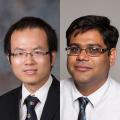 Bai Cui and
Prahalada Rao will be working with Tethon 3D to create a 3-D printer
designed specifically for ceramic and metal additive manufacturing after receiving a grant from
the Nebraska Department of Economic Development. (8/24/18)
Bai Cui and
Prahalada Rao will be working with Tethon 3D to create a 3-D printer
designed specifically for ceramic and metal additive manufacturing after receiving a grant from
the Nebraska Department of Economic Development. (8/24/18)
Alexander team works to mimic natural surfaces on metal
 Dennis
Alexander's research team is using lasers on metal surfaces to mimic evolutionary
biological properties (like shark skin, rose petals, beetles, and moth eyes) that can be used
for defense and industrial purposes. (7/29/18)
Dennis
Alexander's research team is using lasers on metal surfaces to mimic evolutionary
biological properties (like shark skin, rose petals, beetles, and moth eyes) that can be used
for defense and industrial purposes. (7/29/18)
Nebraska researchers working to 3-D print replacement tissues
 Prahalada Rao is part
of a team of researchers that are working from different angles to develop replacement tissues
for bodily injuries by 3-D printing them. Rao is working to perfect the 3-D printing process,
so that flawless parts can be produced every time, essential when creating a variety of parts -
from replacement knees to airplane turbines. (7/25/28)
Prahalada Rao is part
of a team of researchers that are working from different angles to develop replacement tissues
for bodily injuries by 3-D printing them. Rao is working to perfect the 3-D printing process,
so that flawless parts can be produced every time, essential when creating a variety of parts -
from replacement knees to airplane turbines. (7/25/28)
Formation of smallest ever skyrmions could improve digital memory
 Research led by David Sellmyer and Balamurugan Balasubramanian has resulted in the formation of
skyrmions that are seemingly the smallest possible size at only 13 nanometers wide. This new
finding could improve digital memory, including better energy efficiency, faster data
processing speeds, and longer lifespans for hard drives. (7/12/18)
Research led by David Sellmyer and Balamurugan Balasubramanian has resulted in the formation of
skyrmions that are seemingly the smallest possible size at only 13 nanometers wide. This new
finding could improve digital memory, including better energy efficiency, faster data
processing speeds, and longer lifespans for hard drives. (7/12/18)
New benefit of MXenes discovered
 Alexander
Sinitskii and colleagues have previously discovered a way to boost the electrical
conductivity of MXene material titanium carbide, and now they have shown that it is also the
stiffest 2-D nanomaterial produced by solution processing. (7/10/18)
Alexander
Sinitskii and colleagues have previously discovered a way to boost the electrical
conductivity of MXene material titanium carbide, and now they have shown that it is also the
stiffest 2-D nanomaterial produced by solution processing. (7/10/18)
Researchers record “molecular movie” of photochemical reaction
 Martin
Centurion and colleagues, including researchers from Stanford University and Europe, have
been able to precisely capture how the atomic nuclei and chemical bonds of a five-atom molecule
responded when struck by a laser. The study marks the culmination of a years-long effort to
advance the quality of “molecular movies” from that of a rudimentary stop-motion animation to a
high-definition motion picture. (7/9/18)
Martin
Centurion and colleagues, including researchers from Stanford University and Europe, have
been able to precisely capture how the atomic nuclei and chemical bonds of a five-atom molecule
responded when struck by a laser. The study marks the culmination of a years-long effort to
advance the quality of “molecular movies” from that of a rudimentary stop-motion animation to a
high-definition motion picture. (7/9/18)
Yang earns grant for converting feathers to fiber
 Yiqi Yang and
his team were awarded a $211,885 two-year pilot-scale production grant to continue their work
on developing a product made from certain fibers found in feathers and wool. Textiles made with
these fibers have increased performance properties, including moisture transmission, thermal
insulation, soft hand and luster. (6/25/18)
Yiqi Yang and
his team were awarded a $211,885 two-year pilot-scale production grant to continue their work
on developing a product made from certain fibers found in feathers and wool. Textiles made with
these fibers have increased performance properties, including moisture transmission, thermal
insulation, soft hand and luster. (6/25/18)
Xu receives Early Career Award from DoE
 Xiaoshan Xu was
awarded a 2018 Early Career Award from the Department of Energy for his work exploring how
combinations of thin materials may be used to control electrons’ spins. The award will provide
him with $150,000 in annual funding for the next five years. (6/22/18)
Xiaoshan Xu was
awarded a 2018 Early Career Award from the Department of Energy for his work exploring how
combinations of thin materials may be used to control electrons’ spins. The award will provide
him with $150,000 in annual funding for the next five years. (6/22/18)
Argyropoulos elevated to Senior Member of OSA
 Christos
Argyropoulos was recently elevated to the status of Senior Member of the Optical Society of
America (OSA). This distinction recognizes individuals for their experience and
accomplishments. Argyropoulos has published more than 120 technical papers, including five book
chapters. (6/21/18)
Christos
Argyropoulos was recently elevated to the status of Senior Member of the Optical Society of
America (OSA). This distinction recognizes individuals for their experience and
accomplishments. Argyropoulos has published more than 120 technical papers, including five book
chapters. (6/21/18)
Alexandrov & colleagues detail technique that could promote recycling of CO2
 Vitaly Alexandrov and colleagues have detailed a catalyst-based technique that can
double the amount of carbon dioxide that can be converted to ethylene, which is an essential
component of the world’s most common plastic, polyethylene. This process could promote the
recycling of CO2 as an alternative to fossil fuels when making plastic - helping to
offset the CO2 emissions that contribute to global climate change. (6/5/18)
Vitaly Alexandrov and colleagues have detailed a catalyst-based technique that can
double the amount of carbon dioxide that can be converted to ethylene, which is an essential
component of the world’s most common plastic, polyethylene. This process could promote the
recycling of CO2 as an alternative to fossil fuels when making plastic - helping to
offset the CO2 emissions that contribute to global climate change. (6/5/18)
Zeng team develops equation for designing clean-energy catalysts
 Xiao Cheng Zeng and
colleagues have identified previously overlooked factors critical to the performance of
single-atom catalysts and used them to create a simple equation that should allow researchers
to easily predict how the choice of atom and its surrounding material will affect catalytic
performance. (5/30/18)
Xiao Cheng Zeng and
colleagues have identified previously overlooked factors critical to the performance of
single-atom catalysts and used them to create a simple equation that should allow researchers
to easily predict how the choice of atom and its surrounding material will affect catalytic
performance. (5/30/18)
UNL home to new hybrid 3-D printers
 UNL’s Scott Engineering Center is now home to three unique hybrid 3-D printers that can
add and subtract materials to create complex designs. The Nebraska Engineering Additive
Technology (NEAT) Labs will provide researchers and students with endless possibilities for
projects affecting a plethora of fields and industries. Click here to learn more about the NEAT Labs
and the new instruments. (5/24/18)
UNL’s Scott Engineering Center is now home to three unique hybrid 3-D printers that can
add and subtract materials to create complex designs. The Nebraska Engineering Additive
Technology (NEAT) Labs will provide researchers and students with endless possibilities for
projects affecting a plethora of fields and industries. Click here to learn more about the NEAT Labs
and the new instruments. (5/24/18)
Sellmyer Honored at MRS Meeting
 The Spring MRS Meeting in Phoenix hosted a five-day Symposium
“Nanoscale Magnetic Structures and Materials,” which was organized by friends and colleagues of
David Sellmyer to celebrate his many achievements and
contributions to the field. Some 30 outstanding invited talks were presented by speakers
including Stuart Parkin (Halle), Claudia Felser (Dresden), Ivan Schuller (UCSD), Michael Coey
(Dublin), Sara Majetich (CMU), Shouheng Sun (Brown), J.P. Wang (MN), B. Koopmans (Eindhoven),
Y. Hou (Beijing), Arun Gupta (Alabama), Axel Hoffmann (ANL), and others. Current and former
Nebraska colleagues and speakers included: Ralph Skomski, Jeff Shield, George Hadjipanayis,
Toshi Matsui, Damien LeRoy, Yunlong Jin, and co-organizers J. Ping Liu and Hao Zeng. A banquet
on April 3 featured excellent food and several roasts with good-natured ridicule. (5/18/18)
The Spring MRS Meeting in Phoenix hosted a five-day Symposium
“Nanoscale Magnetic Structures and Materials,” which was organized by friends and colleagues of
David Sellmyer to celebrate his many achievements and
contributions to the field. Some 30 outstanding invited talks were presented by speakers
including Stuart Parkin (Halle), Claudia Felser (Dresden), Ivan Schuller (UCSD), Michael Coey
(Dublin), Sara Majetich (CMU), Shouheng Sun (Brown), J.P. Wang (MN), B. Koopmans (Eindhoven),
Y. Hou (Beijing), Arun Gupta (Alabama), Axel Hoffmann (ANL), and others. Current and former
Nebraska colleagues and speakers included: Ralph Skomski, Jeff Shield, George Hadjipanayis,
Toshi Matsui, Damien LeRoy, Yunlong Jin, and co-organizers J. Ping Liu and Hao Zeng. A banquet
on April 3 featured excellent food and several roasts with good-natured ridicule. (5/18/18)
Rajurkar awarded 2018 M. Eugene Merchant Manufacturing Medal
 The 2018 M. Eugene Merchant Manufacturing Medal of ASME/SME is
being awarded to K.P. Rajurkar “for pioneering contributions to
enhance the productivity of nontraditional machining processes used in automobile, aerospace
and medical device manufacturing, including electrical discharge machining and electrochemical
machining at macro, micro and nanoscales, through extensive research in process modeling and in
sensing and control techniques.” (5/4/18)
The 2018 M. Eugene Merchant Manufacturing Medal of ASME/SME is
being awarded to K.P. Rajurkar “for pioneering contributions to
enhance the productivity of nontraditional machining processes used in automobile, aerospace
and medical device manufacturing, including electrical discharge machining and electrochemical
machining at macro, micro and nanoscales, through extensive research in process modeling and in
sensing and control techniques.” (5/4/18)
Sellmyer book one of most downloaded in 2017
 The book
“Nanoscale
Magnetic Materials and Applications,” co-edited by David
Sellmyer, is among the top 25 percent of Springer downloaded books in 2017 with 10,628
chapter downloads last year. There have been a total of 56,676 chapter downloads since the
books publication in 2009. (5/1/18)
The book
“Nanoscale
Magnetic Materials and Applications,” co-edited by David
Sellmyer, is among the top 25 percent of Springer downloaded books in 2017 with 10,628
chapter downloads last year. There have been a total of 56,676 chapter downloads since the
books publication in 2009. (5/1/18)
Four NCMN Faculty granted promotions and/or tenure in 2018
 Congrats to the four NCMN faculty members who were honored on
April 24: Jian Wang (Mechanical & Materials Engineering),
promoted to full professor and granted tenure; Angela Pannier
(Biological Systems Engineering), promoted to full professor; and Sidy
Ndao and Sangjin Ryu (both in Mechanical & Materials
Engineering), promoted to associate professor and granted tenure. (4/24/18)
Congrats to the four NCMN faculty members who were honored on
April 24: Jian Wang (Mechanical & Materials Engineering),
promoted to full professor and granted tenure; Angela Pannier
(Biological Systems Engineering), promoted to full professor; and Sidy
Ndao and Sangjin Ryu (both in Mechanical & Materials
Engineering), promoted to associate professor and granted tenure. (4/24/18)
Dishari earns CAREER award for work on hydrogen-based fuel cells
 Shudipto Dishari earned a
five-year, nearly $600,000 CAREER award from the NSF to continue her work on reducing the cost
and improving the energy efficiency of hydrogen-based fuel cells and related energy conversion
and storage devices (e.g., lithium batteries, semiconductors, natural biochemical systems).
(4/15/18)
Shudipto Dishari earned a
five-year, nearly $600,000 CAREER award from the NSF to continue her work on reducing the cost
and improving the energy efficiency of hydrogen-based fuel cells and related energy conversion
and storage devices (e.g., lithium batteries, semiconductors, natural biochemical systems).
(4/15/18)
Rao earns NSF CAREER award to revolutionize smart additive manufacturing
 Prahalada Rao was awarded a five-year
$500,000 CAREER award from the National Science Foundation to continue his work on improving
the process of smart additive manufacturing (commonly referred to as 3-D printing) so that it
might consistently produce flawless metal parts, which could make it feasible to mass-produce
inexpensive metal parts where safety is paramount. (4/17/18)
Prahalada Rao was awarded a five-year
$500,000 CAREER award from the National Science Foundation to continue his work on improving
the process of smart additive manufacturing (commonly referred to as 3-D printing) so that it
might consistently produce flawless metal parts, which could make it feasible to mass-produce
inexpensive metal parts where safety is paramount. (4/17/18)
Iverson receives Holling Family Award for Teaching Excellence
 On March 2, Nicole Iverson received the Junior Faculty Teaching Excellence
Award, as part of the Holling Family Awards for Teaching Excellence that honor outstanding
teaching in the Institute of Agriculture and National Resources at UNL. Iverson is an assistant
professor in the Department of Biological Systems Engineering. (3/22/18)
On March 2, Nicole Iverson received the Junior Faculty Teaching Excellence
Award, as part of the Holling Family Awards for Teaching Excellence that honor outstanding
teaching in the Institute of Agriculture and National Resources at UNL. Iverson is an assistant
professor in the Department of Biological Systems Engineering. (3/22/18)
Tsymbal and colleagues observe nano phenomenon after nearly 15-year quest
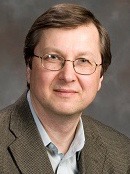
Two UNL researchers were part of an international team that ended a 15-year quest to observe a phenomenon that could help power a future generation of (smaller) electronics. In 2004, researchers observed a gas of electrons coursing two-dimensionally through a nano-sandwich made from oxides. This suggested that electric currents could be confined to smaller spaces, allowing electronic components to shrink in size. However the negatively charged electron also leaves behind a positively charged “hole” when ejecting from its orbit around an atom. The goal of researchers was to create and observe a 2-D hole gas that likewise acts as a source of electric current. (3/7/18)
7 NCMN Faculty Receive Parents’ Recognition Awards

Parents’ Recognition Awards are earned via nomination of faculty from the parents of their students. They provide positive feedback to faculty, encourage good student/faculty relationships, and provide recognition to outstanding educators. This years NCMN recipients are: Barry Cheung, Jian Zhang, Shireen Adenwalla, Eveline Baesu, Michael Sealy, Joseph Turner, and Angela Pannier. (2/8/18)
Researchers develop material gradient models that could strengthen polymer-based components

Mehrdad Negahban, Li Tan, and Wenlong Li - along with researchers from France and China - have developed a model that can map an optimal gradient onto a structure and calculate the resulting performance improvement. (2/6/18)
Zeng's research makes local news

Xiao Cheng Zeng's research on ice formation on certain surfaces was featured in the Lincoln Journal Star this week. (1/26/18)
Researchers make advancements in the field of soft robotics

Stephen Morin and his colleagues have developed a technique that helps rubber and plastic stick together, simplifying the processes that drive movement in soft robotics and enable chemical analyses on microscopic scales. (1/9/18)
Gu and colleagues seek to improve energy absorbing tubing to boost vehicle safety

Linxia Gu and colleagues are working to combine the best qualities of different designs of energy absorbing tubing that could improve the design of certain automobile components, helping to reduce injury risk in the event of a crash. (12/6/17)
NCMN High School Research Intern has work published

Cole Shank, a senior from Lincoln High who worked with a small team of researchers last summer during his internship with NCMN, had an article abstract of his results published as part of the 62nd Annual Conference on Magnetism and Magnetic Materials, recently held in Pittsburg. Shank said his work involved “making magnetic materials that are suitable for spintronics applications, which is possibly the next frontier of electronics.” Read the full story on Lincoln Public School's website. (12/4/17)
Berkowitz & Inter-University team receive DoD contract to research radiation exposure drug

David Berkowitz is part of an inter-university team, partnering with major pharmaceutical companies across the country, that has received a contract from the Department of Defense to help with finding drug solutions to treat the effects of radiation exposure. The group will receive $812K in the first year of funding and, depending on the initial results (which could open up new areas for research), could potentially expand into additional levels of funding, up to $8M. (11/30/17)
Yunlong Jin wins Best Poster Award at International Conference

Yunlong Jin, a Ph.D. student from Prof. David J. Sellmyer’s research group, won the Best Poster Award in 62nd International Conference on Magnetism and Magnetic Materials in Pittsburgh Nov. 6-10, 2017. Yunlong presented an unexpected large perpendicular magnetic anisotropy (PMA) in the epitaxial thin films of half-metallic full-Heusler Co2TiSi films. The experimental results show the potential of this material for spin valves or magnetic tunnel junctions as high-performance magnetic memory elements such as spin-transfer torque magnetoresistive RAM (ST-MRAM or STT-MRAM) as an alternative or a replacement to NOR flash. STT-MRAM uses the magnetism of electron spin to provide non-volatile properties in chips. Besides, it combines the speed of SRAM, the non-volatility of flash and virtually unlimited endurance. The half-metallic Co2TiSi with theoretical 100% spin polarization is ideal to generate the spin-polarized current to force a change of magnetization. PMA will increase the areal density of chips compared to in-plane magnetic anisotropy. This research is supported by NSF-DMREF: SusChEM (1436385), NSF-NNCI (1542182), and NCMN. Information can be found also in the MMM conference website. (11/17/17)
Berkowitz team develops new amino acid that can inactivate certain enzymes

David Berkowitz and colleagues have synthesized a new class of amino acid that can inactivate vitamin B6-fueled enzymes, or PLP enzymes, which are associated with a range of health issues, including Parkinson’s disease and epilepsy. (11/7/17)
New nano-ribbons made of graphene give gas sensors unprecedented sensitivity

Alexander Sinitskii and colleagues have developed a new form of nano-ribbon made from graphene that, when integrated into the circuitry of a gas sensor, responded about 100 times more sensitively to molecules than sensors with even the best-performing carbon-based materials. (10/20/17)
Zeng study suggests water-repellant coating/surfaces make ice removal easy

Xiao Cheng Zeng and colleagues have found that ice forms differently on absorbent vs. water-repellent surfaces. Ice that forms on the latter will freeze upward, with only a small portion of the base sticking to the surface, making it easier to remove. (10/18/17)
Sangjin Ryu to give SciPop talk on Miyazaki’s flying machines

Sangjin Ryu will discuss the aerodynamics of the many flying machines featured in Hayao Miyazaki’s popular anime movies. The talk will take place on October 18 at 7 p.m. in the Adele Hall Learning Commons. (10/10/17)
Pannier earns NIH award to enhance gene therapy

Angela Pannier has received an NIH New Innovator Award to develop novel methods that improve the use of adult stem cells in gene therapy. Pannier is investigating nonviral delivery methods to introduce therapeutic genes into stem cells and how to improve the gene uptake of these methods. (10/5/17)
Nebraska-led website offers brief highlights of condensed-matter physics

Shireen Adenwalla and Jocelyn Bosley recently received another round of funding from the National Science Foundation for their website Funsize Physics, which offers brief, easy-to-understand highlights of condensed-matter physics research from NSF-funded scientists from across the country. (9/7/17)
Yang & colleagues find way to improve bio-plastic properties

Yiqi Yang and colleagues have found that increasing the temperature of bio-plastic fibers to several hundred degrees Fahrenheit, then allowing them to slowly cool, greatly improved bio-plastic’s resistance to heat and moisture. This method can also make commercial manufacturing of bio-plastic’s possible. (8/31/17)
NanoArt on display in Nebraska East Union

For the month of August, NanoArt created by UNL STEM students will be on display on the third floor of the Nebraska East Union. Read more at the Daily Nebraskan. (8/21/17)
Yiqi Yang co-edits book

Yiqi Yang and colleague Helan Xu served as co-editors for the book Porous Lightweight Composites Reinforced with Fibrous Structures. The publication offers a comprehensive overview of the raw materials, processing technologies, performance properties and applications of lightweight composites. (8/11/17)
Sorghum husks potential use as wool dye

A study by Yiqi Yang and Chinese colleagues recently found that the husks of sorghum plants could potentially be used as a fade-resistant, UV-shielding dye for wool fabrics. (8/7/17)
Metal-free nanoparticle could expand MRI use, tumor detection

A new metal-free nanoparticle developed by Andrzej Rajca and colleagues at MIT could help circumvent health- and age- related barriers to the metal-containing agents sometimes used to improve the color contrast and diagnostic value of MRIs. (8/3/17)
Dr. Sellmyer co-edits book

Dr. David Sellmyer acted as a co-editor for a recently published book titled, “Magnetic Nanomaterials: Fundamentals, Synthesis and Applications.” The book outlines how the latest developments in magnetic nanoparticles and nanomaterials are advancing the fields of biomedicine, energy storage, water treatment, and more. Learn more about the book here (7/28/17)
Controlling elasticity with magnetism
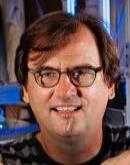
Christian Binek has found that, under certain conditions, the magnetic properties of a material can predict the relationship between its elasticity and temperature. You can read more about his findings here (7/19/17)
Milestone in effort to treat bone disorders
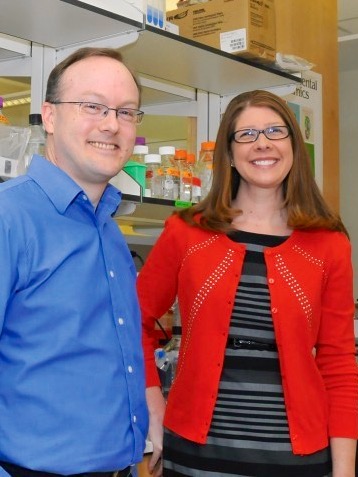
A recent study by Pannier and colleagues from the University of Nebraska-Lincoln and University of Nebraska Medical Center has reported progress toward the bioengineering of cartilage that could help treat disorders known to disrupt the normal development of bones. (7/19/17)
Discovery Could Increase Functionality of Electronics

Xia Hong, Stephen Ducharme, and colleagues have demonstrated a method for altering the properties of a nanoscopic material, pointing the way toward merging several functions of modern electronics into a single component. (6/7/17)
Zeng Receives Royal Society of Chemistry Award

The Royal Society of Chemistry has awarded Xiao Cheng Zeng its Surfaces and Interfaces Award for 2017. The annual award honors outstanding and innovative research on the behavior of chemical systems at surfaces or interfaces. (5/9/17)
Zeng & Team Publish on Porous Materials
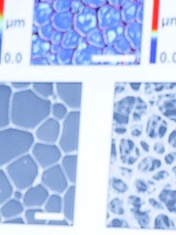
Xiao Cheng Zeng and colleagues published an article May 2 in Nature Communications. They learned that ions can be used to fabricate new two- and three-dimensional structures on a wide range of other host materials, which are suitable for organic electronics, catalysis and bioengineering. (5/2/17)
Argyropoulos Receives Fellowship and Award

Christos Argyropoulos has been chosen an Office of Naval Research Fellow and will spend 10 weeks this summer at the NRL in Washington, D.C. He has also recently received the Young Scientist Award from the International Union of Radio Science to attend their General Assembly in Montreal, Canada from August 19-26. (4/27/17)
NCMN Members Earn Promotion, Tenure
Three NCMN faculty members are earning promotions. Promoted to full professor: Shannon Bartelt-Hunt and Kirill Belashchenko. Promoted to associate professor and granted tenure: Jian Zhang. Congratulations! (4/24/17)
Huang & Team Publish Perovskite Research

Jinsong Huang and team authored a study in Nature Photonics April 17. The study demonstrates a technique for bonding single crystals of perovskite onto a range of foundational materials that include silicon. (4/21/17)
Thermal Diode Allows Heat as Energy Source

Sidy Ndao and grad student Mahmoud Elzouka have created a thermal diode that will allow computers to use heat as an energy source to allow their operation in ultra-high temperatures. Their findings were published in Scientific Reports. (4/17/17)
Perovskite Holds Potential for Solar Energy

Xiao Cheng Zeng and team published the cover article of the April 5 issue of Advanced Energy Materials. The illustration shows the molecular structure of an organic-inorganic hybrid perovskite material that holds potential for the generation of solar energy. The work grew out of collaboration with Jinsong Huang. (4/14/17)
Three NCMN Faculty Earn Teaching Awards
Three NCMN faculty have earned College Distinguished Teaching Awards, which recognize consistent excellence in teaching. Recipients are Yusong Li, Alexander Sinitskii, and Joseph Turner. (4/11/17)
Particle Offers Promise for Vaccine Pill

Angela Pannier and colleagues have demonstrated that nesting a specialized nanoparticle inside a microparticle could protect engineered genes or virus-derived DNA against the rigors of the stomach and ensure safe passage to the intestine. (4/11/17)
Lu Earns ORCA Award

Yongfeng Lu received the Outstanding Research and Creative Activity award for his research in laser-based material processing, characterization and imaging. The ORCA recognizes faculty for outstanding research or creative activity of national or international significance. (4/5/17)
Pannier Earns Mentor Award

Angela Pannier was awarded UNL's Outstanding Undergraduate Research Mentor Award, which recognizes an individual who has demonstrated excellence in mentoring and supporting undergraduate researchers. (4/5/17)
Sabirianov, Zeng Publish in Nature

Renat Sabirianov, Hao Zeng, and colleagues have published an article in Nature entitled, "Deciphering chemical order/disorder and material properties at the single-atom level." Sabirianov is an NCMN member at UNO and Zeng obtained his Ph.D. under David Sellmyer. (4/4/17)
Zeng Study Supports New Forms of Water

As reported in the Proceedings of the National Academy of Sciences, Xiao Cheng Zeng and colleagues have proposed that both low- and high-density forms of liquid water could emerge from housing it in a carbon nanotube. (4/3/17)
Gay Earns Named Professorship
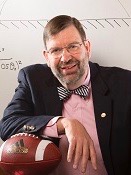
Timothy Gay has been named a Willa Cather Professor. The professorships were established in 2001 to recognize faculty members with the rank of full professor who have established exceptional records of distinguished scholarship or creative activity. (3/30/17)
Lai Receives ACS Volunteer Award
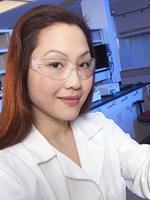
Rebecca Lai received the Local Section Outreach Volunteer of the Year Award from the American Chemical Society’s Committee on Community Activities. The committee noted her "innovative outreach [which] allows students hands-on activities." (3/17/17)
2016 Outreach Newsletter Published

The 2016 issue of the nano outreach newsletter is now available online. The newsletter covers UNL nano outreach activities over the past year. (3/2/17)
Enders, Dowben Team Creates 2D Material

Axel Enders, Peter Dowben, and team have developed a new 2D material, Monolayer Hexagonal Boron-Carbon-Nitrogen (h-BCN), with potential for developments in ultrathin technologies. The results were published in ACS Nano and covered by Phys.org. (2/16/17)
NCMN Members Receive UNL Parents Award
Srivatsan Kidambi, Mehrdad Negahban, and Michael Sealy received the UNL Parents Recognition Award. The annual award is earned through nominations made from parents of UNL students. (2/10/17)
Sinitskii & Team Boost Performance of Nanomaterial

Alexander Sinitskii, 2015 NCMN graduate fellow Alexey Lipatov, and team have published their findings on MXenes in Advanced Energy Materials. MXenes are a family of nanomaterials which have shown promise for storing energy, purifying water and protecting against electromagnetic interference. (2/6/17)
Sinitskii Fabricates Nanoribbon Computer Chips

The January issue of Solid State Technology: Insights for Electronics Manufacturing covered recent advances in fabricating graphene nanoribbons for use as computer chips. Alexander Sinitskii is a leader in the research effort. (2/3/17)
Sellmyer Guest Curator at Sheldon

David Sellmyer was an invited guest curator for Sheldon's exhibit "15 Photographs, 15 Curators." The guest curators picked a single image that generated a personal response out of nearly 3,000 photographs. Sellmyer chose a photo by Robert Morris Cohen because of its similarity to nanostructured materials. (2/1/17)
Zeng Cover Article Trio

Research by Xiao Cheng Zeng and colleagues was featured as the cover article of Nanoscale Horizons, the cover article on Advanced Energy Materials, and the cover article on Journal of the American Chemical Society. (1/20/17)
Woollam Receives Bunshah Award

John Woollam has been chosen as the recipient of the 2017 R.F. Bunshah Award. He will present the Honorary Lecture at the 2017 International Conference on Metallurgical Coatings and Thin Films (ICMCTF). (1/20/17)
Cui & Wang Improve Metal Durability

Bai Cui and Jian Wang are developing a variety of “radiation-tolerant” materials that are self-healing, and that could improve metal durability. (1/19/17)
Morin Studies Stretchable Surfaces

Stephen Morin and colleagues have demonstrated how the chemistry of stretchable surfaces can affect their interactions with microscopic particles – and enhance or streamline processes usually conducted on rigid foundations. Findings were published in Small and Chemistry of Materials. (1/3/17)
Gu Earns ASME Fellowship

Linxia Gu has earned a fellowship of the American Society of Mechanical Engineers. A fellow has attained a membership grade of distinction, is a corporate member, is responsible for significant engineering achievements and has at least 10 years of active practice and corporate membership in ASME. (12/2/16)
Zeng Explores Hydrophobicity of Proteins

Xiao Cheng Zeng and colleagues recently published on the molecular hydrophobicity of amino acid chains in the Proceedings of the National Academy of Sciences. This could help engineers measure surface contact angles. Zeng also recently published an article in Nature Communications on gold clusters. (12/13/16)
Gay Elected APS Speaker of the Council

Timothy Gay has been elected Speaker of the Council for the American Physical Society. Gay will serve as Speaker-Elect in 2017 and as Speaker in 2018. The APS Speaker of the Council presides over the Council of Representatives and serves on the Board of Directors and Board Executive Committee. (11/28/16)
Huang Among Most Cited Researchers

Jinsong Huang was included in the "Highly Cited Researchers 2016" list, which recognizes researchers whose peer-reviewed papers have been cited frequently in academic literature. The list was compiled by Clarivate Analytics, formerly the Intellectual Property and Science division of Thomas Reuters. (11/28/16)
Dussault Named AAAS Fellow

Patrick Dussault has been named an AAAS fellow for distinguished contributions to the chemistry of organic peroxides, including peroxide natural product synthesis, mechanistic studies and innovative peroxide-mediated oxidation transformations. (11/23/16)
New NCMN Member

NCMN welcomes new faculty member Nicole Iverson, assistant professor in the Department of Biological Systems Engineering. (11/22/16)
New NCMN Member

NCMN welcomes new faculty member Shannon Bartelt-Hunt, associate professor and Robert B. Daugherty Water for Food Fellow in the Department of Civil Engineering. (11/21/16)
NanoArt at Nebraska Innovation Campus

NanoArt is on display at Nebraska Innovation Campus through November 30, and is open to the public 8 a.m.-5 p.m. Monday through Friday. The image at left, "Bee Family," is by H. F. Haghshenas & M. Khedmati and is the winner of NCMN's 2016 NanoArt competition. (11/7/16)
Powerful Underwater Microphone Uses Silver Nanoparticles

Li Tan, Qin Zhou, Steve Ducharme, and colleages have developed an underwater microphone with 6,000 times greater sensitivity to low-frequency sound waves by embedding a network of silver nanoparticles in hydrogel and placing that gel between two electrodes, as reported in Nature Communications. (11/7/16)
Huang Receives Breakthrough of the Year Award

Jinsong Huang and postdocs Haotong Wei and Wei Wei were awarded the NUtech Ventures Breakthrough of the Year Award for developing improved X-ray detectors based on a perovskite material that are expected to reduce the X-ray dose required for medical imaging, security, and quality control. (11/2/16)
Experiment Sent to ISS

An experiment led by Peter Dowben was carried to the International Space Station on October 17. Nebraska's contribution to the ISS cargo resupply mission a multi-element neutron detector system that can track solar neutron production in a specific range of energies. (10/28/16)
Monolith Materials to use NCMN Facilities

Monolith Materials will be using NCMN's facilities for their industrial efforts. NCMN director David Sellmyer attended the October 20 groundbreaking for their new plant, which was covered by the Lincoln Journal Star. (10/24/16)
Huang Protects Solar Cells from Moisture

A team led by Jinsong Huang has detailed an approach that can buffer perovskite against moisture without sapping its ability to convert sunlight into electricity, as reported in Nature Communications. (10/20/16)
2016 Newsletter Published

The fall 2016 issue of Interfaces, the newsletter of NCMN, is available online. Articles cover the NNI Strategic Plan, NCMN facilities, new faculty members, student degrees, outreach programs, and more. (10/14/16)
New NCMN Member

NCMN welcomes new faculty member Ashraf Hassan, research assistant professor in the Department of Civil Engineering. (10/13/16)
Kim and Turner Explore Alternative Concrete Materials

Yong-Rak Kim, Joseph Turner, and colleagues recently earned a two-year NSF grant that will enable them to explore the performance and durability of concrete made of alternative binding and recycled materials, with the aim of developing better versions. (10/3/16)
UNL Alum Awarded MacArthur "Genius" Award

Rebecca Richards-Kortum (BS Physics UNL, PhD Physics MIT), who started as an undergrad in David Sellmyer's lab, was announced a 2016 MacArthur Fellow. Noted was her commitment to "improving access to quality health care for all the world's people" and "training and inspiring the next generation of engineers and scientists" to address global challenges. (9/23/16)
Berkowitz Named to Organic Reactions Board of Editors

David Berkowitz has been named to the Board of Editors for Organic Reactions. The series, which started in 1942, serves as a key reference for organic chemistry literature. (9/23/16)
Layered Nanosphere Shows Biomedical Promise

Xiao Cheng Zeng and colleagues have illustrated that a concentration of short molecular chains will assemble into a layered sphere known as a liposome, which could more precisely release therapeutic drugs or genes as the body peels it away. (9/20/16)
UNL National Ads Feature Huang Solar Research

Jinsong Huang's solar cell research is one of the highlighted stories in new UNL national television commercials, which are aimed at promoting recruitment and reputation. (9/9/16)
New NCMN Member

NCMN welcomes new faculty member Shudipto Dishari, assistant professor in the Department of Chemical and Biomolecular Engineering. (9/7/16)
New NCMN Member

NCMN welcomes new faculty member Siamak Nejati, assistant professor in the Department of Chemical and Biomolecular Engineering. (9/7/16)
Takacs Directs New UNL Biomolecular Center

James Takacs is director of UNL's new Center for Integrated Biomolecular Communication, established by an $11.3-million grant from the National Institutes of Health for the purpose of investigating cellular-level miscommunications that contribute to complex diseases such as cancer, diabetes and chronic liver disease. (8/30/16)
Symposium Features NCMN Student Research

The Nebraska Summer Research Symposium will take place in the Nebraska Union on August 10. NCMN summer student researchers will join others in presenting their research in a poster session from 1-3 pm. (8/9/16)
New Materials Show Promise for Clean Energy

Jian Zhang and colleagues have synthesized new materials that show promise for energy applications aimed at reducing greenhouse gas emissions. The materials belong to an emerging family of materials called metal-organic frameworks, or MOFs, which feature metallic atom-containing clusters that are linked by carbon atoms. (7/14/16)
Lu Selected for Schawlow Award

Yongfeng Lu has been selected as the 2016 Arthur L. Schawlow Award recipient. The award will recognize Lu’s record of laser industry innovation and his significant contributions to basic and applied research in the fields of laser science and electrical engineering. (7/1/16)
Song Research on Back Cover
Jingfeng Song's latest paper will be featured on the back cover an upcoming issue of the Journal of Materials Chemistry C. It is entitled, "Ferroelectric polymer nanopillars on flexible substrates by reverse nanoimprint lithography." This work is the capstone of his Ph.D. dissertation work, completed in May under his advisor Stephen Ducharme. (6/24/16)
UNL Team Bolsters Digital Memory
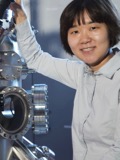
Research by Xia Hong, Jeffrey Shield, Evgeny Y. Tsymbal, and colleagues, has bolstered an emerging form of digital memory, as published in Physical Review Letters. The material, lanthanum strontium manganite, features multiple properties that make it an appealing candidate for digital technologies. (6/24/16)
Sellmyer Book One of Top Springer eBooks

Nanoscale Magnetic Materials and Applications, co-edited by David Sellmyer, has had a total of 36,630 chapter downloads since 2009. This makes it one of the top 25% most downloaded eBooks in the relevant Springer eBook collection in 2015. (6/22/16)
Ndao STEM Camp Media Coverage
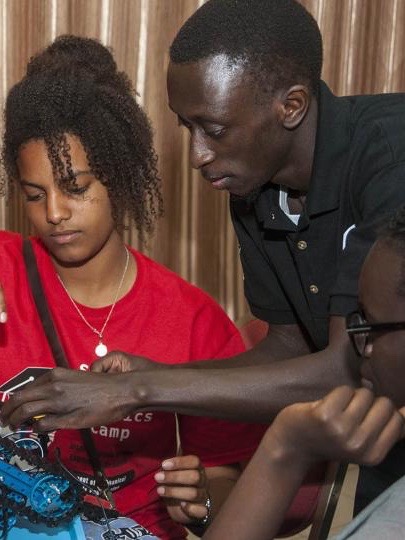
Sidy Ndao's STEM camp that he conducts in his native Senegal has received national attention. It was covered in an article in the May 30 print edition of The New York Times, and is published on their website. (6/3/15)
Hong Earns Early Career Award

Xia Hong is one of the US DOE's 49 recipients of the Early Career Award, totaling $750,262 over the next five years. This will allow her to upgrade scanning probe microscopy equipment and add junior researchers to her lab. Those investments will help Hong pursue nanoscale control of extremely thin films that feature ferroelectricity. (5/27/16)
Gruverman Elected JSAP Fellow

Alexei Gruverman has been elected an international fellow of the Japan Society of Applied Physics (JSAP). He will give a talk during the awards ceremony at the 2016 JSAP Autumn Meeting in Japan. Gruverman has been involved in nanoscience research in Japan since the early 1990s. (5/25/16)
Tsymbal Research on PRL Cover

The paper “Enhanced Tunneling Electroresistance in Ferroelectric Tunnel Junctions due to the Reversible Metallization of the Barrier,” by Xiaohui Liu, J. D. Burton, and Evgeny Y. Tsymbal, was published in Physical Review Letters and featured on its cover page. (5/13/16)
Discovery Enhances Polymer Materials
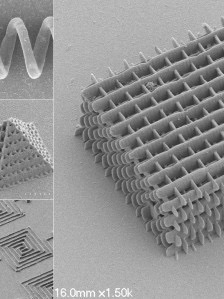
Yongfeng Lu, Yunshen Zhou, and colleagues have used thiol compounds to create a stronger polymer composite. The improvements translated to better electrical performance. (5/3/16)
NCMN Members Earn Promotion, Tenure
Six NCMN faculty members are earning promotions. Promoted to full professor: Shireen Adenwalla, and Jinsong Huang. Promoted to associate professor and granted tenure: Xia Hong, Srivatsan Kidambi, and Alexander Sinitskii. Congratulations! (4/25/16)
Negahban Awarded Honorary Doctorate

Mehrdad Negahban was awarded an honorary doctorate from the University of Rouen, with which he and the College of Engineering have had a long partnership. Several other NCMN faculty have taught at Rouen, including Joe Turner, Li Tan, Lucia Fernandez-Ballester and Jeff Shield. (4/22/16)
Zeng Study Details Acid Formation

Xiao Cheng Zeng and colleagues have detailed the formation of nitrous acid in the atmosphere. The study was published in April 11 in the Proceedings of the National Academy of Sciences. (4/12/16)
Self-Assembly of Nanocrystals Captured

A research team led by Peter and Eli Sutter has become the first to directly image the self-assembly of nanocrystals in the liquid environments that foster it. The research was published in an April 4 article in Nature Communications. (4/4/16)
Huang Improves X-Ray Detection

In a March 21 study published in Nature Photonics, Jinsong Huang and colleagues reveal a crystalline material that is four times more sensitive to X-rays than leading commercial detectors. The material, methylammonium lead tribromide, can detect an X-ray dose about 11 times lower than that required for many medical applications. (3/21/16)
Bobaru Publishes Invited Study on Fracturing

Florin Bobaru and grad student Guanfeng Zhang were invited to publish a study in the 50th-anniversary issue of the International Journal of Fracture. The study helps resolve the long-standing question of how cracks branch and propagate through brittle materials such as glass. (3/18/16)
New NCMN Member

NCMN welcomes new faculty member Jiong Hu, assistant professor in the Geotechnical and Materials Engineering division of the Department of Civil Engineering. (3/16/16)
Sellmyer Team Finds Magnetism in Nanoscale Compound

A team led by David Sellmyer and Bhaskar Das has discovered that a compound called manganese silicide takes on unexpected properties when reduced down to the nanoscale. (3/15/16)
Zhang Career Award Develops Cleaner Fuels

Jian Zhang is working to develop an organic-based catalyst that uses the sun’s energy to facilitate chemical reactions with the help of a five-year, $527,154 Faculty Early Career Development Program Award from the National Science Foundation. (3/14/16)
Berkowitz Advances Stroke Treatment

David Berkowitz and colleagues have developed a molecule that can inhibit an enzyme linked with the onset of stroke. They modeled their inhibitor on a naturally occurring molecule produced by the CBS enzyme, tailoring the molecule’s structure to improve its performance. (3/9/16)
Morin CAREER Award Expands Hybrid Materials Research

Stephen Morin will expand his efforts to seamlessly combine hard and soft materials with the help of a five-year, $649,474 Faculty Early Career Development Program Award from the National Science Foundation. (3/7/16)
Two NCMN Members Receive CAREER Awards
Stephen Morin earned $649,474 for Morphological Control of Crystalline Materials Using Deformations of Elastomeric Substrates and Fluid Flow for the Bottom-up Fabrication of Hybrid Materials. Jian Zhang earned $527,154 for Tuning Photoredox Properties of Carbazolic Porous Organic Frameworks for Visible-Light-Mediated Catalysis. (2/23/16)
Binek Elected APS GMAG Officer

Christian Binek has been elected as an executive committee member-at-large of the American Physics Society's Topical Group on Magnetism and its Applications (GMAG). (2/19/16)
Metal-Detecting Biosensors under Development

A gold sensor is the latest in a series of metal-detecting biosensors under development by Rebecca Lai. Fabricated on paper strips about the size of a litmus strip, Lai’s sensors are designed to be inexpensive, portable, and reusable. (2/17/16)
New Form of Ice Predicted
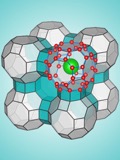
Xiao Cheng Zeng and colleagues have predicted a new molecular form of ice about 25 percent less dense than the current record-low form. It would be the 18th known crystalline form of water. The research article appeared in Science Advances, with coverage in several news outlets, including the Daily Mail, Science Daily, and Science Alert. (2/12/16)
Zeng Study of Ammonium Bisulfate Highlighted
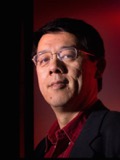
A new study by Xiao Cheng Zeng and Joseph Francisco, dean of the College of Arts and Sciences, was highlighted in the “Concentrates” section of Chemical & Engineering News. The study reveals a reaction among water, ammonia and sulfur trioxide that may lead to the formation of ammonium bisulfate, which contributes to the formation of aerosols. (2/12/16)
NCMN Members Receive UNL Parents Award
David Berkowitz and Eveline Baesu received the UNL Parents Recognition Award. The annual award is earned through nominations made from parents of UNL students. (2/11/16)
New NCMN Member

NCMN welcomes new faculty member Sangjin Ryu, assistant professor in the Department of Mechanical & Materials Engineering. (2/9/16)
New Materials Become Reflective When Stretched
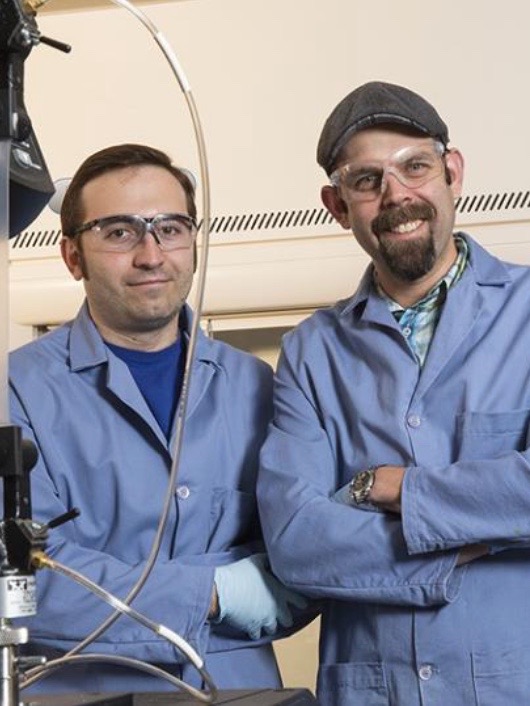
Christos Argyropoulos and Stephen Morin, with graduate student Jay Taylor, have developed a method for crafting elastic materials that feature a matte appearance when relaxed but become highly reflective when stretched. (2/2/16)
Sutter Named an MRS Meeting Chair

Eli Sutter has been selected as one of the chairs of the 2017 MRS spring meeting, as reported in the January 2016 issue of the MRS Bulletin and on UNL Today. (1/21/16)
Huang on Perovskite-based Solar Cells

Jinsong Huang published an article in the inaugural issue of Nature Energy about an innovation that could help make perovskite-based solar cells more competitive with those made from silicon. (1/13/16)
2015
- Li and Zeng Inaugural Members of Chemistry Cluster
- Kidambi Coauthors Study Revealing Nanoparticle Damage
- Berkowitz and Rajca Named AAAS Fellows
- NCMN Collaboration Leads to National Student Research Award
- Kidambi Uses Polymer Film to Mimic Tumors
- Undergrad Wins Third Place at Nano Conference
- NCMN Members on Speakers Bureau
- UNL Alum Speeds Cancer Diagnosis
- Kidambi Wins Emerging Innovator Award
- Ndao Brings STEM Camps to Senegal
- NCMN Earns $3.5-million NSF Grant
- Gruverman and Tsymbal Identify Ferroelectric Material
- Xu Earns NSF Early Career Award
- Huang Engineers Light-Detecting Crystals
- Huang Leads Part of Solar Cell Project
- Zeng Explains Nanotube Preference
- Morin Studies Chemical Patterns
- Magnetic Threshold of Ultra-Thin Material Explained
- Kidambi Studies Brain Functioning
- Symposium Features NCMN Student Research
- Ducharme Gives Talk on Nanoscience and Art
- Huang Improves Solar Cell Efficiency
- Berkowitz Leads Catalyst Discovery
- Zeng and Sinitskii Publish on 2-D Materials
- Pannier to Speak at Congressional Briefing
- Schubert Awarded Honorary Doctorate
- Gu Leads Study Examining Blast Waves
- Sinitskii Earns CAREER Award
- Dussault Earns Grant to Study Ethers
- Nano Outreach at Science Olympiad
- Kovalev Earns Early Career Award
- NCMN to be Involved in Science Olympiad
- Binek Promoted to Full Professor
- Li Promoted to Associate Professor
- Zeng Reveals New Arrangements of Gold Cluster
- NSF Grant Won for MRSEC
- Structure Replicates Nature's Camouflage
- Team Spotlights Molecular Discoveries
- Al-Omari Receives Distinguished Arab Researcher Award
- Rajca Receives ORCA Award
- NanoDays to be held at Gateway Mall
- Bobaru Crafts Model that Predicts Corrosion
- BiMagno and Huang Earn Named Professorship
- Customized Nanoparticles Could Better Transport Drugs
- Zeng's Research Featured on Journal Cover
- Sinitskii and Franke-Schubert Publish on Graphene
- Yang to Speak on Textiles
- Dowben Contributes to Solar Cell Research
- Huang Discovers Solar Cell Material's Potential
- Gay Comments on NFL's "Deflate-Gate"
- Berkowitz Appointed Interim NSF Chemistry Director
2014
- Woollam Named Inventor Fellow
- Solar Cell Technology Improved
- Digital Memory Technology Improved
- Skomski Article in Journal Small
- Grant Earned for Solar Cells
- Research Supports DNA Hypothesis
- Sensor Could Improve Breast Cancer Detection
- Team to Prepare Material for Space Flight
- Cornelius Earns NSF Grant
- Zeng Article on Journal Cover
- Zeng Article in Chemistry World
- Ducharme Publishes Book
- Yang Develops Novel Mesh
- Ndao Student Receives Fellowship
- DiMagno's Startup Wins Grant
- NanoDays Held at Gateway Mall
- Gay Testifies Before House Subcommittee
- Sinitskii Team Solves Graphene Challenges
- Saturday Science Program Held
- Huang Thin Film Research Gains Momentum
2013
- Dzenis Publishes on Graphene and Nanofibers
- NCMN Graduate Research Fellows Announced
- Sellmyer Named AAAS Fellow
- Zeng Named to Royal Society of Chemistry
- Sellmyer and Team Develop Hybrid Nanomagnetic Material
- NCMN Members Among UNL Research Fellows
- Brand Named ELATE Fellow
- Lu Graduate Working for Department of Defense
- Zeng Research on Journal Cover
- Nano on NOVA's "Making Stuff"
- Zeng Research on Journal Cover
- Huang Develops Photodetector
- Pannier Develops Gene Delivery Tool
- UNL Physicists Lead Research Collaboration
- NanoDays to be Held April 6
- UNL Team Develops Nanofibers
- Gu Earns CAREER Award
2012
- More Zeng Nebraska Ice Discoveries
- Nanoscience in Nature Exhibit Opens
- Redepenning to give Nano Café Talk
- Research Fair Ends with Nano Celebration
- Voelte-Keegan Building Dedication
- ktU" New Edition of Skomski Book
- Nano Art Awards Given
- NanoDays to be Held March 24
- Tsymbal Book Published
- Schubert Elected Physics Fellow